|
1865 -
RECONSTRUCTION & MAGBEE AFTER THE CIVIL WAR
In 1862, Magbee's
term in the Florida Senate was cut short.
At Gov. Milton’s request, Attorney General Galbraith had
issued an opinion on the 1861 Florida Confederate constitution
which was approved by that year’s convention. According to
Galbraith, all senators, even those elected like Magbee to
four-year terms in 1860, would have their terms expire in October
1862 and would have to run for re-election. Soon after the
word arrived in South Florida, James D. Green of Manatee County
announced his candidacy. Samuel B. Todd of Tampa entered the
contest along with Gen. Joseph M. Taylor of Hernando County.
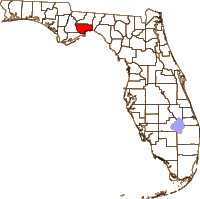
Magbee decided not to run, but to contest the
election. Green, a Unionist who was "a particular friend and correspondent"
of Magbee, soon withdrew, possibly at Magbee’s urging.
On
October 6, Todd out-polled Gen. Joseph Taylor in Hillsborough but Taylor
prevailed in the rest of the district and went on to win the election.
Magbee was furious. He returned to Tampa, sold his belongings and
moved with his newly wed bride, his 2nd wife, Julia A. Henderson, to Wakulla County (located on the south border of Leon
County, on the Gulf of Mexico.)
Magbee waited out the Civil War at this new home in the town of
Newport, Wakulla Co., living the life
of a planter with his wife and seven slaves.
1865 - June 13 - Magbee signs Oath
of Allegiance to the U.S.
When the Civil War was over, Magbee signed an oath of allegiance to the
United States on June 13, 1865. He was 43 years old.
I hereby solemnly swear that I will bear full faith and true
allegiance to the United States of America. That I will support
and maintain her against all her enemies. That I hereby renounce
all allegiance to all other or foreign powers or governments.
That I will support the Constitution of the United States so
help me God.
Restoring the Union
From Florida Memory, State
Library & Archives of Florida
|
|
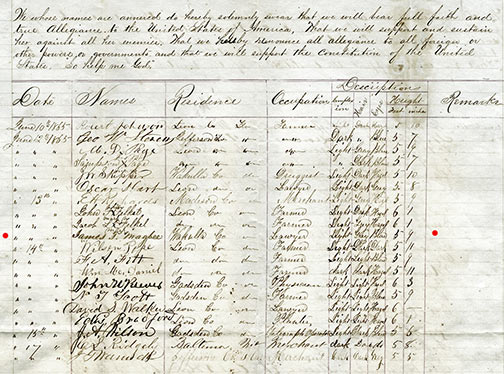 |
|
Click to see
this page larger.
|
Restoring
the Union following the destruction of the Civil War proved
to be an enormous task. Several questions emerged in the
wake of General Robert E. Lee’s surrender at Appomattox
Courthouse in April 1865; namely, the pace and scope of
reintegrating former rebels and Confederate states back into
the Union, rebuilding the southern economy, and the futures
of millions of newly freed slaves.
President
Abraham Lincoln’s desire to enact swift Reconstruction
clashed with the so-called Radical Republicans in Congress
who wanted to punish the South. President Andrew Johnson,
who took office after Lincoln’s assassination on April 14,
1865, tried to follow Lincoln’s general approach to
Reconstruction and was eventually impeached for it (and
acquitted.)
Part of the plan implemented by Johnson included granting
amnesty to some former Confederates who pledged an oath of
allegiance to the United States.
The
only known physical description of James T. Magbee
These oaths
of allegiance were entered in Leon County between May 31 and
June 17, 1865. The signees, although primarily from Northern
Florida, represented several Florida counties and a few
different states. These rosters include information
otherwise available in census or service records, such as
date, name, residence and occupation. Of particular interest
are Pages 5 and 6, which also include columns for
complexion, hair and eye color, and height.

James T.
Magbee of Wakulla Co, Lawyer, Light complexion, grey hair,
blue eyes, 5 ft. 9 in. tall
See the entire document and transcription. |
|
|
|
1865 -
July 15 - Troops arrive in Tampa to enforce reconstruction law
Federal troops of the 2nd U.S. Colored Infantry
Regiment arrived in Tampa to occupy the fort and the town as
part of Reconstruction. They would remain until August 1869.
|
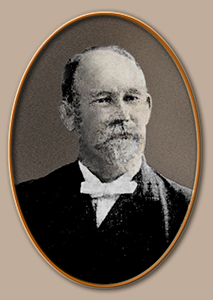 By James
McKay, Jr. in "Reminiscences
- History of Tampa in the Olden Days" Dec. 18,
1923 By James
McKay, Jr. in "Reminiscences
- History of Tampa in the Olden Days" Dec. 18,
1923
After the close of the war we all returned to our homes,
which we found in most instances in a dilapidated condition.
Tampa was a hard-looking place. Houses were in bad order.
Streets and lots were grown up mostly with weeds and the
outlook certainly was not very encouraging. To make matters
worse two companies of negro soldiers were sent to garrison
the place. White officers commanded them. It was not long
before the troops became overbearing and in some instances
threatened arrests of our citizens.
I was one that was to be brought before a military court,
for the destruction of papers and documents. Getting uneasy
over the many reports coming in, I with my brother Donald,
mounted our horses and laid out in the woods for six weeks.
The excited condition of the country and activity of the
officers at this place being reported to Washington by a
revenue officer, a special agent was sent here to
investigate with authority to act and he soon had matters
straightened out.
I received notice from my father to report to the commanding
officer in the garrison before stopping anywhere, which I
did and was given a paper stating that I was not to be
molested only on order from Washington. Shortly after this
event the negro soldiers were removed and white troops of
the regular army went to garrison the place. It was not long
before they were on good terms with the citizens - and
assisted in pushing the town ahead, trying to make us forget
that we were enemies at one time.
|
|
1865 Hurricane Season
Of the seven storms during the
1865 storm season, two were hurricanes. The seventh
storm and final tropical hurricane of the 1865 season formed
on October 18, just north of the coast of Panama. The storm
brushed the country's coast with high waves for several
days, causing $300,000 in damage. Moving
north-northwestward, the storm intensified into a hurricane
by October 21 over the western Caribbean. After turning more
to the north, it struck Cuba, producing strong winds that
destroyed the roof of the Belen College Observatory in
Havana. In the city, the hurricane destroyed several boats
and houses. A station on the island recorded a pressure of
975 mbar (28.78 inHg), suggesting winds of about 80 mph (135
km/h).
After crossing the island,
the hurricane intensified further over the Florida straits
until striking Key West, Florida, where peak winds were
estimated around 105 mph (165 km/h). Its pressure was
estimated at 969 millibars (28.6 inHg), and the hurricane
either sunk or washed every boat ashore at the harbor in Key
West. Rainfall totaled 4.10 in (104 mm) over a three-day
period. In nearby Fort Jefferson in the Dry Tortugas, the
hurricane destroyed one building and damaged several others,
killing one person. It later moved across the Florida
mainland, weakening slightly. About a dozen ships
encountered the hurricane across the western Atlantic,
before the storm was last observed on October 25 north of
Bermuda.
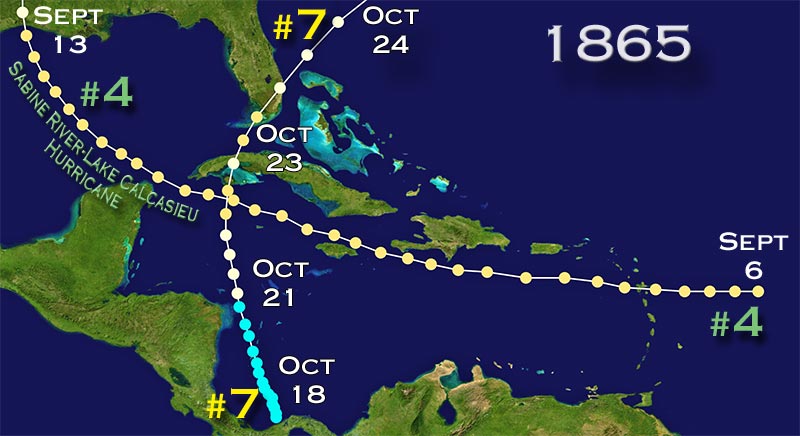 |
|
Wikipedia - 1865 Atlantic hurricane season |

Oct. 23, 1865 hurricane
reported in the Nov. 17 Savannah National Republican - Great storm at Key West
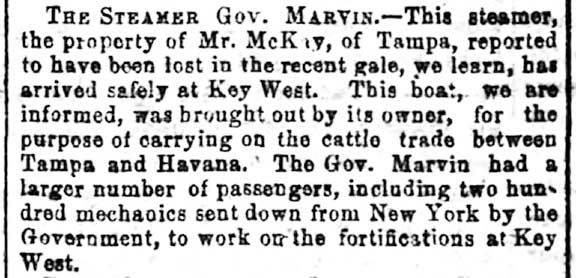
The steamer Gov. Marvin arrives in Key West - Savannah National Republican
Nov. 28, 1865
|
 By James
McKay, Jr. in "Reminiscences
- History of Tampa in the Olden Days" Dec. 18,
1923 By James
McKay, Jr. in "Reminiscences
- History of Tampa in the Olden Days" Dec. 18,
1923
My father succeeded in getting to Havana by a fishing smack
and from his friends in Cuba got sufficient funds to take
him to New York, landing there with only a few dollars in
his pocket. Meeting the old merchants he dealt with previous
to the war, they assisted him in buying a vessel named
Honduras, costing $72,000, which had
carried Union troops to Tampa. He renamed it the Governor Marvin.
He also bought a stock of goods valued at $24,000. He left
New York in October, 1865, with this vessel loaded and 165
passengers. He met a hurricane off St. Augustine and came
very near losing the vessel and all hands, but by the
graciousness of the Heavenly Father he pulled through it
with some slight losses only.
Two or three days after the hurricane, in passing down along
the Florida reef, he saw some 21 vessels of all kinds
ashore, as quick as he could, he discharged freight and
passengers that were for Key West, patched the steamer up,
and left for a bark loaded with sugar and a steamer that was
ashore and worked on them for two weeks, for which he
received enough to pay for one-half of the Marvin.
The Honduras was originally built to carry cattle from
Honduras to Cuba just at the beginning of the war, but was
taken by the United States Government. At that time she was chartered by the United
States Government and was used as a transport along
the Florida coast from New Orleans to Key West and the
Tortugas. My father purchased her in New
York after the War in 1865, and I lost her in the hurricane
of 1872, but got her into the harbor of Key West before she
sank. She was named after the Provisional Governor of
Florida who was and had been a true friend of my father long
before the Civil War.
Many
times have I read the log books of these vessels giving an
account of this expedition. Captain Van Sice commanded the
Honduras at the time of this expedition. I got acquainted
with him in Havana after the war, he then being master of
the City of Vera Cruz of the Alexander Steamship Line plying
between New York and Havana. He discussed with me the
capture of Tampa. A few years later Captain Van Sice,
with the City of Vera Cruz, was lost in a hurricane off St.
Augustine.
When reaching Tampa about the last of November, he entered
into the shipping of cattle to Cuba but as the cattle were
beginning to get poor and the grass being bad in Cuba, they
did not sell for sufficient to pay for cost, duties, and
freight and about the last of December he discontinued
shipping them. In the meantime stores opened on Washington
street and although there was not much money in circulation,
still there was considerable business, mostly in trade. K.
Roberts and Company operated a weekly line of steamers along
the coast from New Orleans to Havana, bringing freight and
passengers. That was of great assistance to this section of
south Florida.
|
1865 - The Florida
Constitutional Convention
When the war ended in 1865, Magbee was elected by Wakulla
County voters as their delegate to the Constitutional Convention
at Tallahassee,
where he was a framer of the new Florida Constitution.
The convention convened October 25 and Magbee was
joined by former secessionist James Gettis of Hillsborough,
Unionist James D. Green of Manatee and former Confederate officers
Francis A. Hendry of Polk and Samuel E. Hope of Hernando.
The
convention "annulled" the Ordinance of Secession but Magbee and
the majority rejected radical language that would have declared
secession "null and void from the beginning."
On the subject of
slavery, conservative language that the institution had been
destroyed "by the Government of the United States" was approved 20
to 14, with Magbee and Gettis in the majority. Additional
conservative language was supported by Magbee and Gettis but was
defeated by a 30 to 7 vote.
The state remained under martial law, and Congress refused to seat
legislators from the former Confederate states until more
stringent requirements were met. Florida ultimately scrapped the
Constitution of 1865 in favor of a new version created in 1868.
Interestingly, Magbee, attempted to have wording removed that
limited testimony by blacks only to cases involving them, unless
"made competent by future legislation."
|
Judge
Perry G. Wall and the Civil War
Perry Green Wall has been
described as a Unionist who opposed secession. Nevertheless, he continued
to serve as probate judge of Hernando County after Florida seceded from
the Union in January 1861. He was reelected to his final term in the
October 1861 elections. From March 29 until May 17, 1862, he served in
Capt. J. H. Breaker’s Old Guards, Mounted Rangers, along with son-in-law,
Aaron T. Frierson, Samuel Pearce, Francis Ederingrton and Malcolm C.
Peterson.
(Judge Wall is sometimes referred to as
"Perry Green Wall, I (the first) because he had a grandson named Perry
Green Wall, II, who was a son of Billy W. Wall and served as a mayor of
Tampa. Read about the life of
Judge Wall at TampaPix.)
|
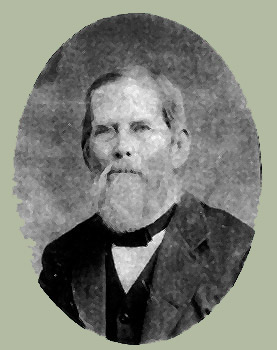 |
|
Perry Green Wall and
Nancy Hunter had seven children:
-
Mary Matilda Wall b.1831 d.1905 marr. Aaron Taylor Frierson
-
Julia Ann Wall b.1832 d.1915 marr. Christopher L. Friebele
-
William "Billy" Washington Wall
b.1834 d.1878 m. Minnie May
-
Dr./Mayor John Perry Wall b.1836
d.1895 marr. 3x
-
David Hunter Wall, b. 1838 d.1864
-
Sarah Louise Wall b.1840 d.1925 marr. Edward A. Clarke
-
Susan Catherine Wall b. 1843
d.1899 marr. William
Marion Hendry
|
Judge Perry G. Wall
Image from
THE SUNLAND
TRIBUNE,
Journal of the Tampa Hist. Society
Volume
XXIII November, 1997 |
|
|
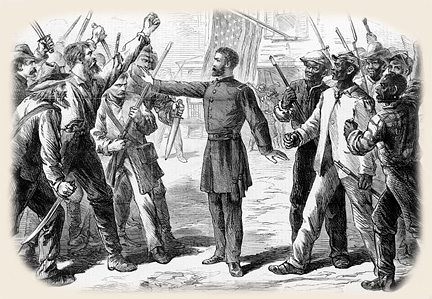 |
Judge Wall
Appointed to Freedmen's Bureau
Wall was to play a
prominent role in Hernando County Reconstruction. On November 2, 1865,
apparently after a meeting in Tallahassee, Wall was appointed agent for
the Bureau of Refugees, Freedmen and Abandoned Lands in Hernando County.
He was directed to "proceed at once to systematize the affairs of the
county in so far as the Bureau has jurisdiction; and, especially so far as
it is in his control, induce the Freedmen to make contracts for labor with
the planters and other parties wishing to employ them." The order
was signed by Col. Thomas W. Osborn, Assistant Commissioner of the Bureau
in Florida.
Writing to
Thomas from
Brooksville on December 8, Wall outlined his actions as agent:
|
|
In the years following
the Civil War, the Bureau of Refugees, Freedmen, and Abandoned Lands
(the Freedmen's Bureau) provided assistance to tens of thousands of
former slaves and impoverished whites in the Southern States and the
District of Columbia. The war had liberated nearly four million
slaves and destroyed the region's cities, towns, and
plantation-based economy. It left former slaves and many whites
dislocated from their homes, facing starvation, and owning only the
clothes they wore. The challenge of establishing a new social order,
founded on freedom and racial equality, was enormous.
The Bureau was established in the War
Department in 1865 to undertake the relief effort and the
unprecedented social reconstruction that would bring freed people to
full citizenship. It issued food and clothing, operated hospitals
and temporary camps, helped locate family members, promoted
education, helped freedmen legalize marriages, provided employment,
supervised labor contracts, provided legal representation,
investigated racial confrontations, settled freedmen on abandoned or
confiscated lands, and worked with African American soldiers and
sailors and their heirs to secure back pay, bounty payments, and
pensions. |
After arriving home, I was within
two or three days, taken down very sick, from which I did not recover
sufficiently to go out, for about three weeks. As soon however as I
was able to do so, I proceeded to make known to the colored people of
this county, my agency in the Bureau and such system for hiring out
labor for the incoming year, as I deemed most promotive of their
interest. The Colored people here pretty generally seemed very much
pleased with me as their agent, and disposed to be governed by my
instructions, which was that in order to insure employment and a
competency for next year, they must —and especially those with
families — make contracts with the planters having farms, either for
stated wages or as a share of the crop.
On the
presumption that I am superseded as agent by the Judge of Probate of
this county, I will proceed no further in the duties thereof at least
until I shall hear from you."
|
|
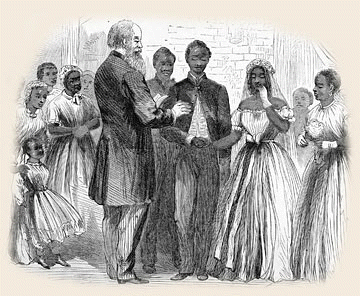
The records left by the
Freedmen's Bureau through its work between 1865 and 1872 constitute
the richest and most extensive documentary source available for
investigating the African American experience in the post-Civil War
and Reconstruction eras. Historians have used these materials to
explore government and military policies, local conditions, and
interactions between freed people, local white populations, and
Bureau officials.
Read about the entire collection, including marriage
records, at the National Archives |
Judge Wall Controversy
In March 1866, Lt.
William G. Vance, sub-assistant commissioner for the Bureau, was in
Brooksville. He reported that he had visited Judge Wall "to have him
accept the civil agency for the county which after some hesitation he
did." Almost immediately after his appointment, Wall was involved
in controversy. Acting at Vance’s direction, and in his capacity as civil
agent, he performed a marriage ceremony for a black couple who had lived
together for many years as man and wife. This violated an act of the state
General Assembly and he was brought up on charges before the county
criminal court. Fearing that Wall might be subjected to a whipping
or the pillory, Gen. Foster ordered the commanding officer at Tampa to
send a force of ten men to Brooksville to keep order. If Wall, who was
described as a "sound and truly loyal man," was sentenced to corporal
punishment, he was to be taken to Tampa for protection. The trial was
postponed to June and Vance wrote to Osborne on May 25:
They have got a very poor opinion
of the Judge here and say he was a good secessionist as any of
them till the War ended when he took sides with the Unionists. But
from what I have seen of him he appears a good Union Man. The people
in this section of the country are strongly opposed to those men who
have been Unionists or in our army and every little chance they can
get they bring them before the court, and punish them with very heavy
fines while men of their own opinions go free after committing more
grievous offences.
|
|
The troops were
sent to Brooksville and at the trial Wall was convicted and fined one
dollar. Vance, who was present at the trial, believed that a harsher
sentence was averted only by the presence of the troops.
Judge Wall was
forced to relinquish his position as special agent for the Freedmen’s
Bureau in August 1867 because he was unable to take the "test oath," also
known as the Ironclad oath, which was required of all Federal officers.
The oath disqualified from Federal service those persons who had supported
the rebellion. As a former county officer who had taken an oath to support
the U. S. Constitution and later engaged in rebellion, Wall was also
disqualified from holding Federal or state office under the 14th Amendment
which was ratified in 1868. But when Congress passed its first act in 1868
removing disabilities from former Confederates, Perry Wall was one of 14
Florida men whose right to hold office was restored.
"To Faithfully Discharge My Duty
- The Life and Career of Perry Green Wall" by Kyle S. VanLandingham, The Sunland Tribune, A Journal of the Tampa Historical Society, Vol. 23, Nov.
1997 |
1865 -
Race for Secretary of State and Move to Tallahassee
On November 29, 1865, Magbee was defeated in the race for
Secretary of State by B. E. Allen. Magbee received 583 votes
against B. E Allen’s 2,729. When the State Senate met in December,
Magbee was appointed Engrossing Clerk, a position he also held in
the 1866 session the next year.
He was 46 years old.
He reentered the legal profession, relocated to
Tallahassee and opened a
law office there in February 1866.
|
 By James
McKay, Jr. in "Reminiscences
- History of Tampa in the Olden Days" Dec. 18,
1923 By James
McKay, Jr. in "Reminiscences
- History of Tampa in the Olden Days" Dec. 18,
1923
In 1866, during
the summer, the trade with Cuba had increased to such an
extent that my father purchased
[another former Union steamship],
the
Huzzas and renamed it
"Southern Star,"
to assist the Governor Marvin to freight cattle, but the
demand did not last longer than that year, as the
insurrection in Cuba broke out and buyers were afraid to put
cattle on pastures.
|
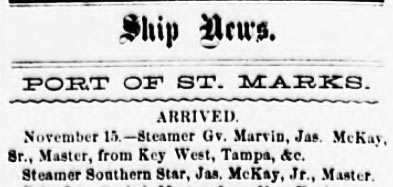
Nov. 16, 1866 Floridian |
|
He chartered the Marvin to a
party of Spaniards to load mules at Tampico, but when we
arrived there found an insurrection had sprung up in
Tamaulipas and we were detained for a month, when we loaded
357 mules for Havana. Arriving at our destination we found
the city in a state of excitement for fear of an attack from
the Cuban army. The night of the day of our arrival, while
myself and officers of the ship were upstairs in the Louvre
playing billiards, as a battalion of Spanish soldiers were
passing, someone fired a pistol. The soldiers opened fire on
the lower or ground floor and shot the place all to pieces.
We made our escape over the tops of buildings and were let
down through a trap door on the top of the building on the
opposite side of the block. It was not long before we found
ourselves on board the Marvin and very glad to be there. |
|
1866 - October 25 - The campaign in Tampa for
unincorporation
Elections were held per the state
legislature to reorganize the city’s incorporation. E. A.
Clarke elected mayor; Dr. L.A. Lively, R.F. Nunez, Josiah
Ferris, and B.C. Leonardi, councilmen; and John G. Robles,
marshal. In order to meet financial obligations,
occupational taxes were levied; many objections were raised;
protests ensue with talk of real estate taxes; a “no
corporation” slate of officers pledge to discontinue the
government until better times return.
The Mayors of Tampa 1856 - 2015,
A project of the City of Tampa, City of Tampa:
Incorporation Timeline |
|

Civil War
and lack of Congressional assistance block railroad
efforts
The Civil War
had devastated
Tampa. It was blockaded, shelled, and occupied by
Union forces. Confederate martial law prevailed, and,
at times, the community virtually was deserted. The
early years of Reconstruction were little better. By
1867 the local stores were without supplies, and
yellow fever again struck. So difficult were
circumstances for most that, in 1869, the town
abandoned its charter. From a pre-Civil War population
high of 885, the total had dwindled by 1870 to 796.
When yellow fever reappeared in 1871, Tampa was
completely depopulated. Nine years later the census
revealed only 720 residents.
Throughout the
Civil War period Tampans continued to long for a railroad
as their only chance to stop the town’s decline. Shortly
after the war, hopes were lifted when construction of a
line either to Tampa Bay or Charlotte Harbor was proposed.
Warned one newspaper: "If the people of Tampa want this
road, they can get it ... if they give it the ’cold
shoulder’... they may lose it." Lose it, they did.
Although Republican Governor Harrison Reed pledged his
support, necessary Congressional assistance was blocked. The town even went without a telegraph.
When a telegraph line was constructed down the peninsula in
1867, it by-passed Tampa by fifty miles. For the next
decade news was received overland from Fort Meade.
THE SUNLAND TRIBUNE, Journal of the TAMPA HISTORICAL SOCIETY,
Volume XVII November, 1991
Journal of the Tampa Historical Society
- TAMPA AND THE
COMING OF THE RAILROAD, 1853-1884, by Canter Brown, Jr. |
| |
1868 -
MAGBEE APPOINTED CIRCUIT COURT JUDGE
Radical Reconstruction began in Florida in 1867 and by April 1868,
Magbee was a committed Republican. He befriended Harrison Reed and
when Reed became governor under the
new 1868 constitution, Magbee
was appointed to an eight year term as judge of the 6th Circuit.
It
covered the West Coast of Florida from Brooksville to Key
West,
comprised of the counties of Hernando, Hillsborough, Polk, Manatee
and Monroe.
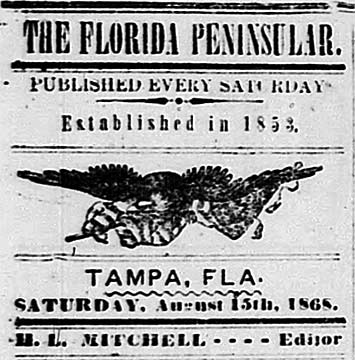 Claiborne R. Mobley of Tampa, an ally of
James D. Green, also wanted the judgeship, but was forced to
settle for the position of State Attorney for the 6th Circuit.
After Senate confirmation, Magbee’s appointment was announced in
the August 15, 1868 edition of the Florida Peninsular.
Editor Henry L. Mitchell stated: Claiborne R. Mobley of Tampa, an ally of
James D. Green, also wanted the judgeship, but was forced to
settle for the position of State Attorney for the 6th Circuit.
After Senate confirmation, Magbee’s appointment was announced in
the August 15, 1868 edition of the Florida Peninsular.
Editor Henry L. Mitchell stated:
I would
have preferred many others to Magbee, yet under the
circumstances we are satisfied and have sound cause to rejoice.
The contest for the appointment had been between Magbee and
Mobley, and of the two, we a thousand times prefer
Magbee. ...Magbee is a lawyer of much experience and we doubt not,
will make a fair judge.
|
 By James
McKay, Jr. in "Reminiscences
- History of Tampa in the Olden Days" Dec. 18,
1923 By James
McKay, Jr. in "Reminiscences
- History of Tampa in the Olden Days" Dec. 18,
1923
A renegade judge of the court was placed in office in
this section and with the notorious Jim Green and his
deserters to assist him, they joined the republican party,
the fight became quite interesting. The loyal Confederates
soon were engaged in a struggle that was not much inferior
to the war between the states. At one time it appeared as
another losing proposition but with the aid of the Ku Klux
Klan, all over the south began to see daylight.
In 1876 this state as well as others, emerged from the fight
by placing George E Drew in the governor’s chair, [but]
Florida’s presidential vote was given to Hayes. It was not long after
this when the renegades and deserters were fired from office
and sound democrats installed. From that time this section
began to improve, and every person felt safe and happy.
Previous to this there were many night rides by the
citizens, to accomplish what they did.
|
1868 -
Opposition to Judge Magbee in Tampa
When the newly appointed judge arrived in Tampa he faced
opposition from two quarters. First, the local Republicans, who were
led by Claiborne R. Mobley and Matthew P Lyons.
Lyons, a resident of Fort Green during the 1850s, had become an
ally of Manatee County and farmer-politician, James D. Green. Lyons
was noted for his whining letters to the Florida Peninsular during
the Third Seminole War. Late in the Civil War, returning from a
visit to Union-controlled Fort Myers, he was captured by
Confederate troops and taken prisoner. Lyons was now Clerk of the
Circuit Court, appointed by Gov. Reed.
Mobley and Lyons were suspicious of Magbee, and resented having to
share power with him. On the other end of the political spectrum
were the Democrats, or Conservatives as they were then often
called. Former secessionists, Whigs, all those opposed to
radical rule (Republicans) were now identified with the Democratic party.
Magbee’s "honeymoon" lasted about two months.
1868 - Magbee designates an "official newspaper"
On October 10, 1868,
Judge Magbee declared the newly established
Republican newspaper, the True Southerner, "the official newspaper
of the Sixth Judicial Circuit of Florida" and ordered that all
legal advertisements and notices be published therein. The
paper’s editor was Edward O. Plumbe, soon to be County Judge and
the publisher was listed as Charles L. Newhall**. Eventually, Magbee
was identified as the paper’s owner. **The
publisher was W.J. Stallings.
|
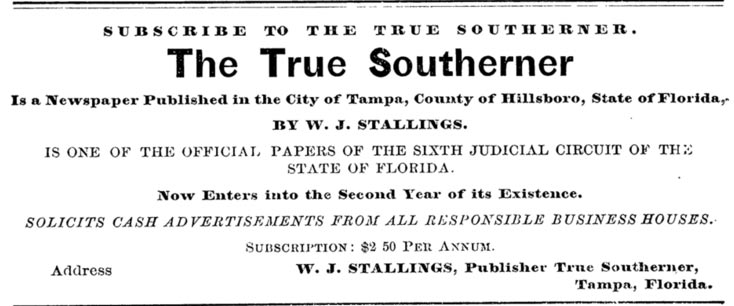 |
|
Rowell's American
Newspaper Directory edited by George Presbury Rowell, 1870 |
1868 - Magbee speaks at a Republican meeting in Tampa
A "Republican Mass Meeting" was held in Tampa on October 21,
1868. Capt.
James D. Green spoke in the afternoon session, which was followed
that evening by a "torch-light procession" to the Courthouse.
Speeches were offered by E. O. Plumbe, C. R. Mobley and Judge
Magbee. Magbee "took the stand and delivered a most
eloquent and patriotic speech, literally a feast of fat things,
full of the soundest logic and argument,” according to the "True
Southerner" of October 29, 1868.
1868 - William B. Henderson's article on the Republican meeting draws contempt charge by Magbee
| |
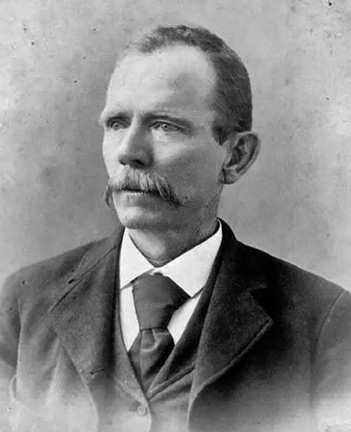 |
| |
William Benton Henderson, 1891
Photo from Florida Memory,
State Library & Archives of Florida
|
| |
Unlike many of Tampa’s identifiable
sections, Tampa Heights was an area of many small
subdivisions, established by original homesteaders or
developers. Most of the early homes were constructed by
individual contractors and while the area had its share of
land speculators, the Heights was designed for Tampans with
little newspaper promotion and attractions for Northern
winter visitors.
Perhaps the four block Tampa Heights
subdivision, created in September of 1889, by William Benton
Henderson, best reflected the growing prestige of Tampa
Heights in the last decade of the nineteenth century.
The eldest child of a large Georgia farm
family, Henderson made his own way in life at the age of
twelve. He came with his father to Fort Brooke in 1846 and
started one of the first stores on the Alafia River. He
married Caroline Spencer, daughter of Palma Ceia homesteader
William Samuel Spencer.
It was during the Civil War that Henderson
gained his Colonel status, serving first in Captain (judge)
James Gettis’ Company D of the 7th Florida Regiment and
later commanding John T. Lesley’s Company after Lesley was
wounded.
After the war, he joined Captain John
Miller in a steamboat and mercantile business that dominated
Tampa’s commercial contact with the outside world.
Henderson was a diversified and dynamic
promoter: he introduced Durham bulls into the Florida cattle
industry; he built Tampa’s first telegraph line; he started
the banana trade with Central America; and consolidated two
local papers into the Tampa Times.
His business ventures were so successful
that he retired from active business, channeling his
energies into financial investments and public service. This
active involvement brought him even greater influence, as he
served as: President of the Tampa Building and Loan
Association, President of the West Tampa Land and
Improvement Company,. President of the Tampa Publishing
Company, President of Tampa’s first Railway Company, City
Councilman, Chairman of the County School Board, and
Chairman of the Board of County Commissioners.
When he built a large house, complete with
observation turret, on the bluff at Tampa Heights, he was
soon surrounded by so many business and family associates
that the two block section of Seventh Avenue East resembled
a Henderson corporate center, which would heavily influence
Tampa’s economic growth for many years.
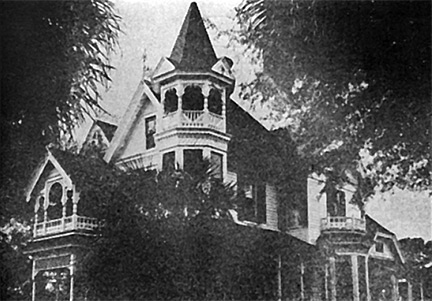
Henderson' home on 7th Ave, in
1902
TAMPA HEIGHTS: TAMPA’S FIRST
RESIDENTIAL SUBURB,
By Marston C. Leonard
THE SUNLAND TRIBUNE Volume IV Number 1 November, 1978
Journal of the TAMPA HISTORICAL SOCIETY
|
In an Oct. 24, 1868 article in the
Florida Peninsular newspaper,
correspondent William B. Henderson took a different view of the
meeting.
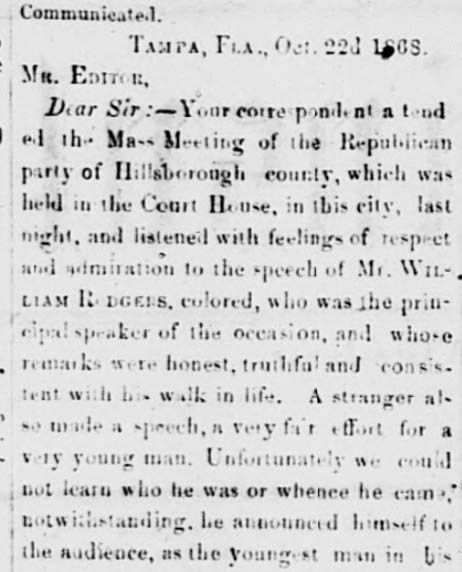
Henderson reminded his readers that Magbee was...
"holding his
regular term of the Court in this county,” and Henderson was "surprised
that a high Judicial officer of the State... should enter the
political arena as a stump speaker."
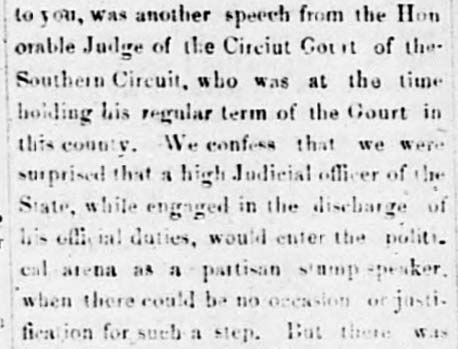
According to Henderson,
Magbee held the Democrats "responsible" for the Civil War
"and
that their hands were dyed in the blood of more than half a
million loyal men." This angered Henderson who remembered that
Magbee had been the most active, ultra red-hot secessionist in the
whole county. His efforts to hang James McKay in 1861 and his
description of himself as an "undoubted secessionist"
at that time were fully aired in Henderson's article.
Henderson signed the piece, "A
Looker On in Venice.”
See Henderson's entire article on
this separate page.
See the original Oct. 24, 1869 Peninsular newspaper scan online.
Magbee was so angry that he threatened to "strike from the roll of
attorneys
[Henry L. Mitchell]
the editor of the Peninsular; unless
he gave up the author of the piece."
The judge then became very
ill with fever and was unable to preside at Court. Sam C. Craft,
an attorney in the Circuit and friend of Magbee's, met with him
after his illness and attempted to calm him down.
Magbee believed...
"...that this was but the first development in a widespread and
deeply laid plot to destroy
[his]
judicial influence, and thereby to defeat the ends of Justice
and consequently was such a contempt of court that
[he]
could not permit it to pass; that if this act was permitted to
go unpunished, it would soon be followed by others; and that
[he]
had to meet it, or else the country would have to go back under
military rule."
Craft urged the judge to "loosen the reins" for awhile but Magbee
replied that "he was not sent on the circuit to gain popularity
but to execute the Laws, and the surest way to prevent fruit was
to clip the bud."
Judge Magbee had Henderson brought before him on a contempt charge
at the end of the term. Henderson was represented by counsel who
argued that the article was a "legitimate exercise of the liberty
of speech," and the remarks were not directed
against
the Court but against the judge politically, a "reply of a
Democrat to a Republican."
Judge Magbee
was unmoved and fined Henderson $100 for contempt of court.
This would later be one of the articles of Magbee's
first impeachment.
1869 - On the circuit with Judge Magbee
As judge of a five-county-circuit which included most of west
central and southwest Florida, Magbee did a great deal of
traveling. He was required to hold spring and fall terms of Court
in all five counties. Travel in the back country could be
difficult and hazardous. In the spring of 1869, John B. Stickney,
a young lawyer accompanying Magbee, remarked on the swollen
streams and heavy rains and the discomfort of riding in an open
buggy under unpredictable weather conditions. All in all, Stickney
found the trip pleasant and enjoyed the company of the judge and
the friendliness of the people on the route.
Hubbel's Legal Directory, 1881-82
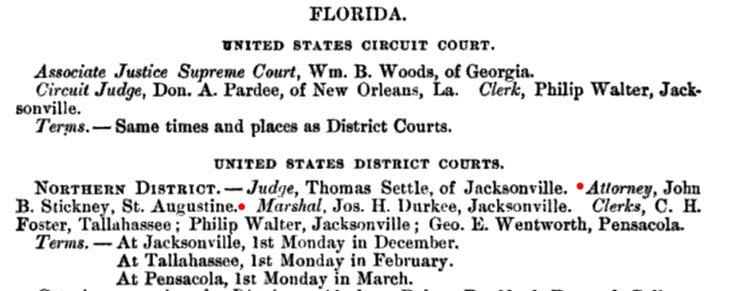
See:
The ghost of Judge John B. Stickney
Magbee's
enemies, however, began to subject him to a series of practical
jokes. On one occasion in mid-1869 at the Brandon residence east
of Tampa, his buggy traces were cut.
From Jesse Hope, descendant of a great Indian fighter and
Confederate soldier, Capt. Sam Hope, comes another Magbee story.
Jess said circuit court was in session in Brooksville, and one
morning the judge, the clerk and the sheriff walked into the
courtroom at the time for convening and found an old grey jackass
tied in the judge's chair, tied so tight that he was sitting
upright on his rump. Gazing at the braying jack a moment, the
witty old scalawag remarked, "That's Sam Hope's old ass. Leave him
there. He's about the kind of judge to suit this situation."
|
1869 - March 1
- City of Tampa abolished
By the end of the 1860s the City of
Tampa faced a bleak future. Former Confederate officer and
leading Tampa citizen John T. Lesley ran for mayor in
Tampa’s 1869 election with a simple campaign promise: vote
for him and he would abolish the City of Tampa.
Citizens of Tampa voted overwhelmingly for the No
Corporation People’s Ticket. The platform of this party was
to close the city government in Tampa, thus forcing the
state legislature to revoke Tampa’s 1855 city charter by
allowing it to lapse, effectively eliminating the City of
Tampa as a legal municipality. The charter was revoked on
October 4, 1869 due to the deadline in a state act providing
for the reorganization of municipalities.
The Mayors of Tampa 1856 - 2015,
A project of the City of Tampa, City of Tampa:
Incorporation Timeline |
JUDGE JAMES T. MAGBEE LETTER
DATED SEPT. 14, 1869
Letter obtained from Stewart Lutz Historic Documents

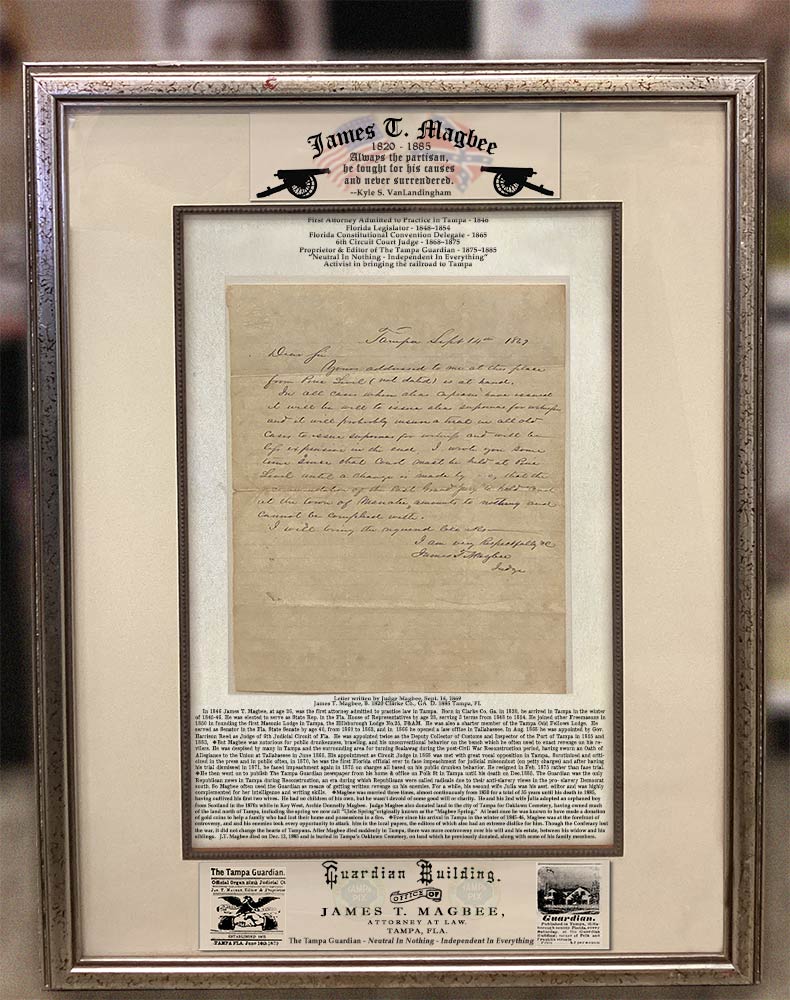
TRANSCRIBED BY
TAMPAPIX
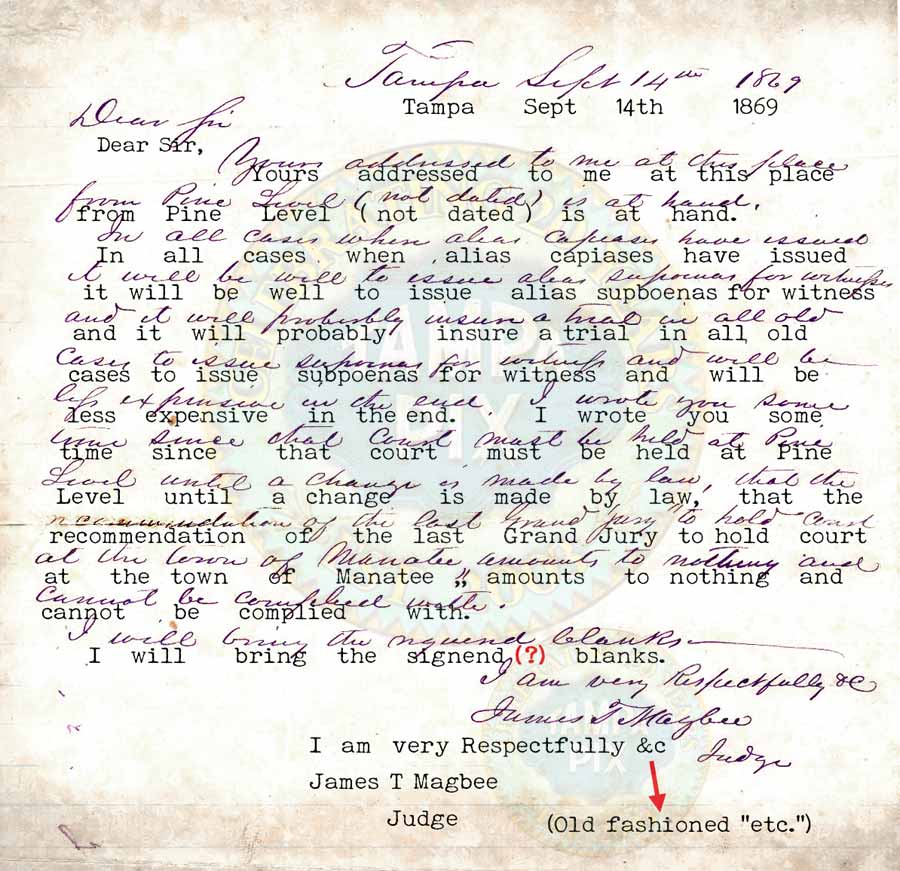
|
1869 - October 4
County commissioners decreed that “as the City of Tampa has
forfeited its charter, all property of the City shall be
taken over by the county clerk.”
The Mayors of Tampa 1856 - 2015,
A project of the City of Tampa, City of Tampa:
Incorporation Timeline |
|

Legal battle sets the
stage for more obstacles
Former Florida State Senator David
Yulee is in the news for a lawsuit in New York involving Francis
Vose. Later, Vose would play an antagonist's role by
impeding the progress of the railroad development in Florida.
Around 1859, the Florida Railroad
bought iron from the firm of Vose & Livingston in New York, and
gave its note endorsed by Sen. David Yulee 195 Internal Improvement Bonds for $1,000 each
as collateral security.
Later, around 1870, the firm of Vose & Livingston would dissolve,
and the note and bonds would come into possession of Mr. Vose as
his share of the assets. This issue would later escalate to
the point of deterring the progress of the railroads in Florida.
The story continues later.
|
| |
1870 - The
Magbees on the 1870 Census
The 1870 census
reported fifty-year-old James T. Magbee as residing near present-day Brandon, where he
described himself as a "Farmer and Lawyer." His age is
consistent with an 1820 birth year. Julia was listed as 27
years old, making their age difference 23. He and his wife Julia
had no children, but living in their household were his
elderly mother Susan (born in Ga.), and two of his sisters,
Penelope and Elizabeth, and a young female Dorrie. There
were also 3 farm laborers and a 60-year-old servant, Rose, listed. The closest neighbor was
James Brandon.
It wasn't until the 1880 census that
relationships to head of house were listed, so these relationships
are conclusions based on other sources, such as names, ages and places of birth.
It is not known what relationship Dorrie had to any of the
household members. She was a white female, attending school,
so it's not likely that she was a servant.
|

By James
McKay, Jr. in "Reminiscences
- History of Tampa in the Olden Days" Dec. 18,
1923
I have been compelled to mention my father many times, which
I could not prevent, from the fact that in the early days of
Tampa there was not a single interest connected with the
town but what he was either the originator, or connected
with it in some manner. He was identified with every
improvement in the town.
As this article is rather lengthy I will close, wishing you
and all a merry Christmas and a happy New Year..
H. B. Plant's
steamer Olivette was a 250-foot ship built under the
supervision of Capt. James McKay, Jr. in Philadelphia and
launched February 16, 1887. Captain McKay, Jr. brought the vessel
in April 29, 1887 [to Tampa] and thereafter served as her
master.
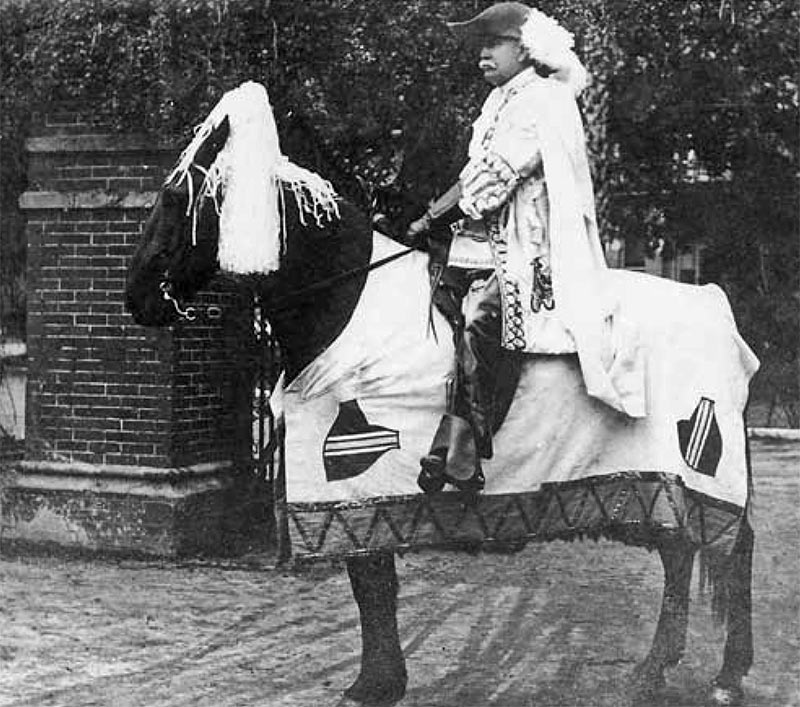
James McKay Jr. on his horse during
the 2nd Gasparilla invasion, 1905.
Photo from the Lesley Collection, Tampa Bay History
Center.
By TampaPix: This photo might not be quite this
old. Compare to his 1902 election photo with beard
and this Jan. 15, 1918 passport application photo. The
Gasparilla photo more closely resembles him in 1918.:
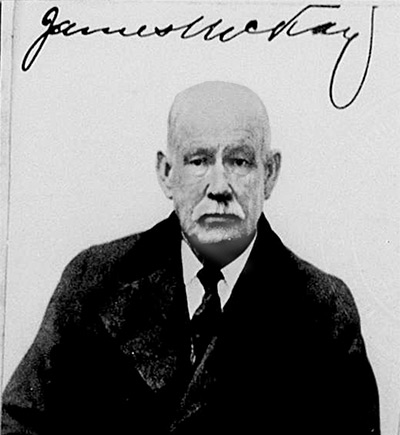
See his passport application, he is mistaken about
his father's
whereabouts from 1831 to 1876.
|
|
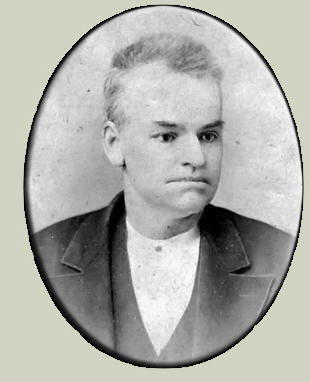
State
Senator John T. Lesley, ca. 1885
Photo from
Florida Memory, State Library & Archives of
Florida
|
John Lesley's short term as mayor
The antagonism
between federal authorities and Tampa residents was the
foundation for John Lesley’s mayoral campaign in early 1869.
He campaigned on a single platform that Tampa’s charter
should be revoked by the state legislature due to the City’s
destitute financial condition. The majority of residents
agreed and Lesley was elected mayor on March 1, 1869. While
a city clerk, treasurer and a city council was elected, the
Lesley Administration did little more than wait until the
state legislature revoked Tampa’s Charter due to a inactive
government. |
|
On October 4,
1869, the state legislature responded as expected and
revoked the City’s charter. When the news reached Tampa,
Lesley and other city officials resigned their positions.
The Hillsborough County government appropriated all city
properties and assumed responsibility for providing
educational and other principal services to Tampa’s
residents. After resigning, Lesley returned to his business
ventures.
Lesley was
elected to the Florida House in 1876 and the Senate in 1878
being reelected in 1882. He was a member of the
constitutional convention of 1885. He was also owner of John
T. Lesley's wholesale and retail drug store. He died on July
13, 1913. Tampa’s status as a non-chartered city
continued until 1887 when residents voted to re-incorporate
the city.
|
| |
1870 -
Magbee the Scalawag Judge and impeachment
As a Republican official during Reconstruction, Magbee rose to
prominence in the Tampa community. He had supported the
Confederate army during the war, but after the fighting, he became
for reasons unknown, a "scalawag,"
a Southern turncoat who joined the northern oppressors.
|
|
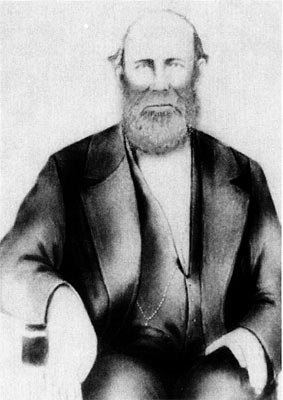 |
|
|
James Dopson Green, Unionist
One of the earliest pioneers of the Peace River valley.
He was a county officer in the 1850s, a captain in the Union
Army, and the area's main Republican leader during
Reconstruction.
Photo and info from
Florida's Peace River Frontier, 1997, by Canter
Brown, Jr.
Capt. James D. Green, a
pioneer settler of Hillsborough and Manatee counties, was a
controversial figure in the Civil War and Reconstruction era
in South Florida. Green's most radical act while
serving as Manatee's Representative was his efforts to
impeach Governor Harrison Reed. In the special legislative
session in November 1868 H. S. Harmon, James D. Green, and
Marcellus L. Stearns were appointed a committee to prepare
and report articles of impeachment against the governor. The
ensuing resolution was reported to the Senate as though the
governor had been impeached, and Lt. Governor William H.
Gleason, an opponent of the governor, opportunistically
interpreted it to mean he was governor. Governor Reed,
however, outmaneuvered his enemies and successfully had
Gleason removed from office as he had not been a citizen of
the state for two years as required by the constitution.
James Dopson Green, by Spessard Stone |
Magbee had very few
friends in Tampa; he used his office while serving as judge to
"get even" with those who opposed him. He delighted in forcing
prominent white men to serve on the
same juries with blacks, something that didn't sit well with many
of Tampa's citizens of that period. He frequently had men brought
before him in contempt proceedings for something they had said or
written in criticism of his actions and imposed heavy fines on
them---entirely without justification in law.
On February 18, 1870,
James T. Magbee became the first Florida official to face
impeachment by the Assembly of the State of Florida for
misconduct--"high crimes, misdemeanors, malfeasance in office and
incompetency." The vote was 29 to 4 in favor. A committee headed by
James
D. Green presented Articles of Impeachment which were approved 24
to 3. The Senate was duly notified and responded that trial would
be held at "its next regular session." The following is a Summary
of the Articles:
Article I
He caused one citizen, William B. Henderson, to come before his court and
fined him $100 for contempt for writing and publishing an
article criticizing a speech delivered by Magbee. Magbee
unlawfully detained and imprisoned Henderson until the fine was
paid when in fact, Henderson's article was published when
Magbee's court was not in session and Henderson was not in
contempt.
Article II
He unlawfully removed two grand jurors from the panel regularly
drawn and caused the names of two petit jurors drawn on the
regular panel of petit jurors to be placed on the panel of grand
jurors in their stead, thereby committing a misdemeanor.
Article III
Prior to the drawing of grand and petit jurors for the fall term
of 1869, he unlawfully attempted to induce and influence the
Clerk of the Circuit Court to commit fraud in drawing the grand
and petit jurors for the fall term in that he asked the clerk
not to place the names of certain jurors, if drawn, upon the
jury list and, instead, to place the names of certain other
persons on the list, whether drawn or not, thereby committing a
misdemeanor.
Article IV
He purchased pipes, tobacco, envelopes, stamps, and other
articles for his own private use and unlawfully caused these
articles to be charged as "stationery" against the State.
Article V
He persuaded Irene Jenkins, charged with adultery, that a plea
of guilty would induce a mitigation of the penalty, whereupon
she entered a plea of guilty. Magbee, disregarding his promise,
imposed cruel and unusual punishment, to wit, twenty-one months'
imprisonment at hard labor, while at the same time, Louis M.
Jenkins, charged with the same offense, plead guilty and was
fined only $75. By such acts he manifested a cruel and wicked
disposition of heart and an incompetency for the position of
judge.
Testimony
The legislature
adjourned February 19, 1870. As an impeached official, Magbee was
now under suspension, pending the Senate trial. Gov. Reed called
the Legislature into extra session on May 23. Magbee entered a
plea of not guilty and demanded a speedy trial during the special
session. He submitted an impressive collection of letters and
affidavits attesting to his innocence.
The Assembly managers
requested a continuance and trial was postponed to the next
regular session in January 1871. Magbee traveled the state
soliciting support from friends and legislators. He played an
active role in the 1870 Republican state convention as a member of
the Reed faction and joined in the unsuccessful efforts to
re-nominate Congressman Hamilton. Later, in Gainesville, he was
involved in a drunken brawl, beaten up and fined by the mayor.
[See
"Magbee on the Rampage" after this section on Judge Perry Green
Wall.]
Judge Perry
Green Wall
On January 13,
1870, Democratic State Sen. John A. Henderson and Democratic
State Rep. Charles Moore of Hillsborough recommended to Gov.
Reed the appointment of "Perry G. Wall, Esq. of Tampa, as a
suitable person for the office of County Judge of
Hillsborough County.” Wall was confirmed by the Senate
on January 26 and took office on March 13, 1870. The Tampa
Peninsular newspaper reacted warmly to Wall's appointment:
Gov.
Reed has appointed the Hon. Perry G. Wall, Judge of the
County Court for Hillsborough County. This is an excellent
appointment and it will, we feel assured, give universal
satisfaction. - Judge Wall has filled with fidelity many
important offices in this State, and whilst he presides as
Judge of the County Court he will do so intelligently,
impartially and independently.
The local
Republican County Committee, chaired by Judge James T
Magbee, was not pleased with the appointment of Wall.
Magbee, having been impeached by the House, was awaiting
trial and thus temporarily out of office, retained
influence but was opposed by other Tampa Republican leaders
C. R. Mobley and Matthew P. Lyons.
|

Judge Perry G. Wall
Image from
THE SUNLAND
TRIBUNE, Journal of the TAMPA HISTORICAL SOCIETY, Volume
XXIII November, 1997
|
|
Magbee's
committee asserted that Wall did not reside in the county
and wanted E J. Gould named to the post of county judge.
Despite his loyalty to Reed, Magbee's wishes were not
honored.
Magbee had
reason to dislike the Wall family. One of the impeachment
charges against him involved his alleged improper purchase
and use of goods and supplies obtained from the firm of
Eddington and Wall in Brooksville (co-owned by Billy Wall,
a son of Judge Wall.)
As county
judge, Perry G. Wall also served as ex officio probate judge
and also as a justice of the peace. He and his son, Dr. John
Wall, had their initiation into the printing business when
Republican C. R. Mobley acquired the Florida Peninsular in
late 1871. Mobley turned it into a Republican newspaper and
hired William P Neeld who in turn retained the Judge and
Doctor as editors. Publication continued only a few months
until the paper went bust in the spring of 1872.
Judge Wall continued in office
until April 26, 1873 when he tendered his resignation to
Gov. Ossian B. Hart. On March 10, 1873, Judge Wall had
received the lucrative appointment of Postmaster at Tampa
from President Ulysses S. Grant. He served as postmaster
until January 22, 1877 when he was replaced by Robert B.
Thomas.
In retirement, Perry G. Wall suffered the loss
of his wife, Barbara, on May 30, 1883. Her body was returned
to the old home place at Spring Hill and she was buried in
the Lykes Cemetery. Perry did not remain a widower for long
and on December 4, 1883, he married Sarah Watlington of Key
West, the 47-year old daughter of Francis and Emilene
Watlington. Perry and Sarah entered in to a prenuptial
agreement prior to the marriage. They lived at
their home in Tampa, occasionally visiting Key West and
spending some time at the resort of Rocky Point, on Old
Tampa Bay, west of downtown Tampa. At 4 o’clock on the
afternoon of July 8, 1897, at the home of his daughter,
Julia Ann Wall Friebele, on Franklin Street, Perry Green
Wall died, after an illness of several weeks duration. He
was 87 years old. His will named his two younger sons,
Joseph and Charles, as executors, he having outlived his
three oldest sons.
|
|

Tampa rail
hopes rekindled
Not all hope
was lost for a railroad connection to Tampa. In 1870 south
Florida’s cattle trade with Cuba began to prosper again, and
local enthusiasm was rekindled. At Governor Reed’s urging,
the legislature approved several lines into south Florida.
One group, backed by area residents such as cattleman
Francis A. Hendry and lawyer John A. Henderson, planned to
build a line from near Gainesville directly to Tampa.
Hillsborough and Polk County investors similarly organized
the Upper St. John’s, Mellonville, Tampa & South Florida
Rail Road to tie the town to the St. Johns River.
Tampa and the
Coming of the Railroad, 1853-1884, by Canter Brown, Jr,
in The Sunland Tribune, Volume XVII November, 1991 Journal
of the Tampa Historical Society. |
| |
1870 - June 1 - The Peninsular reports on the May 26th meeting
at the courthouse
James D.
Green and C. R.
Mobley lambasted Magbee at a Republican meeting on May 26, 1870.
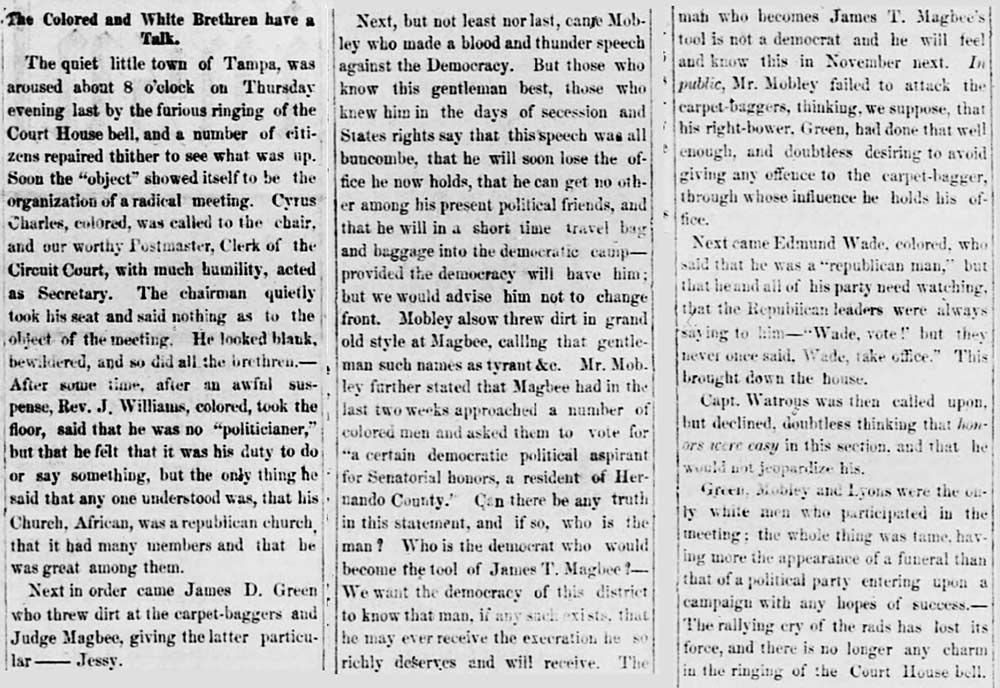
1870 - Nov. 9 -
Magbee on the rampage in Gainesville
"...and his Honor, after being
soundly pummeled, with his countenance disfigured, one eye in
mourning, his garments rent, and his flowing locks plentifully
powdered with the dust and sand of the street, was conveyed to
the back room of a bar and there laid out 'in state' on the bare
floor. His fame had preceded him, and when it was
announced that Judge Magbee's carcass was on exhibition, many
persons...passed in procession through the aforesaid bar room,
pausing for a moment, some to pity and regret, some to criticize
and deride, but most of the simply to 'see the monkey.'
There he lay, a mournful spectacle--dead to all surroundings,
dead to the jeer, the scoff and the smile of scorn, dead alike
to pity and to mockery, and--dead drunk."
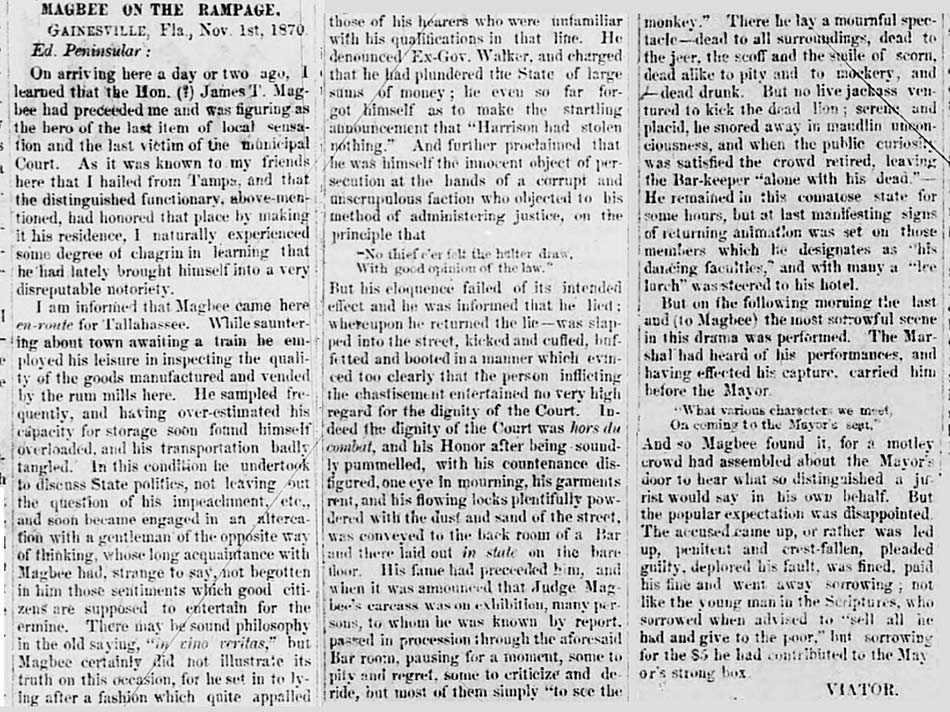
1871 -
Jan. 3 - Charges against Magbee dismissed
When the Legislature
reconvened on January 3, 1871, the previous enthusiasm for
Magbee's
impeachment had vanished. Assembly managers appeared before the
Senate and recommended that the case be dismissed, which was
accomplished by a vote of 19 to 0. Magbee’s counsel asked the
"court" to declare the Judge "honorably discharged." There was no
objection and Chief Justice Randall obliged, after which he
adjourned the "high court of Impeachment." The charges
against Magbee have been described as "flimsy" and "superficial"
and indeed they were.
Magbee's
impeachment, the first in Florida politics, contributed
little to the body of American impeachment precedents. It is
unusual only in that it was tinder consideration, in one form or
another, in three separate and distinct sessions of the
legislature. However, the time factor was not great, far less than
twelve months intervened between original investigation and
abandonment of the charges. In essence, the whole episode was no
more than an attempt to embarrass Governor Reed.
[VanLandingham cites
#150: Ewing "Florida Reconstruction Impeachments," 316-318;
Shofner, Nor Is It Over Yet, 212; Allen Morris, compiler, The
Florida Handbook, 1959-1960 (Tallahassee, 1960), 128.)]
Jan. 25, 1871 Florida Peninsular
Editor Henry L.
Mitchell's commentary on the withdrawal of Magbee's charges.
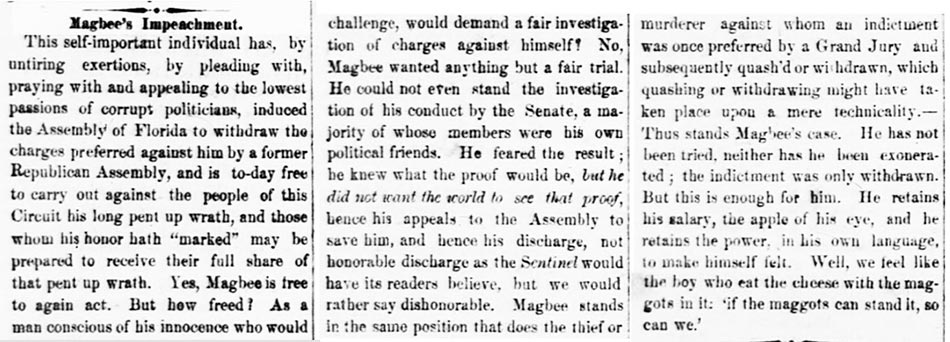
|

Prospects improve for a railroad line to Tampa
With the
legislature's approval of several railroad lines into south
Florida, and Hendry and Henderson's plan to build a line
from near Gainesville directly to Tampa, along with
investors organizing to build two lines, excitement again
was in the Tampa air, and the town’s prospects were boasted.
An 1871
"Commercial Convention" attempted to organize local efforts,
and its members prepared to notify the country of the area’s
"many natural advantages” to draw in business.
July 8, 1871 Florida Peninsular
(Edited for brevity.)
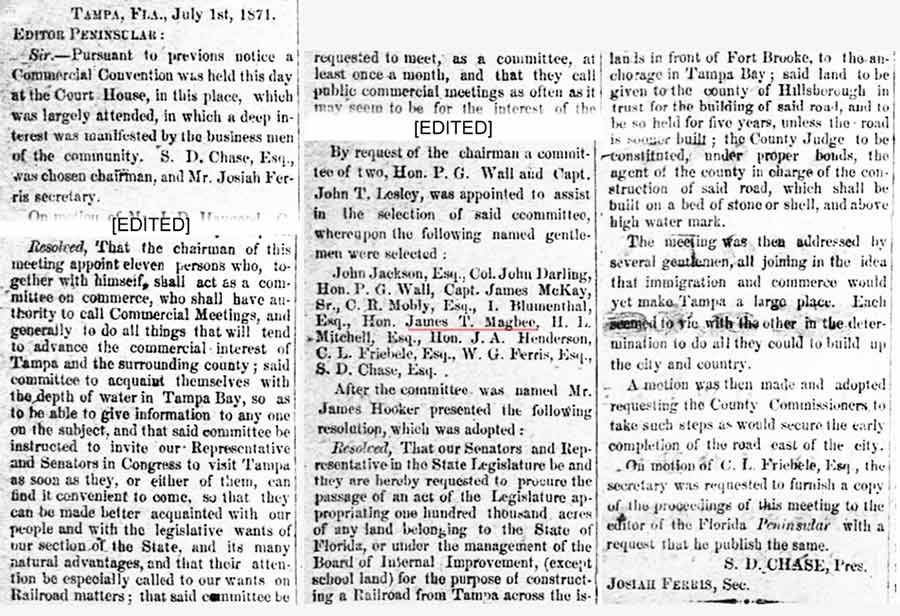
Francis
Vose derails Tampa's hopes
But within months, the hopes
of Tampa came crashing down. A
New York investor in Florida
bonds, Francis Vose, obtained a federal injunction barring
the state from granting land to support railroads.
Construction plans came to an immediate halt.
Tampa and the
Coming of the Railroad, 1853-1884, by Canter Brown, Jr,
in The Sunland Tribune, Volume XVII November, 1991 Journal
of the Tampa Historical Society. |
| |
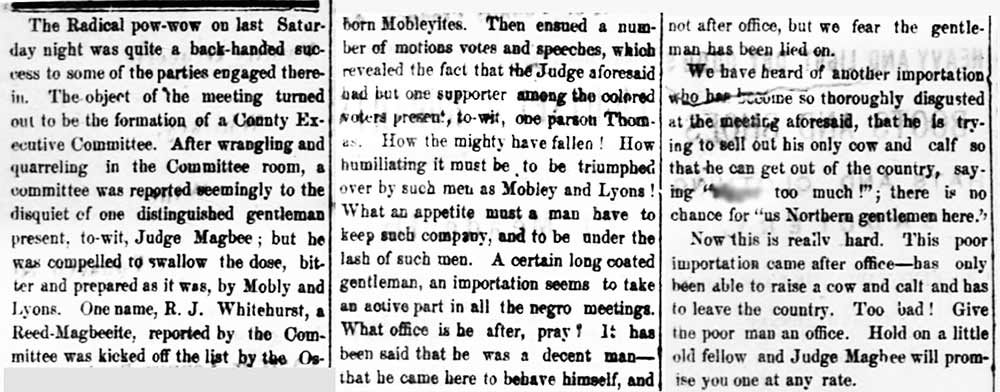
1871 -
Magbee's
drunken downfall at Franklin and Washington
Street
If the casual Tampa history fan
knows anything about James T. Magbee, it would most assuredly be
of this event. It seems to have become THE signature event
in Magbee's life, mainly due to the two or three most vivid images
it evokes in our "mind's eye." That is, passing out on the
sandy streets of Tampa, being covered with molasses and corn by
his enemies, and having his clothes ripped off by the roaming hogs
that feasted on the sweet mixture.
BUT DID THAT REALLY HAPPEN?
The coating of "sweet mixture" and
the "rooting hogs" tearing off his clothes are presented as
"additional indignities" in many historical accounts.
But just who or what was the original source
of these additional indignities?
According to
VanLandingham:
 One of the most embarrassing incidents in James T. Magbee’s life
occurred in the fall of 1871.
On
Oct. 16,
having returned from court at Brooksville,
"he fell dead drunk
in the sandy street at Franklin and Washington.” The
Peninsular reported that he "lay wallowing in the grime, the
slime, the odor of -- nature. By chance!!! additional indignities were
added.” One of the most embarrassing incidents in James T. Magbee’s life
occurred in the fall of 1871.
On
Oct. 16,
having returned from court at Brooksville,
"he fell dead drunk
in the sandy street at Franklin and Washington.” The
Peninsular reported that he "lay wallowing in the grime, the
slime, the odor of -- nature. By chance!!! additional indignities were
added.”
A group of his enemies “poured molasses and corn
over him. The delectable mixture was soon discovered by roaming
hogs. They rooted him around until they ripped off nearly all his
clothes."
He snored and
hours
later, the judge sobered enough to get up and go home.
We assume
the "added indignities"
were the "delectable
mixture" and the rooting hogs ripping off his clothes. VanLandingham cites
Grismer as the source of these additional indignities, see ** below.
But the Peninsular did not
mention either one.
VanLandingham obtained the
next day's events from the Peninsular:
On the next day, the 17th, drunkenly reminded of his own
(suffered) indignities, and in a terrible plight, revolver in
hand, Magbee wanted satisfaction. He encountered several, he
demanded satisfaction and he succumbed. He drank anew, and drank
again anew. He imbibed to inhibition, and he, lay despoiled of
his arms, such an object whereas Tampa never saw before. Half
clothed without countenance, witless of self, fortune and fame,
he lay prone in as clean a place as a stable.
**The
Oct. 21 article in the Peninsular (see image of it below)
makes no
reference to anyone pouring molasses and corn on Magbee as "added
indignities" or otherwise, nor does it mention roaming hogs at
all. The Peninsular was the only newspaper to cover
this event at the time it occurred. If this actually happened, why wouldn't the Peninsular have reported
it? Surely the Peninsular would have relished in
publishing this indignity.
So what was the
original source of the account of the delectable mixture and roaming
hogs? VanLandingham
cites Grismer p.156 for it.
Grismer on the delectable mixture
and the hogs:
Quite
naturally, Magbee had few friends among the Democrats. And
when he fell dead drunk in the sandy street at Franklin and
Washington on
November
[sic] 16, 1871, a group of townsmen poured
molasses and corn over him. The delectable mixture was soon
discovered by roaming hogs. They rooted him around until
they ripped off nearly all his clothes.
Hours later, the judge
sobered enough to get up and stagger home. He suspected James
E. Lipscomb of having planned the outrage and charged him with
contempt.
Grismer's account erred on the date,
stating it occurred on Nov.
16, 1871. Grismer has misread the Oct. 21st, 1871 article
in the Peninsular, which opens by alluding to their November
11, 1870 article "Magbee on the Rampage," because the Oct. 21, 1871
article in the Peninsular states:
"But Oh! Tampa!
the sixteenth day
of the present month of the good year 1871..."
and goes on to describe
the incident at Franklin and Washington Streets, but not the sweet
mixture and not the rooting hogs. Grismer
thought that the "present month" was November instead
of the present month of this article--October.
Grismer's
account makes it appear that the contempt charge on Lipscomb came
right after Magbee "staggered home." The contempt
charge did not come until the following year in March. The
Peninsular did not mention Lipscomb, nor anyone else being
suspected. The only mention of this is that on the next day, "...he encountered
several, he demanded satisfaction..."
Grismer doesn't
cite his work with footnotes, but rather, lists a bibliography at
the end of his book. The editor was D.B. McKay. Among his many sources are several
newspapers, one of which may have been the source of the "added
indignities" of the mixture and the hogs, but all were
written quite a long time afterwards.
Perhaps one of these papers may have interviewed a witness some
years later, if indeed a
newspaper story was Grismer's source of the sweet mixture.

So which of the above
newspapers could have written about the event and known what the "added
indignities" were?
The Tampa Herald
is listed at the Library of Congress as being published from
189? to 19??, based on: Vol. 1, no. 254 being Dec. 8,
1897. Latest issue consulted: Vol. 4, no. 222 (Nov. 3,
1900). If this was a weekly paper then this would cover a period
of about 5 years, putting its start around 1892 -- about 21
years after the event.
The Tampa Guardian
didn't exist yet; it was established in 1875 by Magbee. Nor did the Sunland Tribune exist yet; it was
established March 2, 1876. The name of The Sunland Tribune was
changed to The Tampa Tribune, March 1, 1883. Daily
publication of the Tribune started in 1895 when Wallace Stovall
upgraded printing from once a week. The Library of
Congress reports the Tampa Journal as starting in 1890, but sources used for
this Magbee feature cite Tampa Journals of 1877 (election of
George Sparkman as Tampa Mayor.) So the Tampa Journal would not have been around to report in
1871. The Tampa Times also came later. The True
Southerner published from 1868 to 1869 at the latest, according
to the
Library of Congress. Also, it was a Republican
newspaper, reportedly owned by Magbee, with Edward O.
Plumbe, editor. We know the
Peninsular didn't report it, and it ceased in 1874.
One of the above
newspapers which were started after the incident, may have
written a story in retrospect, and included the "added
indignities" as being the pouring on of molasses and corn, and
being "rooted by hogs" as subsequent knowledge. Any citizen of Tampa alive at the
time of the incident during the early years of these
publications might have added to the original story.
One final
observation: The Peninsular did make reference to Magbee
being "half clothed," but that was on the next day.
See
Roadsidethoughts.com "Newspapers
published in Tampa lists 74 Tampa newspapers and their
years.
The
original article as it appeared in the
Peninsular, Oct. 21, 1871
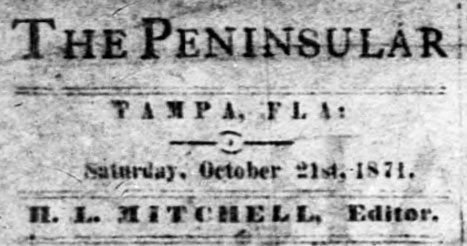
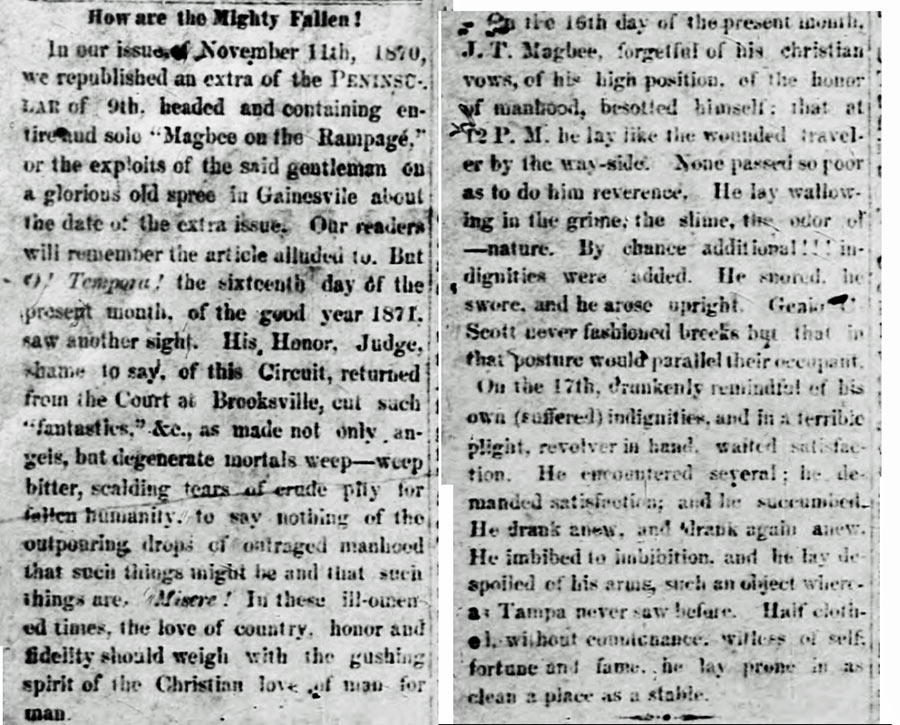
"...Magbee
besotted himself, that at 12 p.m. [noon] he lay like the
wounded traveler by the wayside. None passed so poor as to
do him reverence. He lay wallowing in the grime, the slime, the
odor of--nature. By chance additional!!! indignities
were added. He snored, he swore, and he rose upright.
G[illegible] Scott never fashioned
breeks but that in that posture would parallel their
occupant. On the 17th, drunkenly reminded of his own
(suffered) indignities, and in a terrible plight, revolver in
hand, wanted
satisfaction and he
succumbed. He drank anew, and drank again anew.
He imbibed to
imbibition, and he lay
despoiled of his arms...half clothed, without
[illegible]--chance, witless of self, fortune and fame, he lay
prone in as clean a place as a stable."
No mention of a sweet mixture,
molasses or corn, or roaming hogs.
How could the Peninsular not have reported this if it occurred?
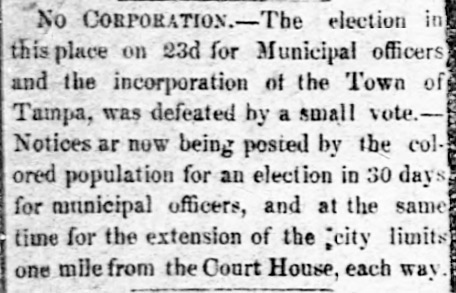 1871
- Oct. 23 Town of Tampa votes to not incorporate 1871
- Oct. 23 Town of Tampa votes to not incorporate
Florida
Peninsular, Oct 28, 1871 |
| |
|
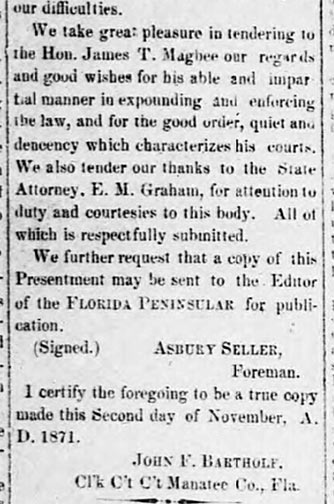 |
|
Florida
Peninsular, Nov 18, 1871 |
Public opinion of Magbee varies greatly
Magbee was criticized by local Democrats for "compelling white men
to serve on juries with Negroes. He was repeatedly charged with
showing rank favoritism while hearing cases." Yet, the
Manatee County Grand Jury, in its Fall 1871 presentment "took
great pleasure in tendering to the Hon. James T. Magbee our
regards and good wishes for his able and impartial manner in
expounding and enforcing the law, and for the good order, quiet
and decency which characterize his courts.”
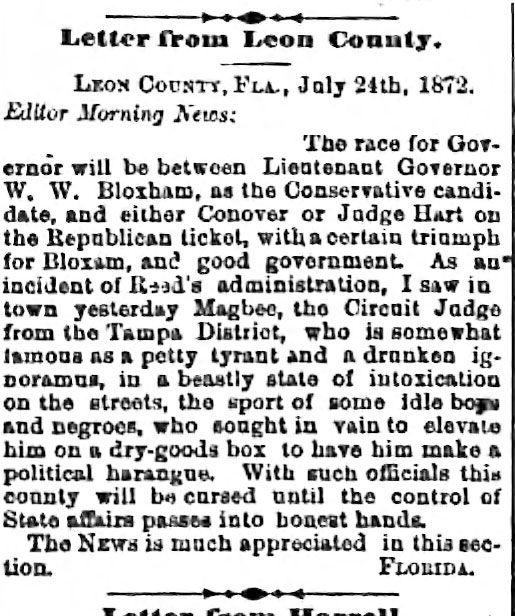
Savannah Morning News, Jul. 26, 1872 -- page 1
Magbee witnessed on the streets of Tallahassee on July 23rd,
"...who is somewhat famous as a petty tyrant
and a drunken ignoramus, in a beastly
state of intoxication"
| |
James Edgar
Lipscomb (no photos available)
Born: July 23, 1850 Died: April 8, 1882
Term: August 11, 1873 - August 13, 1876
Born in Leesboro, Alabama, Lipscomb moved to Tampa with his
sister Ida in 1869 where he worked as a clerk in William
Wall's general store. In 1876, he married Mary Friebele and,
shortly afterward her father, Christopher L. Friebele made
him co-owner of his store located on the corner of
Washington and Franklin Streets.
Lipscomb became involved in local politics and was elected
mayor in 1873 and re-elected for two more one-year terms.
In 1873, Lipscomb's administration moved against other
problems besides yellow fever. Fines were imposed on firing
guns, starting a riot or disturbing the peace, using a
wooden chimney or throwing animal parts into the streets.
Additional funds were raised by licensing hotels, vehicles
and professions; hotels with more than ten boarders, $10,
less than ten, $5, drays, $3, druggists, $5, physicians $2.50, lotteries, $10 and bowling establishments, $5. Further,
citizens were required to maintain the city roads and
streets.
After his last term as mayor, Lipscomb
returned to his business but returned in August 1877 to
serve as election inspector for the mayoral election. Two
years later, he was elected to city council where he served
under Mayor John Wall from August 13, 1879 to August 14,
1880. James Lipscomb passed away in Tampa on April 8, 1882.
City of Tampa Mayors |
1873 - August 11 - Tampa
becomes a Town, Lipscomb elected Mayor
By mid-summer of 1873 economic conditions had improved to such
an extent that the citizens decided that a municipal government
should be re-established.
On August 11,
1873, a public meeting of “persons residing within the original
160-acre township” took place at the County Courthouse
and the 48 electors who attended voted to incorporate, this
time as a town instead of as a city. The vote
was 48 to 0 for incorporation as a town.
James Edgar Lipscomb, at
age 23, was voted the first mayor of the Town of Tampa.
Charles Hanford, clerk, and John G. Robles, marshal.
Councilmen elected were W. T. Haskins, E. A. Clarke, John T.
Lesley, Josiah Ferris and Henry L. Crane. Soon afterward, the
first town seal was designed and adopted. It showed a
palm-surrounded waterfront with a few sail and steamboats in the
foreground.
The
corporation went by the name Town of Tampa until it was granted
its second City Charter by the Florida State Legislature in 1887.
The Mayors of Tampa 1856 - 2015
Tampa, A History of the City,
etc by Karl H. Grismer
|
1873 - Assassination attempt on Magbee
|
During the fall 1873 term of court in Manatee County, Magbee was
the victim of an assassination attempt. As he was sitting in the
parlor of his Pine Level boarding house someone fired a shot through
a window at him." The pressure began to show on the judge and
his heavy drinking increased. |
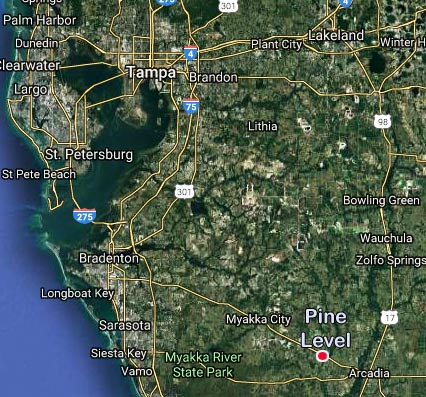 |
|
Savannah Morning News, Dec. 12, 1873 -- page 1
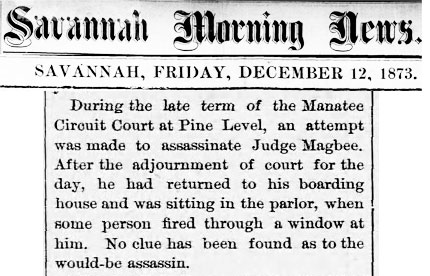 |
|
|
|
|
Savannah Morning News, Dec. 31, 1873 -- page 1
Marianna Courier: Some
extravagant and reckless assassin in Manatee county
squandered a good load for a double -barreled gun by
expending it in a fruitless effort to murder Judge Magbee.
If he had struck his mark and accomplished his purpose he
would not have obtained value received. |
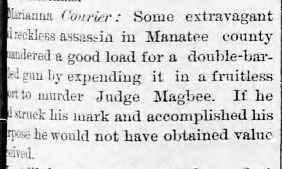
|
1873 - Dec. 31 - Jan 1, 1874 - Magbee jailed for drunk & disorderly conduct &
his Habeas Corpus stunt
This section reflects
the writings of four Florida authors and historians--Kyle VanLandingham, Karl Grismer,
D. B. McKay, and Jefferson Beale Browne. Where their
writings record essentially the same information, the details
have been combined. But where their versions of the events
differ, they have been presented here separately.
On
New Year's Eve, 1873, in Tampa, Magbee over-imbibed again and
"became involved in a street row
[fight], was arrested by
Marshal O.
H. Dishong,
and hauled before now mayor James E. Lipscomb." Magbee was fined
for drunk and disorderly conduct by Mayor Lipscomb but Magbee refused to
pay. He was ordered locked up in the town jail until morning.
Recovering from his
alcoholic stupor, Magbee called his wife to the jail, and had her
bring the necessary papers, then issued a Writ of Habeas
Corpus
“commanding the mayor to bring the body of James T. Magbee before
His Honor James T. Magbee to show by what authority the mayor was
depriving him of his liberty."
According to
historian Karl Grismer, the marshal obeyed the order:
"The
marshal could do nothing but obey and of course the judge released
himself as soon as he was taken to the courthouse. He thought so
well of his strategy that he later wrote up the case for law
journals."
Jefferson B.
Browne, in his
Key West: The Old and the New, 1912,
said the mayor disregarded the writ, as it deserved to be:
While Magbee was in the city jail for public drunkenness, the
most remarkable proceedings ever witnessed in a court of justice
occurred. While in jail, Magbee issued a writ of habeas
corpus, commanding Mayor Lipscomb to bring the body of JAMES
MAGBEE before His Honor, James Magbee, to show by what authority
he was depriving him of his liberty. Magbee had the writ
served on Mayor Lipscomb, who treated it with merited contempt.
Kyle VanLandingham says:
"The writ 'utterly failed' and the
officials 'paid no attention' to it. Magbee reportedly 'paid
his fine and apologized.'”
VanLandingham cites this with footnoted sources:
Savannah
Morning News, April 9, 1874; Bartow Courier-Informant, August 1,
1912; J. Beale Browne, Key West, 68-69. He also notes:
McKay reported that the writ was successful and Magbee was
released. McKay, Pioneer Florida, II, 377; Tampa Tribune, November
23, 1952. Also, see Grismer, Tampa, 156.
But Magbee did not forget the incident and Mayor Lipscomb and Marshal Dishong were summoned to appear before the spring term of the
March (23) 1874
court on a charge of contempt. The culprits were fined $100
each and ordered jailed for ten days. Henry L. Mitchell and John
A. Henderson, representing the defendants, asked the court to stay
the ruling but Magbee refused.
J. B. Browne's account also says the writ of habeas corpus was
disobeyed:
When the judge was released from jail, he issued a rule for the
mayor to show cause why he should not be punished for contempt
of court in refusing to obey the writ, and made public his
intention to send the mayor to jail. People from all parts
of the county came to town to protect the mayor from the
threatened outrage, and the courthouse was filled with armed and
determined men.
1874 - March 23, Spring term, hearing
day - The Lipscomb courtroom shotgun incident
Whose shotgun and was a shot
fired?
According to Jefferson B.
Browne:
At the hearing, the judge overruled the defendant's plea and
sentenced him to jail. In an instant, Mayor Lipscomb
snatched a double-barreled shotgun from one of the bystanders
and leveled it at the judge, but before he could shoot, he was
surrounded by his friends and escorted out of the court in
defiance of the judge. No attempt was made afterwards to
enforce the order. This incident was one of the minor
outrages of that era.
|
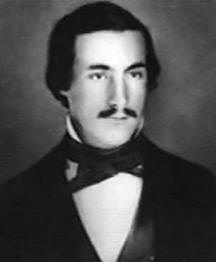 |
|
E. A. Clarke
10th mayor of Tampa |
VanLandingham says,
"Lipscomb reportedly 'snatched a shotgun' from a man standing
nearby and threatened to shoot the judge. He was disarmed and
walked out, but before leaving the courtroom issued a vicious
diatribe against Magbee. Reportedly, Magbee attempted to form a
posse to carry out the court's sentence but no one responded."
Grismer says, "On
the hearing day, Lipscomb went into court armed with a shotgun.
He
pointed it at the judge and pulled the trigger. But just then E.
A. Clarke struck the barrel and the load of buckshot went into the
ceiling. Although he escaped, Magbee was so frightened that he
dismissed the case."
D. B. McKay, who
relied on Grismer, writes in
his three-volume
Pioneer Florida,
Volume 2, Chapter 10, A Self-Made
Scalawag:
On the day set for the hearing Lipscomb left his store carrying
a shotgun. E. A. Clarke, whose store was opposite that of
Lipscomb on Washington street, saw him and knowing his hot
temper followed him. Lipscomb went into the court room with his
gun and sat down on the front bench directly in front of the
judge's rostrum. Mr. Clarke sat beside him. When Magbee ordered
Lipscomb to plead to the charge, the latter stood and aimed the
gun at the judge, but as he fired Mr. Clarke struck the barrel
of the gun and the load of buckshot was deflected into the
ceiling of the court room. And that ended the case.
Of
particular importance is VanLandingham's sources footnote on the
courtroom shooting incident:
Savannah Morning News, April 9, 1874 (See
image below);
Bartow Courier-Informant,
August 1, 1912; Tampa Tribune, November 23, 1952. Grismer
confused the Lipscomb courtroom shooting incident, placing it in
1871. Grismer Tampa, p156. The mistake was repeated by D.B. McKay,
Pioneer Florida, II, pp378-379.
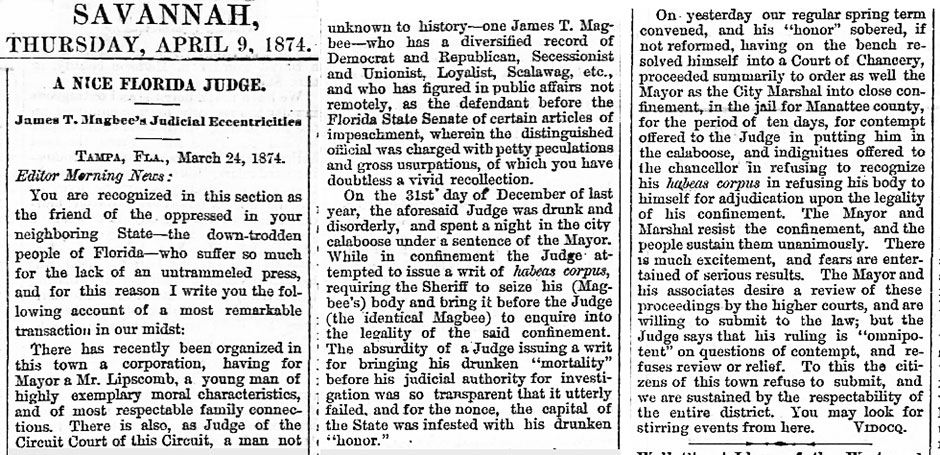
The writ "utterly failed," no mention of
a shotgun or shots fired
at the March 23rd hearing.
Savannah Morning News, Apr. 9, 1874 -- page 1
The Ocala Banner carried the whole story-- March 17, 1905 (31
years later).
Its author is anonymous and signs only as "South Floridian."
"Written especially for the Ocala Banner."
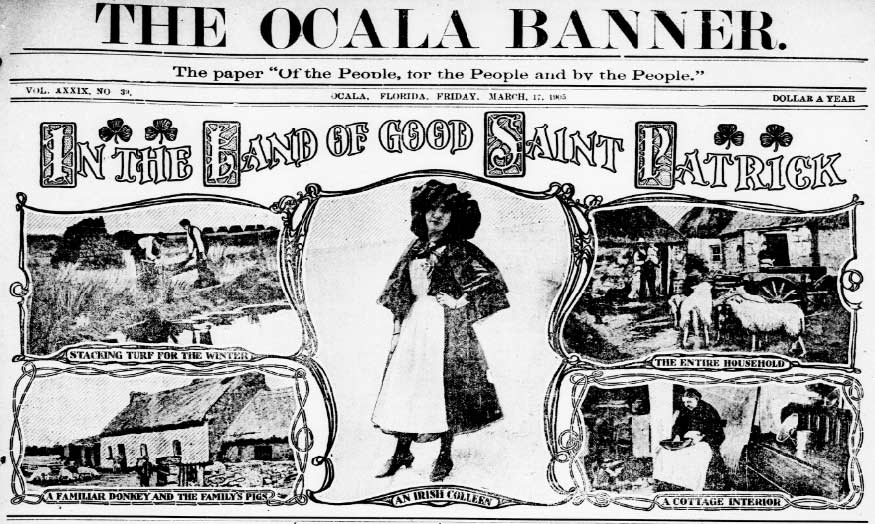
This article is quite accurate with these events in Magbee's
illustrious life, as found in articles published at the time of
the events.
INCLUDED is an example of how this event has been
perverted over the years. The 1921 Tampa Times article not
only says the Habeas Corpus stunt worked, it comes up with new
drama about Magbee arraigning himself and finding himself
guilty.
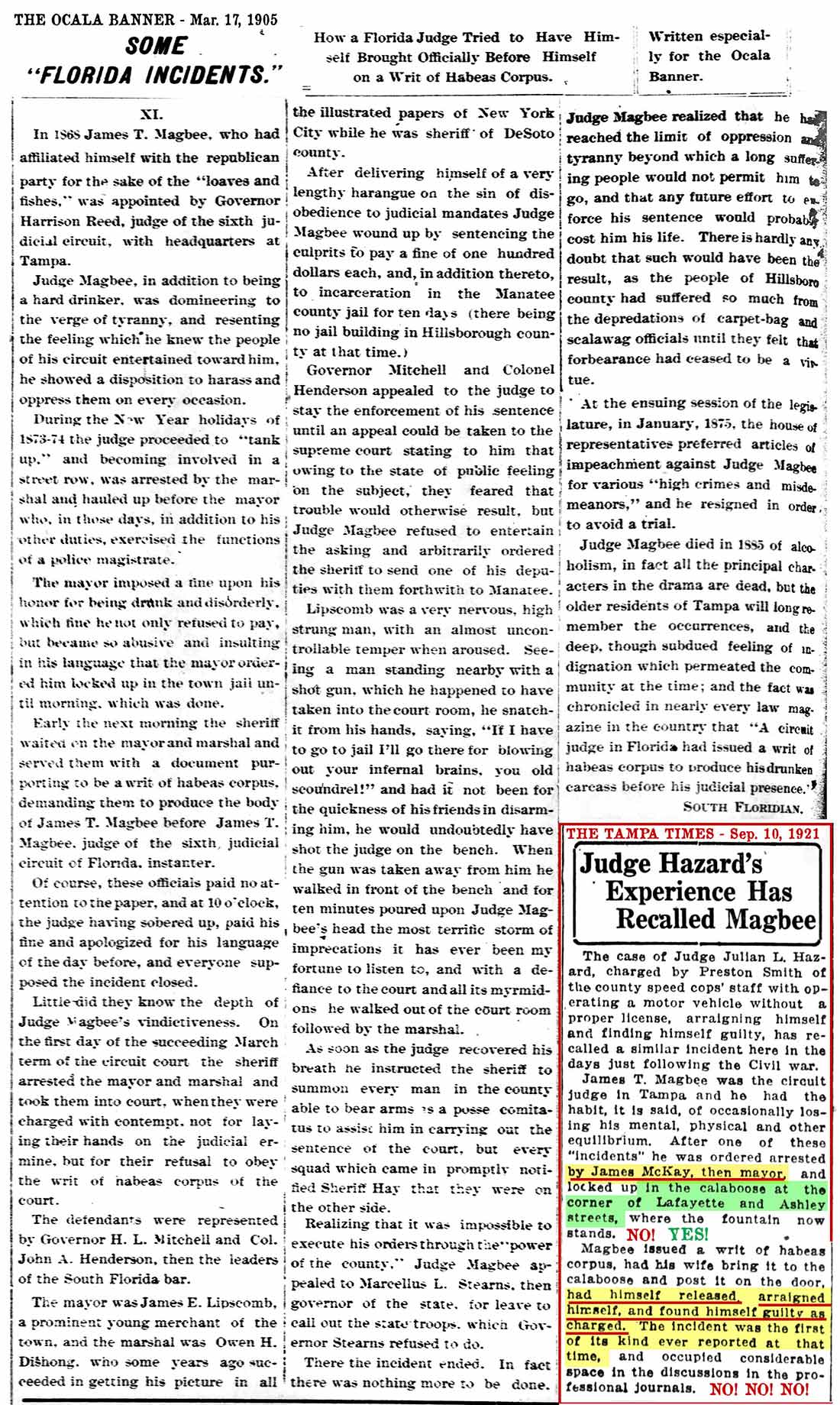
Summary of the Habeas
Corpus event:
Magbee is drunk during the New Years
holidays of 1873-74. He gets involved in a street fight and
is arrested by the marshal and is brought before the mayor's
court. The mayor fines Magbee, but Magbee refuses to pay and
becomes abusive. He is locked up in jail until morning.
Magbee has the mayor and
marshal served with a writ of habeas corpus and it is ignored.
The next day, Magbee sobers up and apologizes.
In the March term of the circuit
court, 1874, the mayor and marshal are arrested and taken to court
before Judge Magbee where
they are charged with contempt for refusing to obey the habeas
corpus writ.
Mayor Lipscomb and Marshal Dishong are the defendants, future
governor H.L. Mitchell (editor of the Peninsular) and John Henderson are their attorneys.
Reference is made to Dishong later having his picture in illustrated
papers of New York City while he was sheriff of DeSoto County.
After lecturing the defendants on
the "sin of disobedience to judicial mandates" Magbee fines them
$100 each and jail for 10 days (in Manatee County, there
apparently being no jail in Tampa. Or possibly, no room in
the jail?). Mitchell and Henderson appeal to Magbee to stay
the sentence until an appeal could be taken to the supreme court,
citing that public opinion would otherwise cause much trouble, but
Magbee refuses and orders the sheriff to send a deputy to escort
them to Manatee Co.
Lipscomb, a proven temperamental
man, snatches a shotgun from a bystander and threatens if he goes
to jail it would be for "blowing out your infernal brains, you old
scoundrel!" Friends disarm Lipscomb, no shots are fired, and
Lipscomb proceeds to "pour upon Magbee's head the most terrific
storm of imprecations" that the writer had ever heard. Then
in defiance to the court, Lipscomb and the marshal walk out of the
courtroom.
After Magbee composed himself, he
ordered the sheriff to round up a posse, but none would enjoin due
to their siding with Lipscomb and the marshal. Magbee then
appealed to Gov. Stearns to call out state troops, but he refused,
and there the incident ended.
The writer,
apparently an eyewitness to the event. To wit, "...the most terrific
storm of imprecations it has ever been my fortune to listen to."
He
goes on to say:
"Judge Magbee
realized that he had reached the limit of oppression and
tyranny beyond which a long suffering people would not permit
him to go, and that any future effort to enforce his sentence
would probably cost him his life. There is hardly any
doubt that such would have been the result, as the people of
Hillsboro [sic]
county had suffered so much from the depredations of carpet-bag
and scalawag officials until they felt that forbearance had
ceased to be a virtue."
1874 - Sept. 1 - Savannah Morning
News carries a story from Magbee's Aug. 22nd Tampa Guardian

Savannah Morning News, Sep. 1, 1874 -- page 1
1874 - 1875 Pranks on
Magbee & more reports of public drunkenness
From D. B. McKay's
Pioneer Florida, Volume 2, Chapter 10, "A Self-Made
Scalawag", 1959:
On another spree someone shaved the hair off one side of Magbee's
head and covered the bare scalp with red paint.
Magbee drove a pair of ponies hitched to a buggy to make his court
appointments. In Brooksville after a session of court he indulged
his appetite for liquor freely, got into his buggy to drive back
to Tampa but had moved only a few yards when all four wheels fell
off--someone had removed the nuts.
Possibly the same
event,
as with many incidents in Judge Magbee's escapades, is presented
differently in this
2007 St. Pete Times article about
the old Hernando County courthouse. It is a somewhat
different version as told by Jesse Hope in McKay's Pioneer
Florida:
One memorable prank
involved Circuit Judge James T. Magbee, who had lost his
effectiveness with the people of Hernando County. According to F.B.
Coogler: "One night just before court was scheduled ... there was
a little jackass strapped sitting up in the judge's chair with his
feet on the desk. The judge came in (the next morning), looked at
the jackass and walked out- called for the clerk to get his horse
and buggy. "The clerk said, 'Judge how am I going to get your
horse and buggy - where is it?' 'It's down there in that stable.'
The clerk replied: 'No sir, come here I'll show you.' He took him
around behind the courthouse. There was the buggy hung up in an
oak tree, and the horse was gone. The judge said: 'Mr. Clerk, get
my horse and buggy or I will leave this town and I will hold no
court.' " Magbee left town and never returned.
Magbee was reported
publicly drunk in Jacksonville on May 15, 1874 and in Bartow on
June 1. en route to Tallahassee, and stopping at Cedar Key on
January 3, 1875, he was arrested for "drunkenness and... riotous
and disorderly conduct" and was confined in the town "calaboose."
In Tallahassee, he appeared drunk at the Assembly Hall of the
State Capitol "in the presence of both Houses of the
Legislature...and in the presence of the Governor," cabinet and
other high officials on the occasion the Governor's annual
address.
|
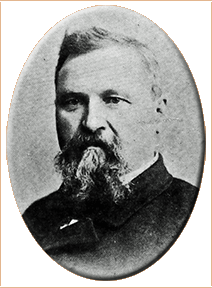 |
|
Marcellus Lovejoy
Stearns
Florida's 11th Governor
Mar. 18, 1874 - Jan. 2, 1877.
Photo from Florida Memory,
State Library & Archives of Florida |
1875 - Another call for Magbee's impeachment
This was the last
straw. Dade County Assemblyman William Watson Hicks demanded an
investigation which resulted in new Articles of Impeachment
against Magbee. Six specifications were presented, all involving
his drunken behavior during the past year.
On February 16, the
Assembly voted 29 to 19 in favor of impeachment, less than the
two-thirds required. Then a resolution was offered by a Magbee
supporter calling for an investigation into Assembly members who
had been "Intoxicated" during the present session and declaring
those seats vacant. The maneuver backfired when Hicks offered a
substitute calling for an investigation of drunkenness by members. Another vote was taken on the impeachment articles and this time
they were approved, 34 to 11.

1875 - February 17 - Magbee
resigns
But there was to be
no trial. Fearing conviction by the Senate, Magbee tendered his
resignation to Gov. Stearns the following day, February 17, 1875.
Savannah Morning News, Mar. 2, 1875 -- page 1
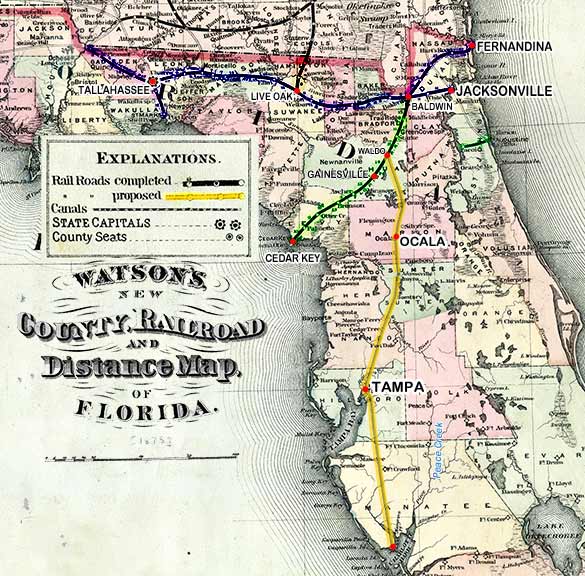
Florida Railroads in 1875
Proposed
1875 - Magbee resumes law practice in Tampa, becomes newspaper
editor, and adopts a son
Magbee came back
to Tampa, resumed his law practice and started the Tampa
Guardian newspaper. As editor of a newspaper, Magbee now had a forum to
expound his views to the public.
The masthead proclaimed it would be "Independent in Everything,
Neutral in Nothing." The "Guarding Building" was
located on the northwest corner of Polk and Franklin streets. His
residence was adjacent to the office, on Franklin Street, and
Magbee owned the entire block.
His wife Julia became assistant
editor and the childless couple adopted a son, Archie Donnelly, who also
learned the printing trade.
(More about Archie at the
end of this feature.)
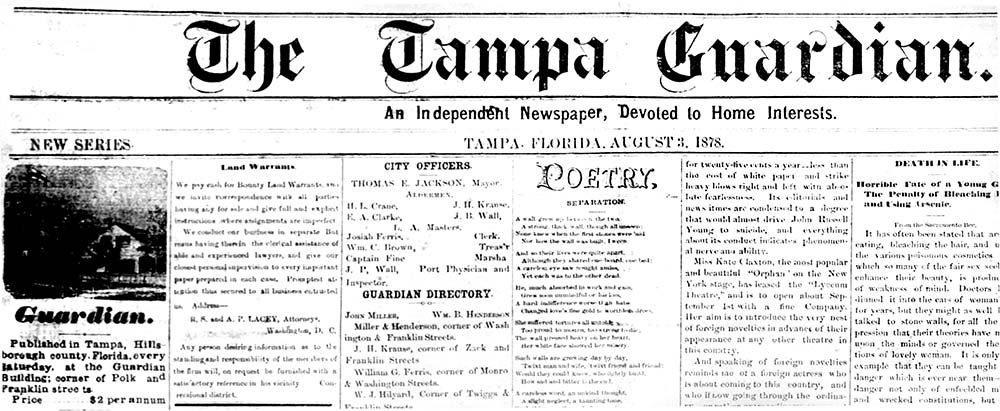
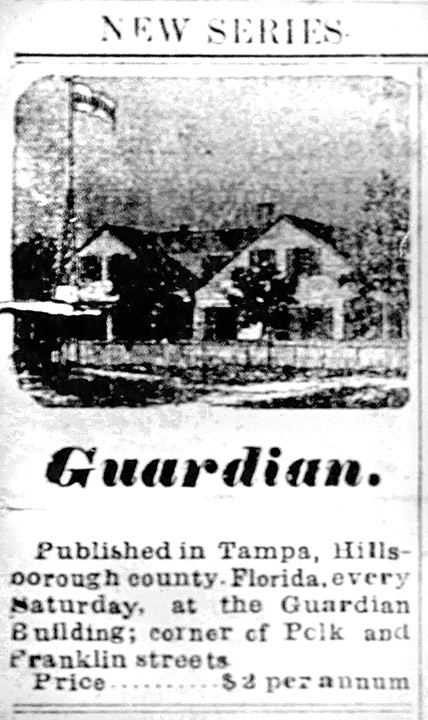
|
Magbee attempted to address and
resolve his drinking problem by becoming a charter member of the
Order of Good Templars, a temperance organization. His wife joined
him in membership but controversy followed.
Worthy Chief Templar
was Dr. John P. Wall, also noted for his former drinking habits. When
Wall's half-brother, Joseph Baisden Wall, a local attorney, was proposed for
membership, Magbee objected. Shortly after, Magbee was charged
with violating his pledge by becoming intoxicated and was
expelled. His wife was also expelled on the charge that she had
cast two blackballs against the admission of Wall. |
The only known image of the
Guardian building where Magbee lived and printed his newspaper
appears on the front pages of some issues from 1878 where
subscription pricing is shown.
|

Savannah Morning News, May 19, 1875 -- page 1 |

Savannah Morning News, Aug. 7, 1875 -- page 1 |
|
|
|
|
 |
 |
|
Savannah Morning News, Aug. 14, 1875 -- page 1
|
Savannah Morning News, Sep. 11, 1875 -- page 1 |
|
|
|
|
 |
 |
|
Savannah Morning News, Oct. 5, 1875 -- page 1
Magbee appointed as Notary Public by Gov. Stearns |
Savannah Morning News, Nov. 16, 1875 -- page 1 |
|
|
|
|
 |
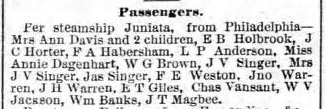 |
|
Savannah Morning News, Jul. 7, 1876 -- page 1 |
Savannah Morning News, Aug. 19, 1876 -- page 4
This one is interesting
because in 1885 Magbee would marry a young lady from Philly. |
|
|
|
|
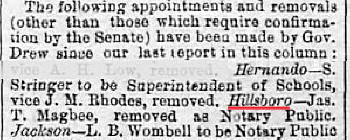 |
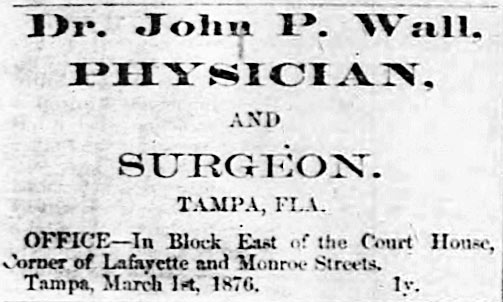
Monroe St. was renamed Florida
Ave. in the 1880s. |
|
Savannah Morning News, Feb. 9, 1877 -- page 1
Magbee removed as Notary by Gov.
Drew |
Sunland Tribune,
July 28, 1877 --p John Wall ad
|
|
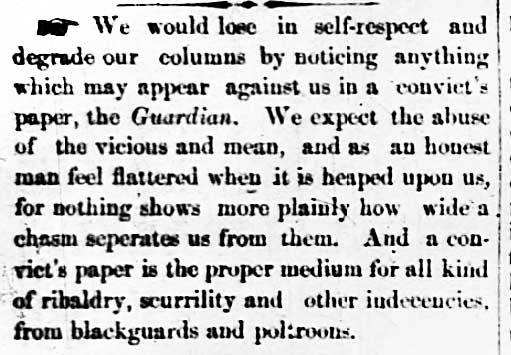
(Above)
Sunland Tribune, August 17, 1878 --p2
Dr.
John P. Wall considers the Guardian to be "a convict's
paper--the proper medium for all kind of ribaldry, scurrility
and other indecencies, from blackguards and poltroons."
Sunland Tribune, August 31, 1878
(Right)
Another Bait of Crow
Criticism of Gov. Drew, who when campaigning for governor,
promised not to appoint anyone to office without conforming
to the will of the people and the party which put him in
power. Despite delegates' request to have Magbee removed
as State Notary during the previous governor (Stearns) term,
Drew reappointed him as Notary anyway. Democrats take
it as an insult.
|
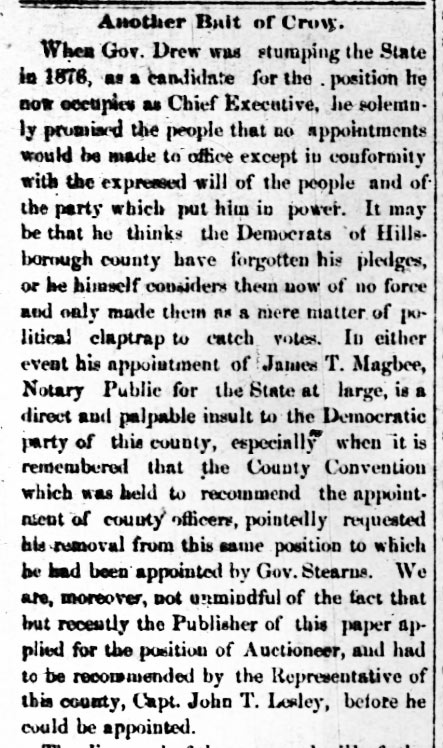
|
|
1877 - 1878
With
the end of Reconstruction, emboldened Democrats often sought
revenge against their former enemies. Magbee was indicted April
13, 1877 by the Polk County grand jury for "maliciously
threatening an injury to the person of another with intent thereby
to extort pecuniary advantages." A year later, on April 10, 1878,
he was convicted but Magbee succeeded in having the verdict set
aside with an order for a new trial. Another year passed and the
charges were dismissed on May 19, 1879. |

Savannah Morning News, Sep. 20, 1877 -- page 1 |
|
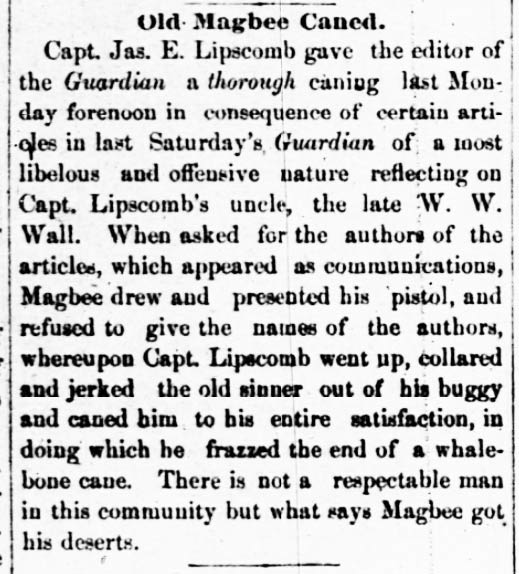
Sunland Tribune, August 17, 1878 --p3 Caning
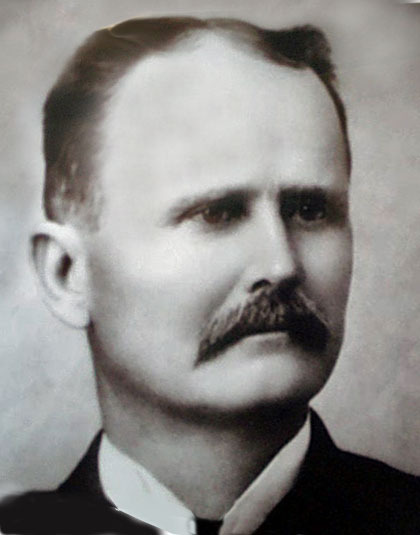
Joseph Baisden Wall prospered as a lawyer, entered politics, and
by 1886 was President of the State Senate. He was hot
tempered like his nephew-in-law, James E. Lipscomb.
Portrait from the 10th Judicial Circuit Court of
Florida |
The Lipscomb caning incident
On August 12, 1878, Magbee was caned on the streets of Tampa.
James E. Lipscomb, the former mayor who had (reportedly) tried to
kill
Magbee in 1874, accosted him about an Aug. 10, 1878 article in his
newspaper, the Tampa Guardian, which he considered offensive to
the late William W. Wall, Lipscomb's former employer and the
uncle of his wife. According to the Democratic Sunland
Tribune, Lipscomb asked for the author of the article and Magbee "drew a pistol." Lipscomb "collared and jerked the
old sinner out of his buggy and caned him to his entire
satisfaction.” |
|
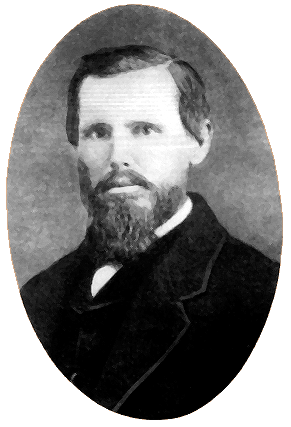 William
"Billy" Washington Wall, a son of Judge Perry
Green Wall, was a well-respected Tampa
businessman. His death in 1878 was considered a serious
calamity by all of Tampa. In 1884, Billy's mercantile
business was resurrected. Henry Laurens Knight, a son-in-law
of Billy Wall, formed the Knight & Wall Company with Billy's
young son, Perry G. Wall, II, who was only 17 at the time.
(Photo below.) William
"Billy" Washington Wall, a son of Judge Perry
Green Wall, was a well-respected Tampa
businessman. His death in 1878 was considered a serious
calamity by all of Tampa. In 1884, Billy's mercantile
business was resurrected. Henry Laurens Knight, a son-in-law
of Billy Wall, formed the Knight & Wall Company with Billy's
young son, Perry G. Wall, II, who was only 17 at the time.
(Photo below.)
Perry's uncle and financial
guardian, Edward A. Clarke (a former mayor of Tampa)
authorized all the necessary legal documents and from the
resources of the estate he financed Perry as a partner in
the business. |
|
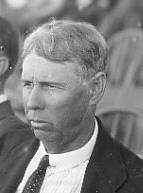
The firm was originally
known as Clarke and Knight but the business name was changed
to Knight and Wall in 1888 when Perry turned 21.
Perry (right) was
the 41st mayor of Tampa. Joseph Baisden Wall was
Perry's uncle, a half-brother of Dr. John P. Wall.
See Knight & Wall
feature here at TampaPix
|
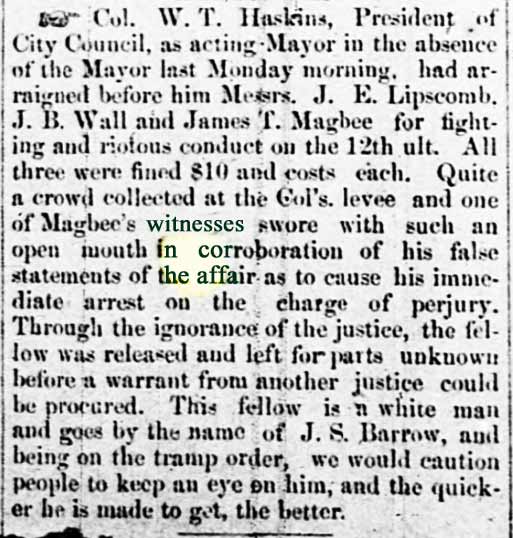
Sunland Tribune, Sept. 7, 1878
(Right)
Lipscomb, Wall & Magbee are arraigned in Mayor's court for fighting & riotous
conduct on September 2, 1878, with acting Mayor W.T. Haskins, Pres. of City Council,
presiding in absence of the Mayor (who was none other than
newly-elected Dr. John P. Wall.) A witness for Magbee
commits flagrant perjury but due to oversight is released
and he runs. A warrant is issued for him, J. S. Barrow, a
"white tramp."
The green text in
the yellow area represents digital repair to a hole in the
image.

Sept. 14, 1878 -
Sunland Tribune
Joseph B. Wall's response to Magbee's caning by
Lipscomb. (Below)
In a Sept. 11 letter to the Tribune, (of which his
half-brother is editor) J. B. Wall denies that any member of the
Wall family touched Magbee, and that he was the only Wall
family member present at Lipscomb's caning of Magbee.
He goes on to justify the caning by saying that Magbee is sufficiently young and
strong enough to be vicious, and therefore "by all social
laws amenable to chastisement," a fact Magbee was prepared
for by going out armed with a pistol ready and cocked on the
seat of his buggy. (Magbee was
58.)
Wall goes on to say that in
the Mayor's court, Magbee claimed that he had no
foreknowledge of the Aug. 10 article in the Guardian which
mentioned Wm. W. Wall, but that former mayor Thomas Jackson
swore on the stand that Magbee had told him about the
articles on the previous day of its publication. |
|
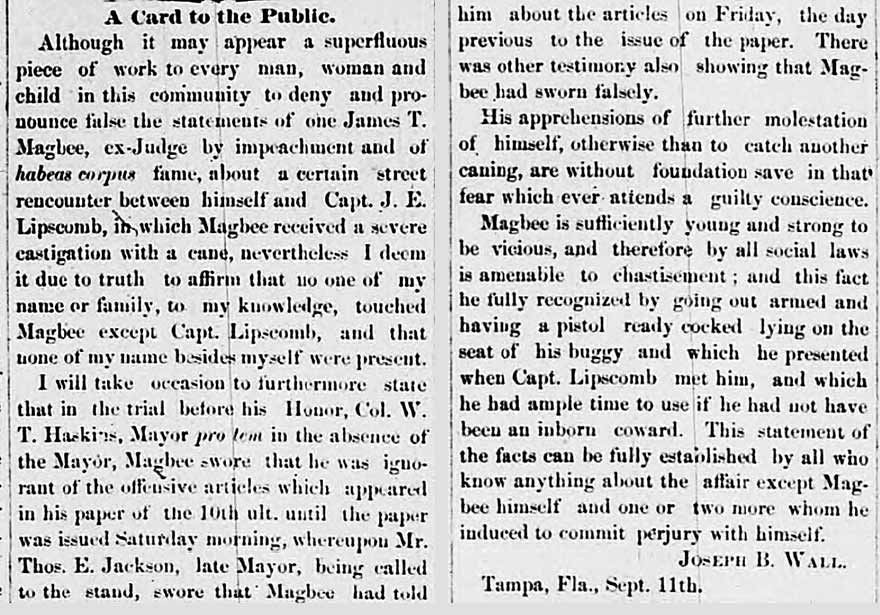 |
|
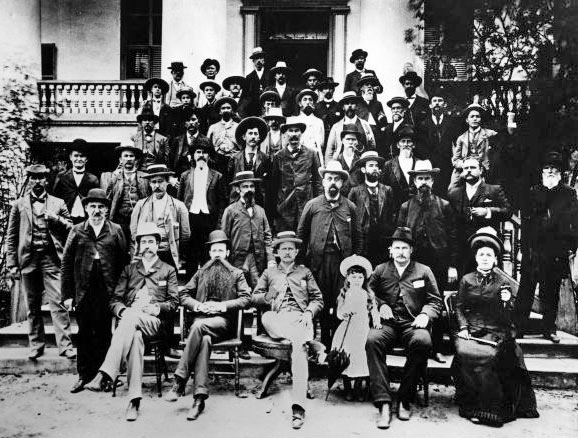 |
|
Florida
Senate of 1889 and several of their family members.
Sitting in the middle holding a gavel is Senate
President Joseph B. Wall.
State Archives of Florida/Harper |
Joseph Baisden Wall
(23
January 1847 – 29 December 1911) 1899 – 1911 Circuit Court
Born in Hernando County,
Joseph B. Wall was the son of Judge Perry Green Wall. He studied
law at the University of Virginia 1868-1869. He began his
practice at Brooksville, Florida before relocating to Tampa
in 1872 where he practiced with Henry L. Mitchell. J. B. Wall's career included
service as State Attorney in 1874. In 1882 he participated
in a lynching of a white man outside the courthouse in
Tampa, and was barred from federal practice.
He was elected to the
Florida Senate in 1886, President of the Florida bar in
1887, and served as the President of the Florida Senate in
1889. He was appointed judge of the Criminal Court at
Hillsborough County by Governor Mitchell in 1893 and to the
6th Judicial Circuit by Governor Bloxham in 1899.
Read more
about J. B. Wall and his hot temper, along with incidents of
the caning of James T. Magbee, and his assistance in the
lynching of a rape suspect, here at "Knight
& Wall" |
|
Judge
J. B. Wall information from the 10th Judicial Circuit Court of
Florida |
|
|
 Occasionally during the 1870s rumors circulated that
the Vose Injunction would be lifted. In 1877 the
possibility seemed so likely that area men met again
in Tampa to organize a line. Called the Tampa, Peace
Creek and St. Johns Railroad, it was intended to
connect Tampa and Jacksonville. The road was
chartered, and surveys were conducted. Soon its name
was changed to the Jacksonville, Tampa & Key West
Railway, and William Van Fleet was named as its
president. For the moment, though, no construction was
undertaken. Meanwhile, 1879 two rival lines were
chartered. One eventually was known as the Florida
Southern Railroad, and it also enjoyed the support of
south Florida's increasingly wealthy cattle interests.
The second was the South Florida Railroad Company,
which proposed a line from the St. Johns River to
Tampa or Charlotte Harbor. Occasionally during the 1870s rumors circulated that
the Vose Injunction would be lifted. In 1877 the
possibility seemed so likely that area men met again
in Tampa to organize a line. Called the Tampa, Peace
Creek and St. Johns Railroad, it was intended to
connect Tampa and Jacksonville. The road was
chartered, and surveys were conducted. Soon its name
was changed to the Jacksonville, Tampa & Key West
Railway, and William Van Fleet was named as its
president. For the moment, though, no construction was
undertaken. Meanwhile, 1879 two rival lines were
chartered. One eventually was known as the Florida
Southern Railroad, and it also enjoyed the support of
south Florida's increasingly wealthy cattle interests.
The second was the South Florida Railroad Company,
which proposed a line from the St. Johns River to
Tampa or Charlotte Harbor.
Tampa and the
Coming of the Railroad, 1853-1884, by Canter Brown, Jr,
in The Sunland Tribune, Volume XVII November, 1991
Journal of the Tampa Historical Society. |
| |
1878 - Magbee runs again for State Senator
It was in this climate that Magbee reentered the political
arena as a candidate for the State Senate in 1878. His
opponent was John T. Lesley and the Sunland Tribune poured
vitriol upon Magbee until election day.
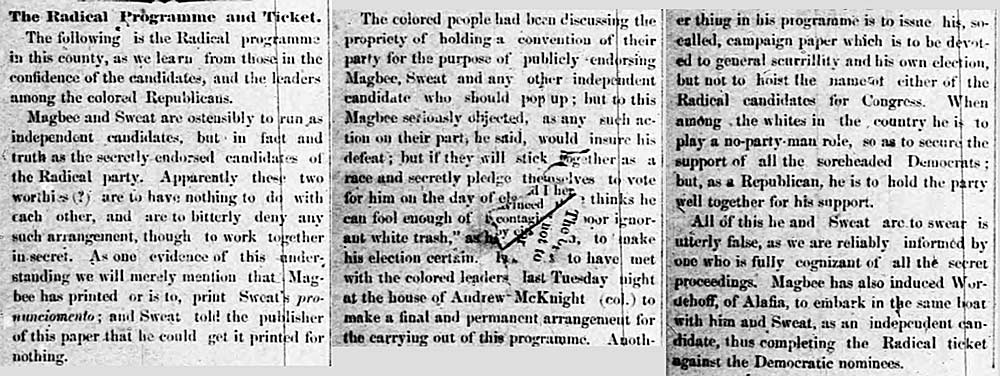
Sunland Tribune, Oct 5, 1878 p2 Radical
program
and ticket
J.P. Wall alludes to secret collusion between Magbee and
Sweat who are expected to run as independent candidates.
Sunland Tribune, Oct 12, 1878 p2
The County Democratic Nominees - J. P. Wall praises
the members of the Democratic convention for nominating
men...
"known to be true and
good--men of irreproachable character and worthy of the
confidence of the people...that not one of them is an
office seeker, and in consenting to accept the honor...as
true, high-minded men, every other motive save that of
genuine patriotism, to serve the people to the extent of
their best ability."
"The idea that they
represent any ring or clique in Tampa or elsewhere is too
absurd to be entertained for a moment, and is only worthy
of that class of men whose envious natures close their
souls to every liberal thought or generous impulse."
|
Sunland Tribune, Oct 26, 1878
Editor Wall pulled out all the stops in the October
26, 1878 issue. Readers were reminded of Magbee's
second impeachment for "drunkenness
and incompetency," his attempt to hang James McKay in
1861, and his fining of William B. Henderson for contempt in
1868. Magbee was accused of bringing his "90 year old"
mother into town on an “ox cart" from her home
sixteen miles east of Tampa to complain about articles
against her son. |
|
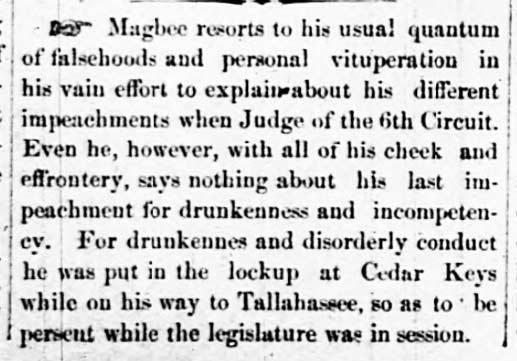
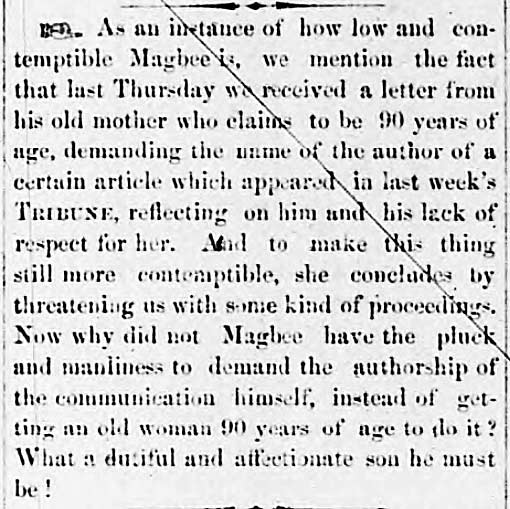 |
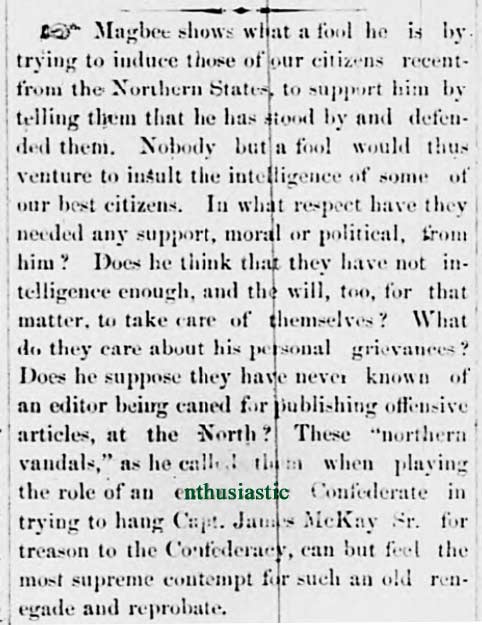 |
|
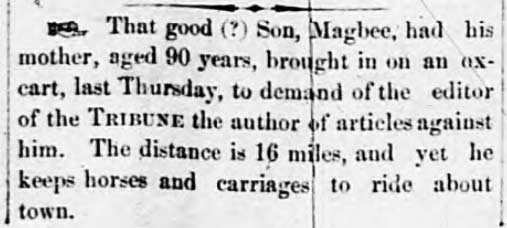 |
|
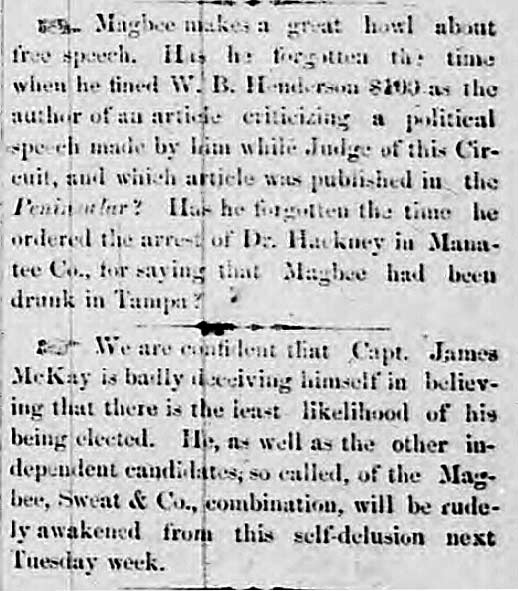 |
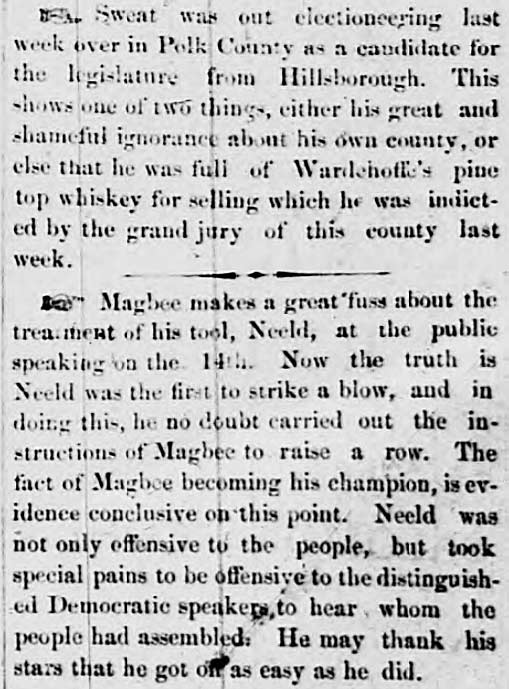 |
|
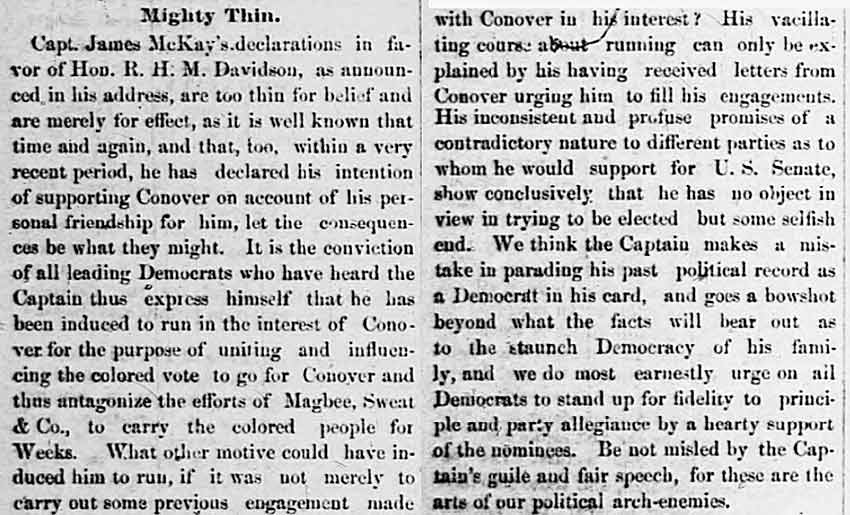 |
|
|
1879 Julia Magbee Tampa Guardian newspaper
article
The Guardian’s assistant editor was Mrs. Julia Magbee. While
she was the editor’s wife, articles such as this imply that
her title was not merely for show. From the Tampa
Guardian, June 7, 1879, p. 3.
The woman who works in some honorable way to maintain herself,
loses none of the dignity and refinement of true womanhood, and is
just as much, even more, an ornament to her sex than the women
whose days are passed in luxurious indolence and indulgence.
The following year Magbee announced that the "Guardian in
the future will be published as a Republican journal.”
(Magbee continued publishing the Tampa Guardian until his death on Dec. 12, 1885.
H. J. Cooper and C. H. Baxter carried on the paper until Dec. 8,
1886, when Cooper announced the publication would cease.)
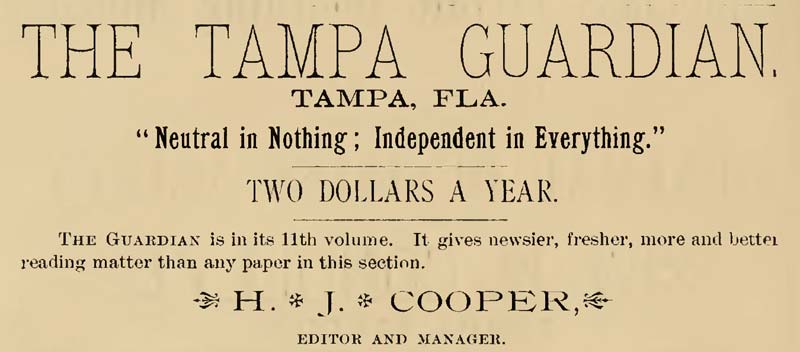
An ad for the Guardian placed in "A
Descriptive Pamphlet of Hillsborough County, Florida,
with numerous maps, Engravings, etc." Published by the
Hillsborough County Real Estate Agency in 1885.
|
|
Read
this excellent
description
of Tampa in Oct. 1879 in the Savannah Morning News |
|
Sunland Tribune Dec. 11, 1879 Dr. John Wall response to
"Bystander"
In the editorial below, Dr. John P. Wall refers to an
article signed "Bystander" in Magbee's Tampa Guardian
newspaper of Dec. 6, 1879, as "no doubt" having been written
by Magbee. Wall calls the paper a "Radical organ" and
a "high-toned" and "scurrilous sheet." He refers to
Magbee's "deserved scrubbing" by Judge Mitchell for his
habeas corpus stunt and Magbee's contempt of court fine
against Henderson. Apparently, Magbee's article in the
Dec. 6 Guardian criticized Judge Mitchell and
connected him with an issue regarding the resignation of a
Manatee County court clerk.
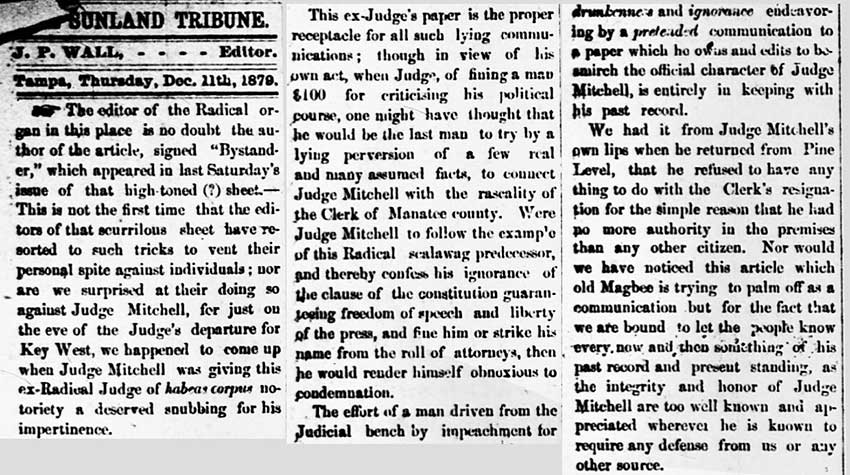 |
|
|
Sunland Tribune, Feb 12, 1880
J.P. Wall
criticizes Magbee and summarizes his view of Magbee's
logic as "The greatest and best men of our country are
most abused; I am much abused by all who know me;
therefore I, J.T. Magbee, am a great and good man."
Wall also points out Magbee's hypocrisy for
considering Sen. David L. Yulee as now "admirable"
when once, Yulee was burned in effigy in the streets
of Tampa for deciding to back the railroad being built
to Cedar Key instead of Tampa, it was Magbee who
"furnished the old clothes for the occasion and was
the active leader in the pyrotechnic display." |
|
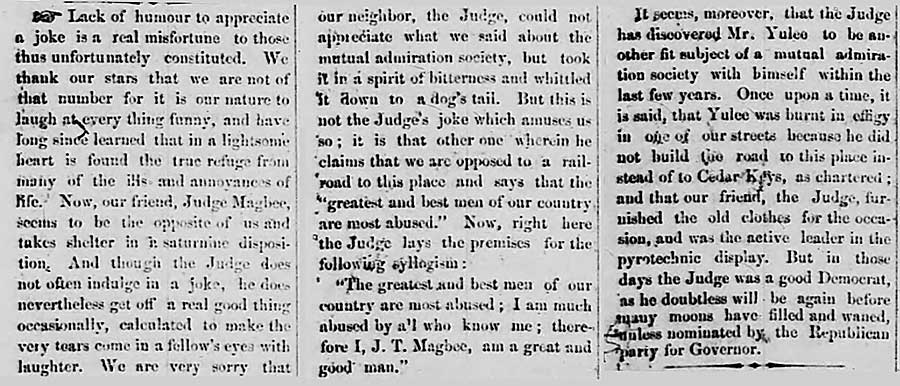 |
Savannah Morning News, Jun. 23, 1880 -- page 1
1880
- Magbee is doing quite well
By early 1880 the former judge was prospering. He entered
into a partnership with A. S. Mann of Brooksville for the
practice of law in Hernando County. He established an orange
grove on Florida Avenue, about a mile north of town, on the
"brow of the rising ground overlooking Tampa" (now Tampa
Heights), and furnished the paint for the Nebraska Avenue
school.
When additional land was needed for the expansion of the
town cemetery (Oaklawn), Magbee "deeded as a gift land
adjoining the burial ground to the east. This was
immediately divided into lots and offered for sale."
He playfully attacked rival editor John P. Wall in May 1880:
"Dr. Wall, editor of the
[Sunland]
Tribune, admits that the scent of
bad whiskey is the true Democratic password and wants to
prove that we are Democrat because we used to drink
whiskey. Now Doctor, when we drank whiskey it was not the
Democratic stuff, for we drank nothing but the very
best. As neither of us now drinks whiskey, and for
that reason and for no other, we ought to be
Republicans--We will leave it to the community in which we
live, as to which of us has drunk the oftener.
There’s an old adage--a veritable fact, that the kettle
should ne’er call the pot black.
And another that says 'none but drones, in glass houses
living, will throw stones.'"
|
1880 Census of James, Julia,
and Archie Magbee

The U.S. Census of 1880 in the town
of Tampa shows Magbee was doing quite well, having 2 servants.
Here, James' age is misreported as 50, the same age indicated on
the 1870 census. James would have been 60 on this census.
Julia is listed as 35, only 8 years older than her 1870 census
age. Differences in birth date and census date can vary ages
by + or - one year, so here their age difference could be around
24 years, somewhat consistent with their 23-year age difference in
1870.
| Name |
Relation |
Race |
Age |
Status |
Occupation |
birthplace |
father's bp. |
mother's bp. |
|
Magbee, Jas. T. |
head |
w |
50 |
married |
Lawyer & Editor |
Georgia |
Va |
Ga. |
|
Magbee, Julia |
wife |
w |
35 |
married |
Editor of paper |
Ala. |
Ga |
Mo |
|
Magbee, Archie |
adopted son |
w |
12 |
single |
Printer |
Scotland |
Scotland |
Scotland |
|
Raine, Thos. |
Printer |
w |
60 |
|
Printer |
SC |
SC |
SC |
|
Proctor, Carrie |
Servant |
m |
18 |
|
Servant |
SC |
SC |
SC |
|
Saunders, Peter |
Servant |
m |
10 |
|
Servant |
Fla. |
Ala. |
Ala. |
|
 Dec.
1880 - Vose Injunction Lifted Dec.
1880 - Vose Injunction Lifted
In December
1880 the South Florida Railroad completed its track from
Sanford to Orlando. At the same time, state railroad
construction soared as the Vose Injunction finally was
lifted. Funds necessary to satisfy the Vose claim came
from the sale of 4,000,000 acres of state lands, located
primarily in central and south Florida, to Philadelphia
businessman Hamilton Disston. The price was twenty-five
cents an acre. Disston and his associates immediately
undertook a massive development effort aimed principally
at the Kissimmee and Caloosahatchee river areas. Francis
A. Hendry’s town of Fort Myers boomed, as did the towns of
Orlando and Kissimmee with which Disston was more directly
involved. By March 1882 the South Florida Railroad, in
line with Disston’s plans, had extended its track to
Kissimmee. There, however, its money ran out.
Tampa and the
Coming of the Railroad, 1853-1884, by Canter Brown, Jr,
in The Sunland Tribune, Volume XVII November, 1991 Journal
of the Tampa Historical Society. |
| |
|

August 13, 1881 - Florida Mirror -
News on the South
Florida Railroad and the Jax/Tampa/KW Railroad
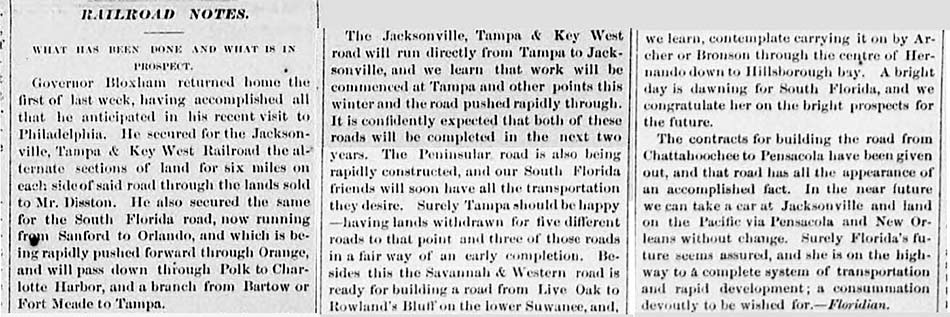
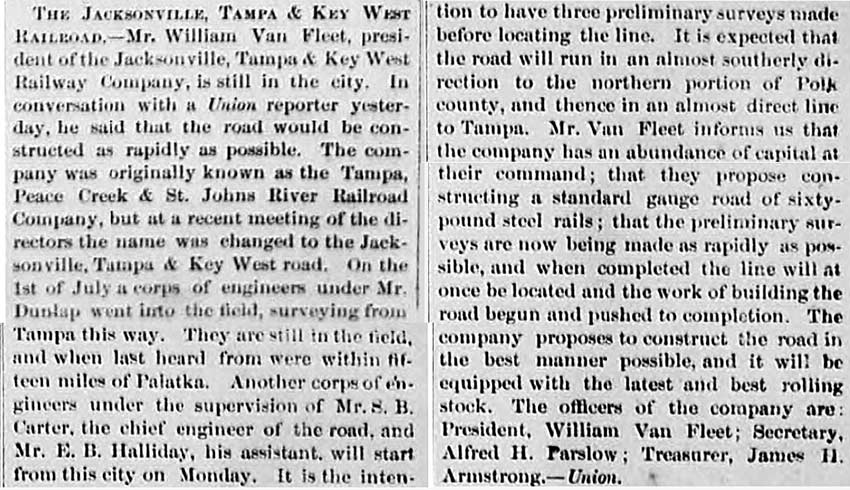
As
investors, developers, speculators, and immigrants
poured into south Florida in the wake of the Disston
Purchase, Tampa remained locked in its tropical
isolation and economic depression. Numerous lines were
authorized to construct into the town, but the steel
rails reached no closer than Kissimmee.
|
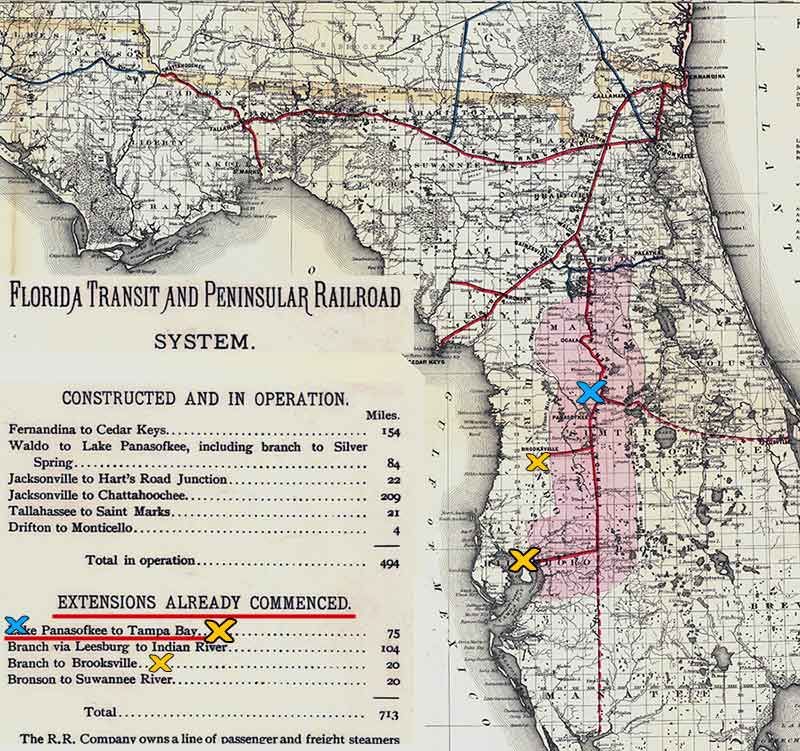 |
|
Florida Transit &
Peninsular Railroad lines, in operation and
construction commenced.
The connection from Lake Panasoffkee southward was not completed.
Wikipedia
|
It was
upon this stage that Henry Bradley Plant stepped in
in the spring of 1883.
Tampa and the
Coming of the Railroad, 1853-1884, by Canter Brown, Jr,
in The Sunland Tribune, Volume XVII November, 1991
Journal of the Tampa Historical Society. |
| |
|
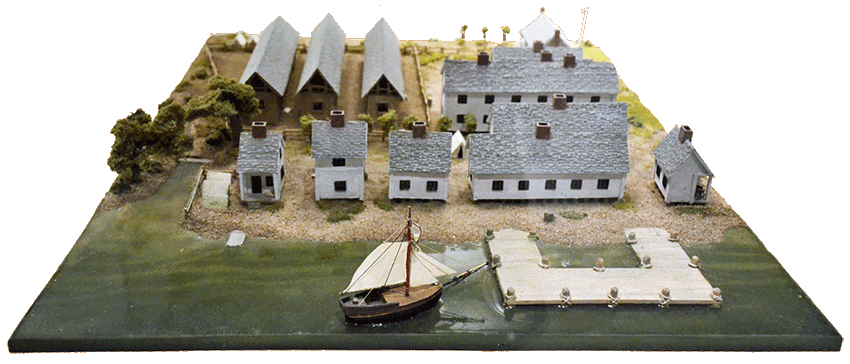 |
|
Model of a
waterfront section of Fort Brooke as it would have
appeared around 1883
Tampa Bay History Center |
1880 - 1885 - Magbee's final years:
Gets old job back, serious illness,
death of Julia, and J.T. Magbee remarriage
Two
of James T. Magbee’s major interests were to bring the
railroad to Tampa
and the growth of the
Florida Republican party.
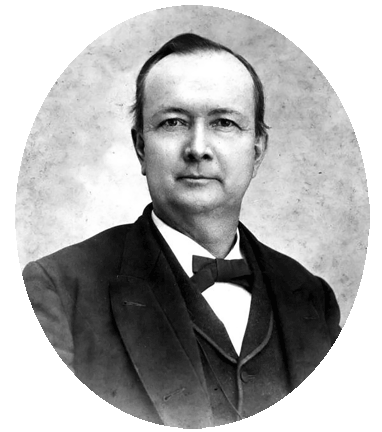 |
|
Wm. D.
Bloxham served twice as Florida's Governor. First as
the 13th Governor from January 4, 1881-January 6, 1885
and then as the 17th Governor from January 5, 1897
until January 8, 1901.
State Archives of Florida |
He was angered that President
Rutherford B. Hayes’ conciliatory policy had harmed the
interests of the party in Florida and he resented having to
share the federal patronage with his political enemies. Referring to the Democratic party as that "old enemy of
human rights," Magbee asserted that it deceived and stole
from the "poor white man" by telling him that if he voted
Republican he belonged to the "Negro party." It "preyed upon
his prejudices to make him steal from himself, by his vote,
his own and his children's liberty.”
In the 1880 elections,
the Guardian endorsed Republican James A. Garfield for
President and Democrat William D. Bloxham for Governor. When the election was over and Garfield and Bloxham had
won, the Tallahassee Floridian declared that James T. Magbee
must be the "happiest man, politically," in the State of
Florida.
With the election of Garfield, Magbee sought a
suitable political reward. He traveled to Washington in July
1881, but the President’s assassination required another
trip the following year.
There was speculation that Magbee was next in line for
Collector of Customs at Key West or Postmaster at Tampa. He
received his reward in February 1883, with his appointment
as Deputy Collector of Customs at the Port of Tampa. After
almost twenty-five years, Magbee had gotten his old job
back.
Magbee also lived to see the completion of the railroad to
Tampa, January 22, 1884. It is fitting that Magbee, who had
fought for almost thirty-five years to achieve this goal,
was present at the gala celebration at the Orange Grove
Hotel that evening.
|

1884 - H. B. Plant brings the railroad to Tampa
|
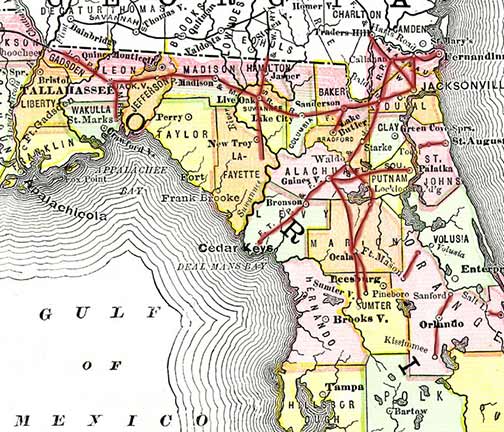 |
|
Map
of Florida for Poor's Manual of Railroads Projection. Digitization
provided by the USF Libraries Digitization Center. Rare Maps. This
is a railroad map of Florida, circa 1883. According to the USF
library, "Poor's Manual of Railroads was an annual publication from
1868 to 1924 and included railroad financial reports and short
histories." |
|
Exploring Florida, Maps Etc.
|
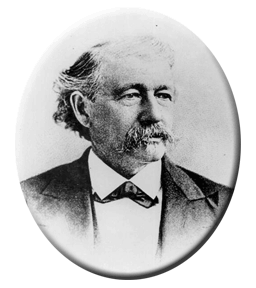
Plant’s first step toward
Tampa came in May 1883 when his Plant Investment Company purchased a
three-fifths interest in the South Florida Railroad. The quick
negotiations and purchase illustrated the strength and flexibility of
Plant’s financial position, something not enjoyed by many of his
undercapitalized competitors. His general superintendent later explained:
"We speak of the
Plant Investment Company--do you know what the Plant Investment Company
is? It is Mr. Plant and his friends who have money, cash, to invest. When
it is decided to do a certain thing, build a piece of road for instance,
they figure out what each is to pay and send in their checks for the
amount. They have no bonds, no indebtedness, no interest to pay; they
build railroads to operate them and not for bond and stock speculations."
Despite his financial
resources and his desire to run, not speculate in,
railroads, Plant nonetheless was a demanding
businessman intent upon making the best bargain he
could. With the South Florida Railroad within his
control, he had a charter to build from Kissimmee to
Tampa. But in granting that charter the state had
offered a subsidy of only 3,840 acres of land for each
mile of rail constructed.
Plant
noticed that the Jacksonville, Tampa & Key West
Railroad, originally founded at Tampa in 1877, also
had a charter to build from Kissimmee to Tampa. But
they had run out of money after grading
fifteen miles of roadbed. What was most interesting,
though, was that the road's charter called for a state
subsidy of 10,000 acres of land for each mile of
track, as well as the grant of alternate sections of
land within six miles of each side of the road. The
total commitment came to 13,840 acres per mile of
track.
The huge subsidy proved
irresistible to Plant. There was a problem, though.
The subsidy was due to expire in January 1884 unless
construction was completed before then. Other railroad
men told Plant it simply could not be done, but Henry
Bradley Plant decided to prove them wrong. First, he
struck a bargain with the Jacksonville, Tampa & Key
West's management. He provided them funds for
construction of the line's northern end and received,
in return, all rights to the subsidy for the route
from Kissimmee to Tampa. Within a matter of weeks
Tampa's town council had extended all necessary
accommodations to Plant and had leased the lower ends
of Polk, Zack, and Twiggs streets-with all rights to
the adjacent riverfront-to the railroad for $30 a
year.
Excitement at once was in the air.
Tampa and the
Coming of the Railroad, 1853-1884, by Canter Brown, Jr,
in The Sunland Tribune, Volume XVII November, 1991 Journal of the Tampa
Historical Society.
|
| |
Rail
Georgia
|

1883 - June 16 - Construction begins in Tampa toward
Kissimmee
As Karl Grismer explained:
"On June 16, 1883 a crew of 168 track laborers came into
town and began grading operations. More men quickly
followed. Other crews started grading westward from
Kissimmee. Orders were given for hundreds of thousands
of crossties; workers in logging camps worked from
dawn to dusk, and new mills were brought in to cut the
timber. Construction men bought or leased every mule
and ox within a hundred miles, and every vehicle in
which earth could be moved. Farmers quickly sold every
bit of produce they could grow; cattlemen reaped a
harvest selling beef to the construction crews.
Hillsborough County seethed with activity, and so did
Tampa. Overnight it became a boom town.”
As the roadbed pierced the
countryside, improvements continued in Tampa. A wharf
was constructed at the foot of Polk Street, and
schooners from around the country unloaded their huge
quantities of supplies and equipment. Settlers streamed
into the community, and the sounds of construction
everywhere were to be heard.30
Through the heat of summer
and fall two parties of twelve to fifteen hundred men
worked toward each other from both ends of the line.
Crews began the arduous task of laying the track
through formidable Florida wilderness, described in an
1887 publication by the South Florida Railroad
Company: “They fought through raw woods – through pine
and oak scrub, green tongues of cypress swamp
protruding into them. A seemingly impenetrable wall of
cypress, bay, cedar, magnolia, live oak, water oak and
more, rose scrambling and choking from the brown
pools. That black venomous mass was fought hand to
hand with ax, pick and spike.” Many of the workers were black. The Plant System had
used leased convict labor on other projects, and some
of the men likely were prisoners. The heat, humidity,
pests, and other working conditions were terrible.
Nonetheless labor contractors drove the men
mercilessly. Week by week the line was
extended.
1883 - September 1 - Locomotives arrive by ship in
Tampa
The first two locomotives for the South Florida Railroad
arrived in Tampa on a schooner on September 1, 1883. Five
days later, after being assembled, their boilers were
fired. Early the next morning the town was awakened by
repeated blasts of the engine whistles.
Reported the
TRIBUNE: "The echoes had hardly died away when from every
street and alley, every doorway and window, and from the
four winds came a mass of humanity to gaze at the monsters
of the rails. It was an impromptu celebration such as
Tampa had never seen before.
Now everyone knew for sure
that the city really had a railroad."
As the rails were
laid, new communities-such as Lakeland, Auburndale,
Lake Alfred, and Winter Haven-sprang up along the
line. In Hillsborough
County a town was laid out near the old Indian
settlement of Itchepuckesassa and the Seminole War
post, Fort Sullivan. For a time it was known simply as
"End of Track." Soon, it was called Plant City.
H. B. Plant came to Tampa for the first time on December
1, 1883, arriving at 8 p.m., accompanied by James E. Ingrahm, president of the South Florida, and Col. H. S.
Haines, general construction superintendent, who had left
Kissimmee at five o'clock that morning.
Eighteen miles of
the journey over the uncompleted portion of the line
between Plant City and Auburndale had been made by horse
and buggy. The party was royally entertained at the Orange
Grove Hotel built in 1859 as the home of cattleman
William B. Hooker.
Perhaps that evening-if not before-Plant conceived of
the need for grander accommodations in his new city
On the following day was taken on a Tampa
Bay excursion on the Capt. Miller, a new steamer of the
Tampa Steamship Line.
1883 - December 10 - Monday- The first train from
Tampa to Plant City
Trains began pulling in and out of Tampa
nine days later, on Monday,
December 10, 1883, when service was started to Plant City.
The first train left Plant City at 8:30 a.m. and arrived
in Tampa at 10 a.m.; left Tampa at 2 p.m. and arrived in
Plant City at 3:30. Thereafter the train ran daily except
on Sundays. H. H. "Hal" Scarlett was the conductor and M.
W. Carruth baggage-master. Plant City was founded in 1883.
Troubling, however, was the
gap remaining from Plant City to Auburndale. And time
was running out. The state subsidy was set to expire
on January 25.
Through December, the
Christmas holidays, and New Years, the workers toiled
seemingly without relief. Day by day the track inched
forward. He had negotiated with the
Jacksonville, Tampa and Key West Railway Company to
buy a six-month franchise for a railroad extending
from Kissimmee to Tampa. But each day brought
Plant’s company closer to the deadline. The first week
of January passed, then the second and the third.
1884 - January 23 - The line between Tampa and
Kissimmee is completed
A railroad
construction camp was located on the shores of Lake
Wire in late 1883. Herbert J. Drane, then only 20
years old and the first white man to live in the
original 80 acres that comprised Lakeland, was a
superintendent of construction. In December if 1883
with the railroad almost to their doorsteps, the
townspeople met to select a name for the new
settlement – the site of today’s Munn Park Historic
District. Lakeland was enthusiastically chosen.
There, on the morning
of January 23, 1884, the last rail on the tracks between Tampa and
Kissimmee was laid. The last spike was driven,
just days away from the expiration of Plant's
franchise. From each end of the line, trains
from Kissimmee and Tampa “kissed” cowcatchers at
Carter’s Mill, five miles east of Lakeland.
The stranglehold of
Tampa’s isolation finally was broken. Tampans went wild
and the
celebration commenced that evening at the Orange Grove
Hotel and lasted until daybreak.
Plant was not
present but many other topflight railroad officials were,
as well as almost every prominent man in Tampa. Many
speeches were made and the festivities continued until
almost daybreak. Committee members who had charge of
the banquet included Judge James T. Magbee, Dr. Duff
Post, Rev. T. A. Carruth, Henry L. Crane, John B. Spencer,
Judge H. L. Mitchell, J. B. Wall, R. B. Thomas, John T.
Lesley, Capt. John Miller, G. B. Sparkman, S. A. Jones,
Harry L. Branch and John N. C. Stockton.
(Tampa, A History of the City and the Tampa Bay Region of
Florida, by Karl H. Grismer, edited by D. B. McKay, 1950.)
Townspeople were
delirious at Henry Plant’s boast that he would turn
the "sand heap" of Tampa’s main street "into the
Champs-Elysees and the Hillsborough into the Seine." The first through
train left Tampa for Sanford that next morning, and
regularly scheduled service began on February 13. It
took six and a half hours to make the trip. Two weeks
later connections were available to points throughout
the country.
The editor of the Ocala Banner, though
writing two years later, summed up the sentiments of
the time:
"How this railroad service kills time and
space! Only a little while ago it took two days to go
from Ocala to Tampa and four days to reach
Jacksonville. Now we can speed over the route in a few
hours in comfort. Because of the railroads, this
entire country is being magically transformed."
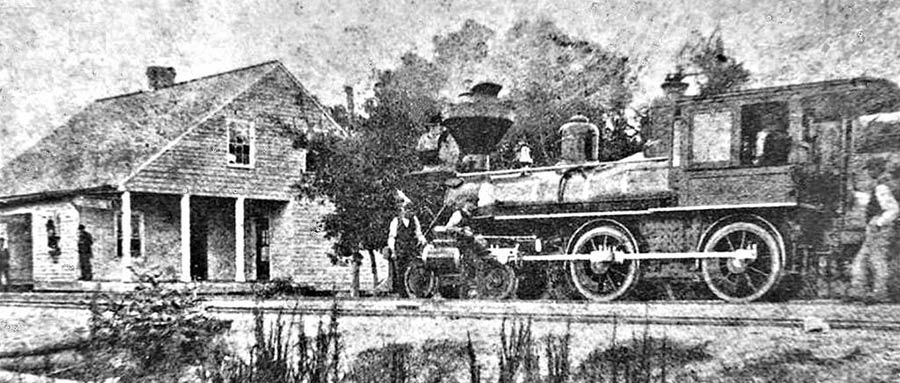
Tampa's first railroad passenger depot in 1884
This residential dwelling
near Twiggs and Zack* [sic] streets was used as the passenger depot
until a suitable station could be built on Ashley
Street alongside the Hillsborough River. The
locomotive seen here is in the typical 4-4-0 style of
the day.
(*Twiggs and Zack streets run
parallel, they don't intersect anywhere.)
Tampa Bay History Center photo
from
TPavluvcik flickr
And so, Henry Bradley Plant
magically transformed Tampa. Two years before it had
been a village, and a decade before that it had for a
while been a ghost town, deserted in fear of yellow
fever. With the railroad, the town’s 1880 population
of 720 doubled and redoubled so that, by 1890, Tampans
numbered well over five thousand. That figure again
tripled by the turn of the century.
|
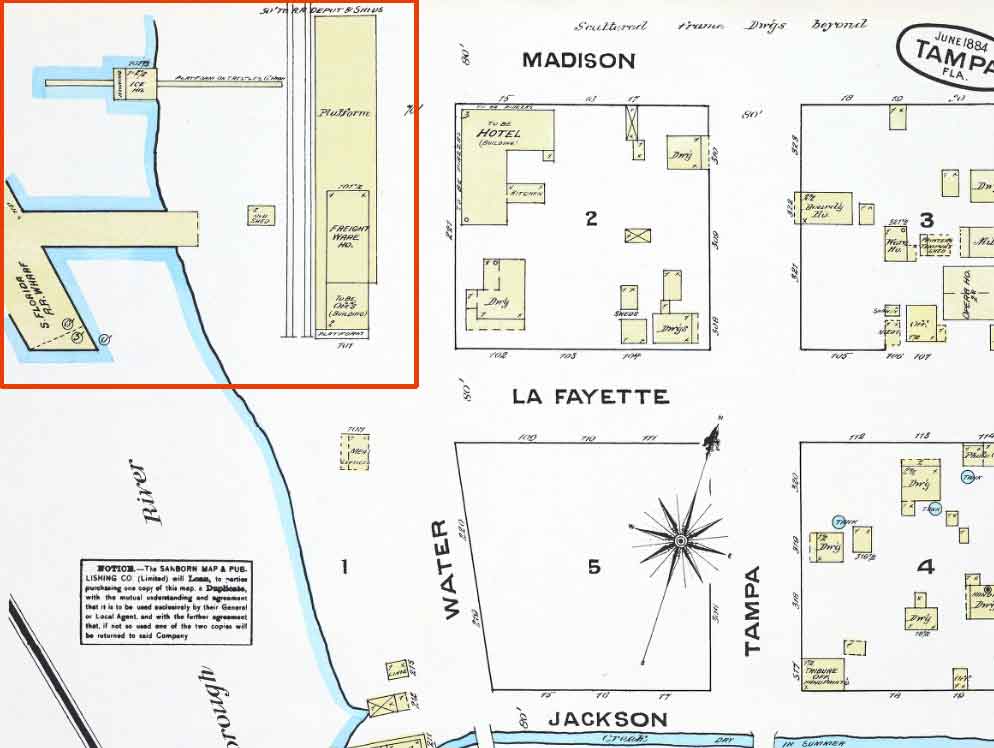 |
|
This 1884
Sanborn fire insurance map of Tampa shows
Plant's South Florida Railroad wharf and depot
at the west end of Madison and Lafayette
streets. The tracks came into town down
the middle of Polk Street from the east, as seen
in the 1889 map below.
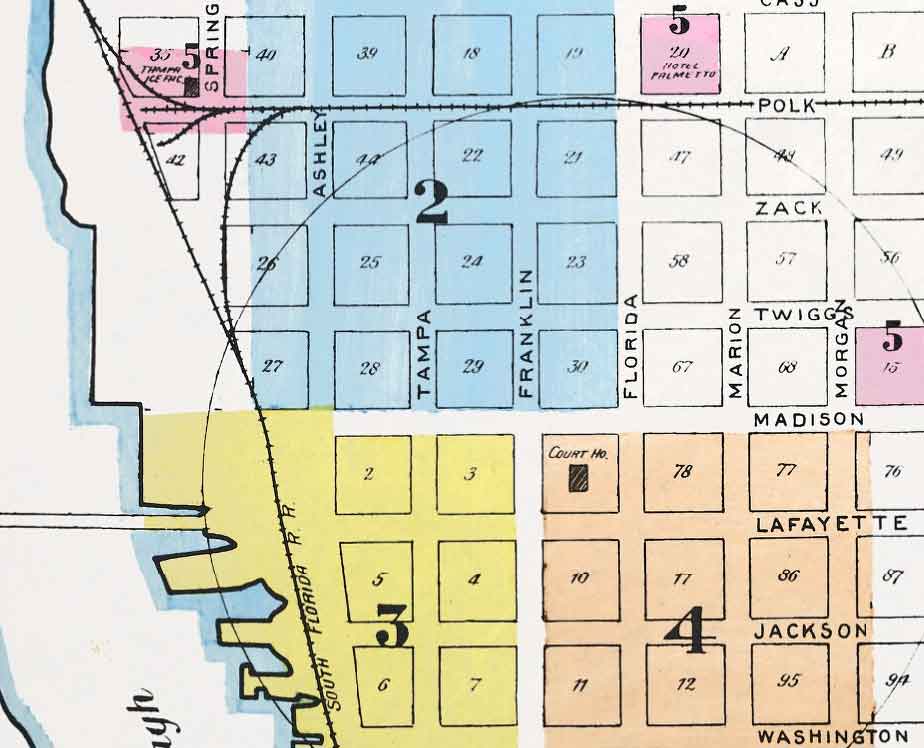
Place your cursor on the map to see how the
tracks came in from Ybor City, down the middle
of 6th Avenue. |
Plant’s accomplishments,
however, should not overshadow the efforts of decades
to bring a railroad to Tampa. His ability to lay track
so quickly was dependent, for instance, on the work of
the local organizers of the Jacksonville, Tampa, and
Key West Railway. Those men had explored all
practicable routes across the peninsula and had
identified the one ultimately followed. They
additionally had graded fifteen miles of roadbed and
had secured necessary permissions from the local
governments involved. Those preliminary efforts
allowed Plant to meet his deadline-though just barely.
Otherwise, the history of Tampa and south Florida
might have turned out quite differently.

H. P Hepburn, an engineer who
had once surveyed those routes, said in April 1878,
"It is unquestionably true that a road connecting
our magnificent bay with the St. Johns River would do
more towards settling up and developing South Florida
than any other like enterprise that could be
projected." Prophetically, he continued: "The road
would undoubtedly make Tampa the chief business place
of South Florida, and the whole of this section of the
State would be benefitted thereby."
Henry Plant recognized the
genius in other men’s work and capitalized on it with
his own relentless energy and financial resources.
Truly he transformed Tampa, but it was the vision of
others--developed over three decades of struggle-that
led the way.
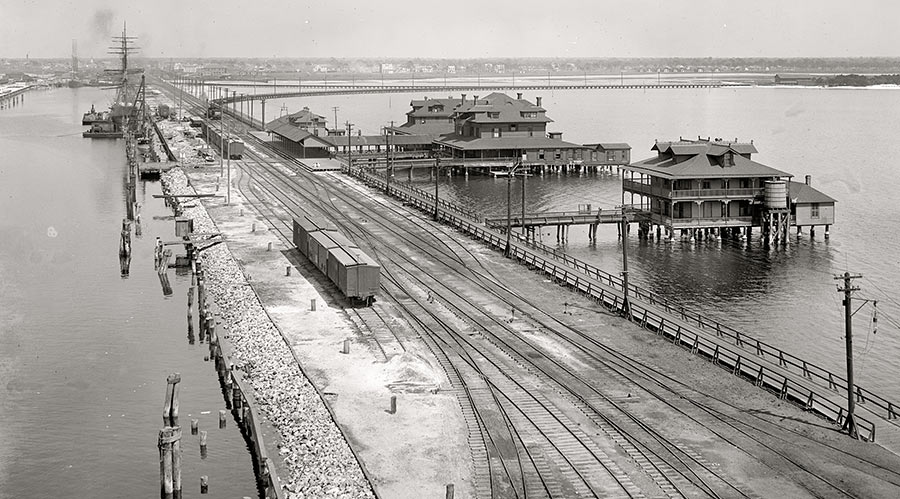
Florida Southern Railway terminus
at Port Tampa with H.B. Plant's Port Tampa Inn (L) and
the St. Elmo (R), in 1900.
Photo
from Shorpy, Detroit
Publishing Co.
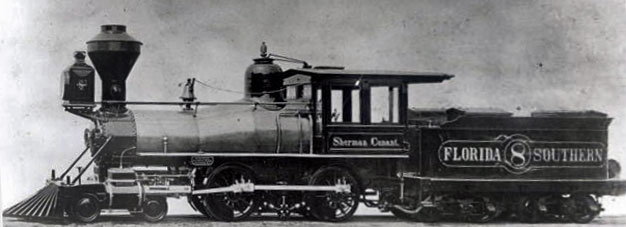
Builder: Rhode Island Locomotive Works,
const. no. 1477.
Year built: 1884.
Engine type: 4-4-0.
Cylinders (diameter & stroke):
14" x 18"
Diameter of driving wheels: 48"
State Archives of Florida
Florida Southern engine #8
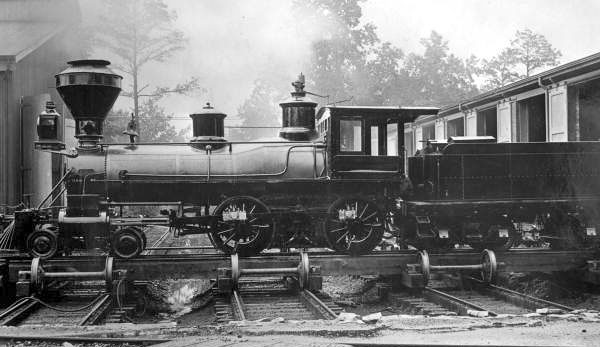
Florida Transit and Peninsular Railroad company steam
engine #21
Builder: Rogers Locomotive and
Machine Works, const. no. 3457.
Year built: January 1884.
Engine type: 4-4-0.
Originally the S.L.&E. #287. It
later became the J. Buttgenbach & Company #99 in Saint
Augustine, then the T.T.&P. #21, the Florida Central
and Peninsular #21 and then the Seaboard #315.
State Archives of Florida
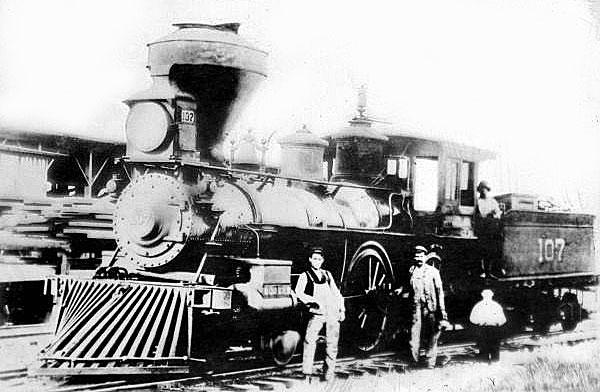
Florida Southern Railway Company engine number 107
(State Archives of Florida)
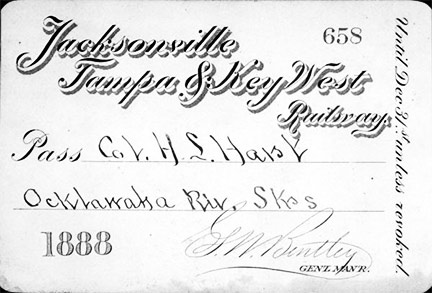
State Archives of Florida
Tampa and the
Coming of the Railroad, 1853-1884, by Canter Brown, Jr,
in The Sunland Tribune, Volume XVII November, 1991 Journal of the Tampa
Historical Society.
Tampa, A History of the City and the Tampa Bay Region of
Florida, by Karl H. Grismer, edited by D. B. McKay, 1950.
The History of Bonnet Springs Park, Lakeland
Tampa Bay Trains First railroads in Tampa
Read more about the South Florida Railroad's push to
Tampa, and Henry B. Plant at Tap Lines, by Don
Hensley, Jr.

1898 Plant System letterhead
Library of Congress |
1883 -1884 Magbee in ill health
It is of
interest to note that Magbee's participation at the railroad
celebration at the Orange Grove Hotel took place during the period of being "seriously
sick" as described below.
According to an
affidavit presented to the Supreme Court of Florida by
Magbee's associate counsel, in the case of J. T. Magbee vs.
T. P. Kennedy, et ux., Magbee was "frequently absent on
professional business, and at other times unavoidably
absent, and when at his office at home was busy a greater
part of the time in professional and other matters that
claimed his almost constant attention." Another
affidavit presented by his wife, Julia, stated her husband
was "seriously sick the greater part of every day from
the middle of December, 1883, to the beginning of April,
1884, so that he was wholly unfit to attend his law
business, and that nearly all the work he did as Deputy
Collector of Customs at the port of Tampa was done while
confined to his room."
Cases adjudicated, Florida Supreme Court, Jan. term, 1890
Southern Reporter, Vol. 7, Feb. 19 - Sept. 17, 1890
|
|
1885 -
January - Death of Julia Henderson Magbee
Tragedy struck on January 27, 1885 when Julia Ann
Magbee died. The death of this "brilliant and
pungent writer," who had been assistant editor of the
Guardian, was a heavy blow to the aging lawyer and
newspaperman.
He retired as editor of the Guardian but remained active in
civic affairs, helping to organize the Tampa Board of Trade
the following May.
Magbee was 65. |
From D. B.
McKay's
Pioneer Florida, Volume 2, Chapter 10, "A Self-Made
Scalawag", 1959:
Magbee owned the entire block bordered by Franklin, Cass, Tampa
and Polk streets. His fine home was on the site now occupied by
the J. C. Penney store, and adjoining the residence on the west
was a large building (for those times) in which he had a modern
printing plant. From this plant he issued a weekly
newspaper, the Tampa Guardian.
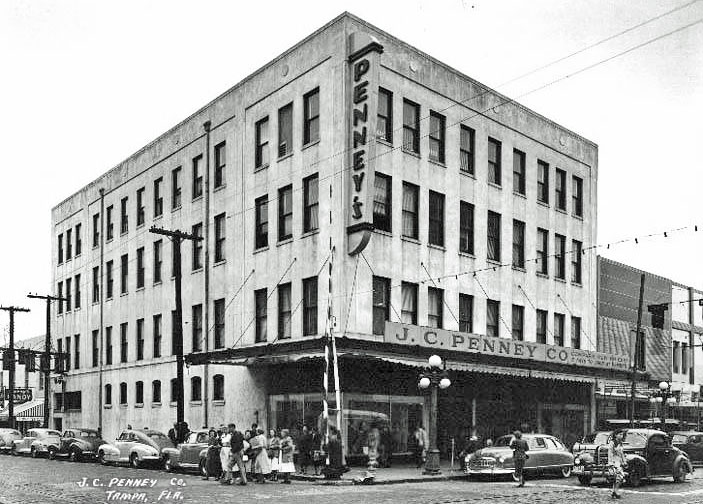
As an apprentice in the printing business, I worked in the
Guardian office several months, and to me the old fellow was
always kindly and generous. I was working in his printing office
the day the first train on the South Florida railroad (now the
Atlantic boast Line) arrived--January 25, 1884. The late Capt. H.
H. Scarlett was conductor on that train.
D. B. McKay on the
kinder side of Judge Magbee:
I have taken
up a lot of space telling the story of James T. Magbee, but I
hope it has been sufficiently interesting to justify me.
However, I want to relate one more incident--I have written so
much to his discredit that it is pleasing to present another
phase of his character.
A pioneer
family had lost their home and its contents by fire and a group
of citizens were raising a fund to provide a new home for them.
It was during the time that I was working in the Guardian
office. Judge Magbee called me into his private office,
opened his safe and took out a metal box which had in it what
appeared to be about a peck of gold coins. He scooped up a
handful of the gold, gave it to me and said, "Take this to those
d--- rascals and tell them if more is needed there is plenty
more where that came from."
1885 - Magbee's third marriage
On Sept. 16,
1885, eight months after Julia's death,
Magbee married
Carrie Burr Fisher, "an old woman of very unattractive
appearance" (according to D.B. McKay). The night of this marriage, a crowd of men and boys
gave them a charivari which for loud and unearthly noises has
never been rivaled here. There was no interference by the police,
as there was general approval by the public.
VanLandingham refers
to Carrie as a young woman:
On September 17,
1885, he married a young woman named Carrie Burr Fisher, of
Philadelphia.** A pre-nuptial agreement was signed providing that
the survivor would receive nothing upon the death of the other
party.
On
the night of their wedding, the couple was subjected to the old
Southern tradition of charivari or chivaree:
"The crowd of several hundred-nearly every white man in
town-assembled shortly after dark and pandemonium reigned
until near daylight. Among the noisiest of the musical
instruments was a huge bull fiddle. It was made of a large
dry goods box with one side open. Across the opening was
tautly stretched a broad strip of rawhide. The bow was
also made of rawhide and it was operated by two men, one
at each end. The sounds it gave forth were hideous and
unearthly beyond description. The party was described as
the "wildest [and] noisiest of all the chivaree parties in
Tampa’s history".
|
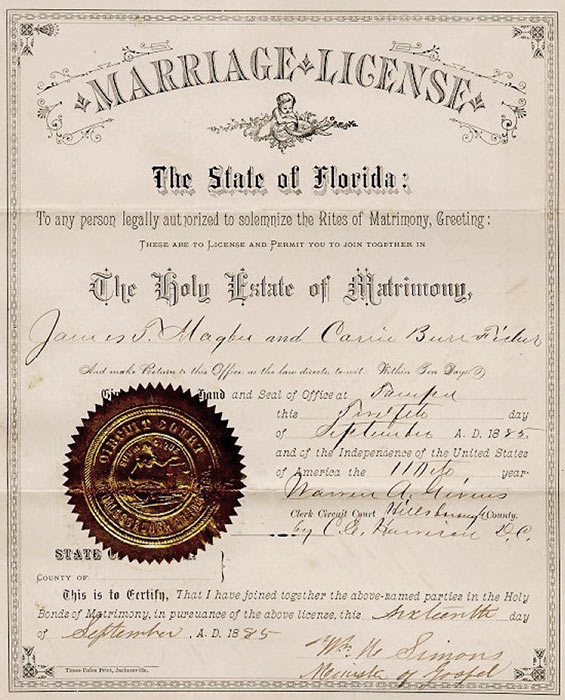
Less than two months later, Magbee was dead. He passed away
in Tampa, "suddenly" on December 12, 1885. There were rumors
that he had been poisoned. But even in death, he remained
controversial. He left an estate valued at from $50,000 to
$75,000. The widow claimed she was pregnant and demanded
monthly support payments. She continued to live for a while
in the Franklin Street residence and was reported ill there
the following June. There is no evidence that she ever had a
baby.
|
**Footnote by VanLandingham:
The Tampa
Journal of July 27, 1888 referred to Carrie Burr Fisher as
Magbee’s fourth wife. If that is the case, then he was
married prior to Susan Tatum.
[TampaPix: Perhaps the Journal was making reference to this
being Carrie's fourth marriage? See below on Carrie Burr
Warner Fisher.]
|
|
Magbee had executed a will before Julia’s death, leaving his
estate to her, his mother, sister and Archie, the adopted
son. Magbee later wrote "cancelled" over the "portion of the
will referring to Archie D. Magbee,... but did not
destroy the document which was found among his papers after
his death. An administrator was appointed and the case
dragged on until 1888. In spite of the ante-nuptial
agreement the widow declared that she was "sole heir." An
order was finally entered which gave Carrie Magbee a
one-third share of the estate with the remaining two-thirds
going to a sister, Penelope A. Magbee and a brother, Samuel
B. Magbee.
|
|
Who was Carrie Burr
Fisher and was she young or old?
TampaPix has been unable to locate Carrie Burr, Carrie Warren,
Carrie Fisher, Caroline or Carroll or any similarly named person in
Florida's 1885 State Census. The city area of Tampa
was enumerated on the first 12 pages, and she does not appear
there. In these pages can be found the same neighbors
of Magbee from the 1880 census. The 1885 census date
was June 1, 1885, they married in September, so they would not
appear as husband and wife on this census. It is
possible that Carrie had not yet arrived in Tampa or settled
in by June, 1885.
There is a New York City marriage
record (shown below) of a Louis Fisher who married in 1877 to
a Carrie Burr Warner age 30. Her birth surname is Burr, and
she was at the time the widow of Mr. Warner,
and was born in Harrisburg, PA. It is possible that if
Mr. Fisher also died (or they divorced), she would be Carrie
Burr Warner Fisher and if she then became Magbee's wife, she may have chosen to
not use "Warner" anymore when she came to Tampa and married
Magbee. Her pre-nup with Magbee worked
two ways, he would get nothing of hers if she died first,
and vice-versa.
Marriage record
of a "Carrie Burr Warner" to a Louis Fisher
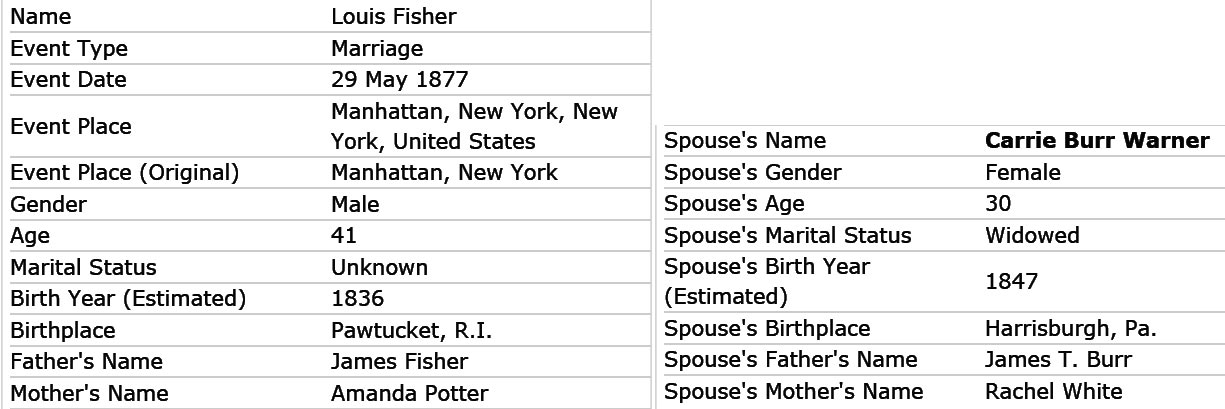
This Carrie Burr Fisher of the
marriage record above would have been around 38
in 1885, Magbee
would have been 65. Would Carrie's claim of being
pregnant with Magbee's child in 1885 or later been credible is
she really was was an "old woman" as McKay wrote?
On the other hand, McKay was a boy when Magbee's marriage to
Carrie took place. He would have seen her personally, so was he writing from a young boy's point of view?
Also, no record
has been found of her parents, James T. Burr and Rachel
(White) Burr.
New York, New York City Marriage Records,
1829-1940," database, FamilySearch (March 2015), Louis Fisher and
Carrie Burr
Warner, 29 May 1877; citing Marriage, Manhattan, New York, New
York, United States, New York City Municipal Archives, New York;
FHL microfilm 1,562,182.
|
1887 - June 2 - The City of Tampa is established, first city
mayor elected July 12
|
The City of Tampa was established on Jun 2, 1887 when
under special act of the state legislature, the
Governor approved a bill that granted the city of
Tampa a new charter, abolishing the town
governments of Tampa and North Tampa. Section 5
of the charter provided for a city-wide election for mayor,
eleven councilmen and other city officials, to be held on
the 2nd Tuesday in July. The new charter also greatly
expanded the corporate limits of the city. Tampa now
took in North Tampa, Ybor City and some land on the west
side of the Hillsborough River. The
first city election under the new charter was held
July 12, 1887, and the new mayor took office on July
15, 1887, the date considered to be when Tampa was organized.
What Happened in Tampa on July 15, 1887 or Thereabouts,
by Joseph Hipp
In a hotly
contested race, George Bascom Sparkman was
elected mayor for his 4th term, defeating Henry C.
Ferris, 283 to 269.
|
Born: |
September 20, 1855 in Simmons Hammock (Dover,
FL) |
|
Died: |
Aug. 31, 1898 (Yellow Fever) |
|
First Term: |
March 22, 1881 - August 13, 1881 (Acting Mayor) |
|
Second Term: |
August 14, 1881 - August 13, 1882 |
|
Third Term: |
August 14, 1882 - August 13, 1883 |
|
Fourth Term: |
July 15, 1887 - March 8, 1888 |
|
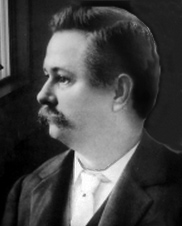 |
|
George B.
Sparkman
First Mayor elected for City of Tampa, 1887
Photo and info from Biographical Sketches of
Circuit Judges, 10th Jud. Cir. website
|
|
The son
of Elijah Bird Sparkman and Sarah Ann Mizell Sparkman,
George Sparkman attended local schools and graduated
in September 1877 from the University of Virginia Law
School where he earned a law degree. He returned to
Tampa where he opened a law office with his cousin,
Stephen M. Sparkman who also became one of Tampa's
most prominent citizens. The success of his law
practice encouraged his strong interest in local
politics.
First
appointed on March 22, 1881, George Sparkman replaced
acting mayor Matthew E. Haynsworth who, as President
of the City Council, had been appointed to complete
the term of former mayor, Henry Ferris. After
completing Ferris' term, Sparkman campaigned for mayor
in the municipal elections held in August 1881 and won
the election for his 2nd term. He was re-elected in
August 1882 for a third term as mayor.
On April
26, 1883, George married Mary Kershaw of Madison
County, Tennessee, with whom he had seven children.
Sparkman
then served on the City Council from August 13, 1884
to August 13, 1886. In July 1887, Sparkman ran for for
a 4th term as mayor a hotly contested campaign
[details below] for
the City of Tampa's first mayor under the new charter.
Local newspapers and some citizens complained that
Sparkman had bought the July 12 election by providing
alcohol and women to voters on election day. In any
case, Sparkman won the election by only 14 votes and
the accusations eventually faded away.
[See below
comments by the Tampa Journal].
| |
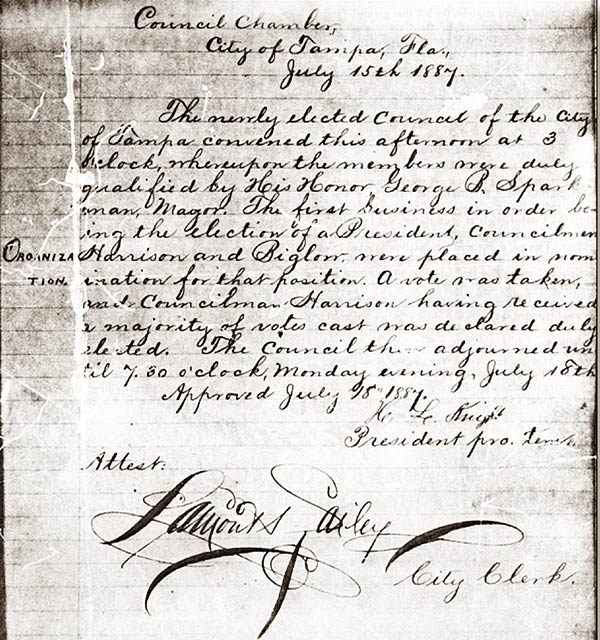 |
| |
| |
Council Chambers
City of Tampa, Fla.
July 15, 1887
The
newly elected council of the city of Tampa
convened this afternoon at 3 o'clock
whereupon the members were duly qualified
by His Honor George B. Sparkman, Mayor.
The firsst business in order being the
election of a President. Councilmen
Harrison and Biglow were placed in
nomination for that position. A vote
was taken, and Councilman Harrison having
received a majority of votes cast was
declared duly elected. The Council
then adjourned until 7:30 o'clock Monday
evening, July 18th.
Approved July 18th, 1887
H. L. Knight
President pro. tem.
Attest:
[signed] Lamont S. Bailey
City Clerk |
THE SUNLAND TRIBUNE,
Journal of the TAMPA HISTORICAL SOCIETY, Volume
VIII Number 1 November, 1982 - WHAT HAPPENED
IN TAMPA ON JULY 15, 1887 OR THEREABOUTS by
Joseph Hipp |
Elected
under provision of the new city charter on July
12,1887 were George B. Sparkman-Mayor; J. LaMont
Bailey-Clerk and Treasurer; W.T. Haskins-City Marshal;
J. C. Robbins-Tax Assessor and A. M. Fleming-Tax
Collector. City Council members included:
Charles E. Harrison-President, William Benton
Henderson , President pro tempore, William A. Honaker,
Isben S. Giddens, Henry Laurens Knight, Frederick M.
Meyer, Silas L. Biglow, Candido Angel Martinez-Ybor,
Joseph A. Walker, Charles N. Brigham, James E.
Mitchell - Died 11/26/1887 (Apparently his vacancy was
not filled.) Source: Council Minute Book 2, page
59.
After his
4th term as Mayor, Sparkman served on the City Council
again, from March 4, 1891, to March 4, 1892. Both of
his terms on City Council were served under the
administration of Mayor Duff Post.
In 1893
Sparkman was appointed as judge to the Sixth Judicial
Circuit by Governor Fleming, serving until 1894.
Knowledgeable of the city’s history when a railroad
was built to Cedar Key instead of Tampa, Mayor
Sparkman and the City Council gave an exclusive
franchise for the Jacksonville, Tampa, and Key West
Railroad to lay tracks along Spring, Water, Polk, and
Whiting streets. Unfortunately, within a short time,
the company lost its assets. It would be only a short
time before Henry B. Plant would engage the city. In
the summer of 1883, Tampa’s Town Council gave the
railroad franchise to Henry B. Plant, this time for
$30 a year, giving him the riverfront area between
Polk and Twiggs streets. Locomotives arrived by
schooner in September, and the completion of the South
Florida Railroad gave new life and hope to the area.
|
Archives, Tampa City Council Member Jan 1849-Jun 1904
City of Tampa past Mayors, George Bascom Sparkman -
19th And 22nd Mayor Of Tampa
The Mayors of Tampa 1856 - 2015,
A project of the City of Tampa
|
|
Chapter 3779 [No. 99]
AN ACT to abolish the corporations of the Towns of Tampa
and North Tampa, to provide
a municipal government for the City
of Tampa and to define the boundaries thereof.
|
Under the
provisions of the act, the city's boundaries were extended to
include North Tampa and Ybor City. The City of Tampa's
government was also to be administered by a mayor and
eleven councilmen, two elected from each of the four wards
and three elected from the city at large. Elections were
to be held on the second Tuesday of each year and other
officials such as the city marshal, city clerk, treasurer,
tax assessor and tax collector were to be elected at the
same time as the mayor and City Council. The charter also
allowed ordinances to be passed by the City Council over
the mayor's veto.
Click each image below to see larger, then click larger
image to see full size. |
|
 |
 |
 |
 |
 |
|
City of
Tampa established, former charters abolished. |
Mayor &
councilmen, first election, annual election |
Compensation, powers
|
Taxes,
loans, bonds, veto, fire limit |
Existing
indebtedness provided for, Act to take effect AT ONCE. |
1887 - July 12
The City of Tampa's first election
"...a disgrace to an
intelligent and civilized community..."
Tampa had 895 registered
voters in 1887 and the Tampa Journal reported that only 575
of these men exercised their opinion - only 64%.
Mr. Sparkman was elected as the new Mayor by 14 votes.
The Journal reported on the
election as follows:
As a
public servant, the Journal would be derelict in its duty
if it passed over some of the irregularities and
disgraceful occurrences of Tuesday’s election without
calling attention to them. It was such an election as we
hope never again to see in Tampa. For two or three days
before the election, whiskey was dispensed free by some of
the saloons. On election day the streets were lined with
drunken men; the most obscene, vulgar and profane language
could be heard, not only in the streets, but in the room
in which the election was held. Frequent rows and fights
occurred, and during the entire day and night a drunken
and riotous mob held possession of the town. Such a state
of affairs are a disgrace to an intelligent and civilized
community, and the Journal desires to place itself on
record as being opposed to any such proceedings. We
denounce the buying of votes by any man, either with money
or whiskey; we do not believe in coercion or intimidation,
and we call upon the respectable, law-abiding and
intelligent citizens of Tampa to see to it that the like
does not happen again.
The new Mayor didn't need
to concern himself with a job description. The Journal did
this for him and for his officers as well:
Many things have been promised by the newly elected Mayor
- and many reforms are hoped for. There are two or three
things to which the Journal desires to direct His Honor’s
special attention. One is the closing of the saloons on
Sundays - back and side doors as well as the front doors.
There can be no disproving the assertation that the law
has been shamefully violated in this matter. All that is
necessary to close these places effectually on Sunday is
for the policemen to do their duty.
Another important matter that demands prompt and
aggressive attention to the city’s officials is the houses
of ill-fame and their occupants. There are several of
these vile dens within the corporate limits of the city;
that they are exerting a most demoralizing and pernicious
influence on the community, there can be no question;
young men - often mere boys, are being enticed from the
path of virtue and started on the downward road to shame,
disgrace, disease and hell; their very life-blood is being
sapped by these degraded and fallen creatures. The
boldness and brazen effrontery exhibited by these women is
already notorious and shameful. Almost any hour of the day
or night they can be seen either walking or driving
through the streets, visiting the saloons and making
themselves generally conspicuous. Something must be done
to check this growing evil for the sake of the boys as
well as the girls.
The police whose duty it is to look after violations and
report the same to the proper officials simply do nothing.
You can find the whole work force lounging along the
saloon block at any time half asleep.
THE SUNLAND TRIBUNE Volume VI Number 1 November, 1980
Journal of the TAMPA HISTORICAL SOCIETY - What
Happened in Tampa on July 15, 1887, by Joseph Hipp
Historian
Karl Grismer differentiates the date
of the act of the Florida Legislature and the election of
Mayor Sparkman., in
Tampa, A History of the City and the Tampa Bay Region of
Florida, by Karl H. Grismer, edited by D. B. McKay, 1950.
The Mayors of Tampa 1856 - 2015,
A project of the City of Tampa, City of Tampa:
Incorporation Timeline |
The 1890 Federal
Census
The U.S. Census records for 1890 were destroyed in a fire while in
storage in Washington D.C. before they could be microfilmed. (Most
of the damage was due to the water used to put out the fire, and
not the fire itself.) In 1993, Julius J. Gordon created an
1890 Census index from information gathered from other sources.
He wrote in his forward:
"This work is a feeble attempt to reconstruct the 1890 census
records for Hillsborough County through the use of other
existing government records in the Hillsborough County
Courthouse: Tax Records, Marriage Records, Death and Burial
Permits, Deed Registers, Voter Registration Lists, Poll Tax
Lists, Delinquent Tax Records, Church Records, and Tampa's daily
newspapers. Through these records some 10,000 names were reproduced
of persons having contact with their local governments, and
through social events as recorded in the daily newspapers."
Hillsborough County, Fla. Directory - Julius J. Gordon, 1993
|
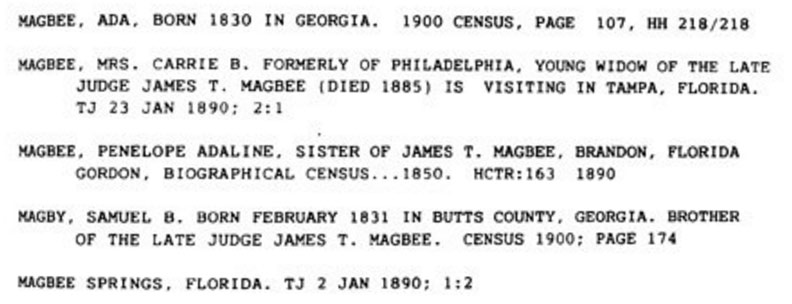
|
Carrie B. Magbee is described as "young
widow," the Tampa Journal newspaper was the source.
Carrie is "visiting Tampa" so she apparently had moved away
before 1890.
HH is not explained in the
abbreviations list.
TJ = Tampa Journal newspaper, followed
by date
HCTR = Hillsborough Co. tax roll
|
Censuses of James T. Magbee and relatives
|
1850 |
Magbee, Hiram & wife
Susanna (Wooten) Magbee (parents of James
T. Magbee) w/children: Adaline, Samuel, Elizabeth and
William, 1850C Heard Co. Ga Lines 12 - 17
This census indicates that Hiram
and his family had moved from Butts Co (red) to Heard
Co. (blue) by 1850. |
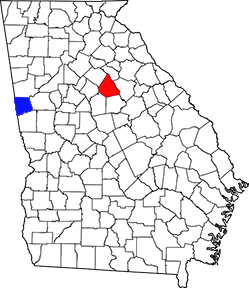 |
|
1850 |
Magbee, James
T, wife Susan A. (Tatum), 1850, Tampa,
Fla. Lines 18 - 19 |
|
1860 |
Magbee, Hiram &
Susanna (Wooten) (parents of James T. Magbee)
with children Elizabeth & Adeline 1860 C Heard Co. GA
Lines 28 - 31 |
|
1860 |
Magbee, James T, wife Susan (Tatum), 1860C Tampa,
Lines 36 - 37 |
|
1870 |
Magbee, James T, wife Julia, mother. Susan, sisters
Penelope & Elizabeth, unk. Dorrie, 1870 C, Tpa Fla
Lines 17 - 23 |
|
1870 |
Magbee, Samuel B, brother of James T. Magbee 1870C,
Lee Co., Ga. Line 18 |
|
1880 |
Magbee,
James T, wife Julia, adopt. son Archie
(Donnelly), printer Thomas Raine, 2 servants, 1880C,
Tampa Lines 35-40 |
|
1880 |
Magbee, Samuel B.,
brother, single, 1880C, Terrell Co., GA Line
45 |
|
1885 |
James Magbee wasn't listed on the
1885 Florida census. According to his 1880
neighbors, he should be near John Krause
here. |
|
1885 |
Magbee,
P. P. sister, (Penelope Adaline) and mother
Susan Magbee 1885 Census, Hillsborough Co, Fla Lines 26 - 27 |
|
1885 |
Magbee, Archie adopted son (Donnelly) 1885C, Leon Co.,
Fla. Line 43 |
|
1900 |
Magbee, Ada sister, (Penelope Adaline) 1900 Census Precinct 16,
Bloomingdale, Hillsborough County Line 13 |
|
1900 |
Magbee, Samuel B., brother, 1900 Census Precincts 7 Peru
(Riverview), Hillsborough Co, Line 77 (b.
Feb. 14, 1831 d. Dec 23, 1906) |
|
1910 |
Magbee, Adaline, sister, (Penelope), single, 1910
Census, Hillsborough Co., Bloomingdale Line 54 |
|
1910 |
Magbee, Archie D. adopted son (Donnelly), wife Fannie
(Frances Pinkard), children Ruth, Francis, Byron,
Katherine, B-in-L Lucius Pinkard Lines 75 - 81
(This record shows Archie immigrated to the U.S. in
1867.) |
|
From all these census records, it would appear that James's
sisters and brother never married nor had children. Only
James's adopted son Archie had children. The whereabouts of
James's brother William, b. ca. 1838 in Georgia is yet to be
found.
|
|
|
|
|
|
|
James T. Magbee
and his family are buried in Tampa's historic
Oaklawn Cemetery, in a plot located on land he donated to the
City. His sister Penelope and brother Samuel are buried in
Woodlawn.
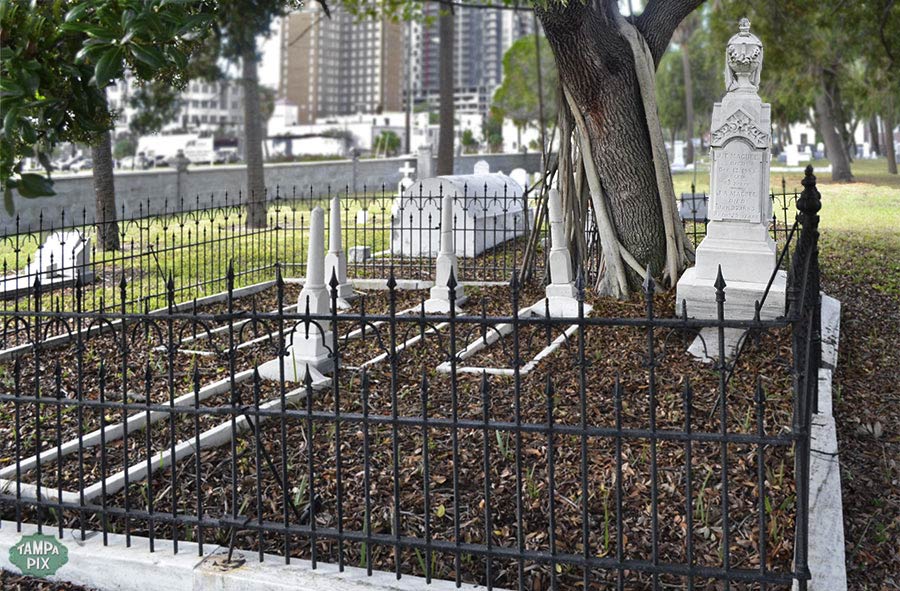
Magbee family gravesite, Oaklawn Cemetery, Tampa.
|
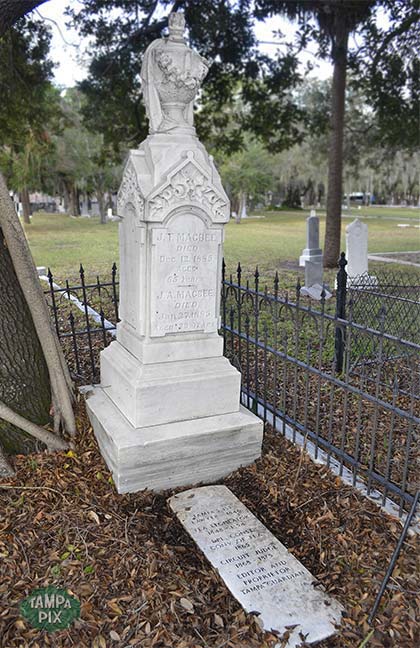 |
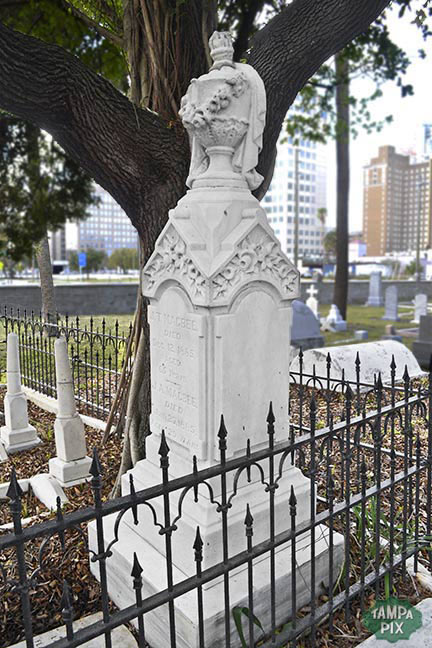 |
| |
|
| |
|
|
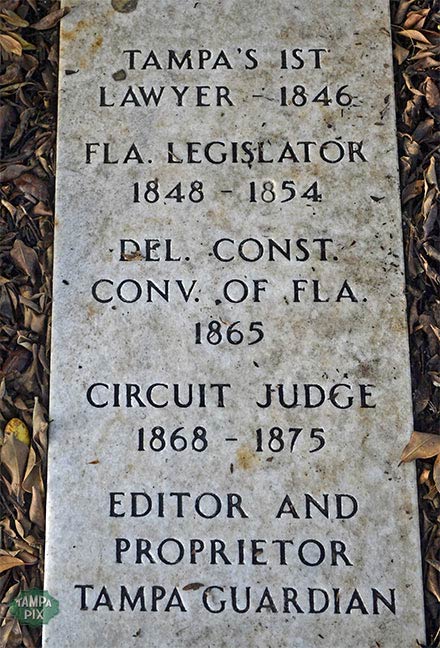 |
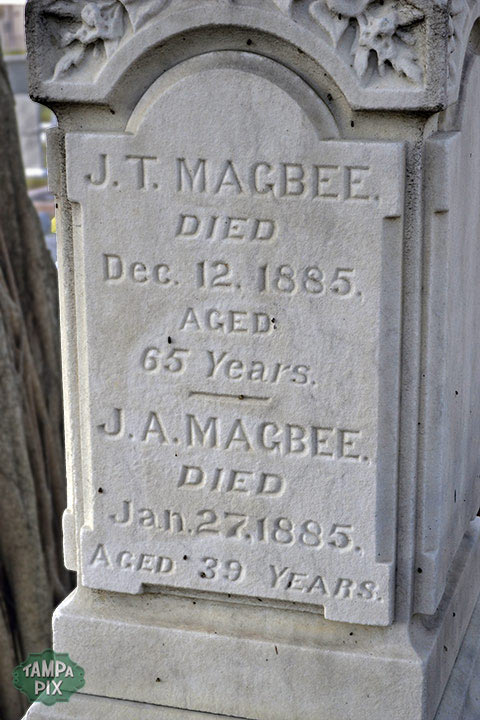 |
|
Lawyer, Florida Legislator,
Delegate Constitutional Convention of Florida, Circuit Judge, Editor and
Proprietor of the Tampa Guardian |
James and 2nd wife Julia
(Henderson) Magbee |
| |
|
|
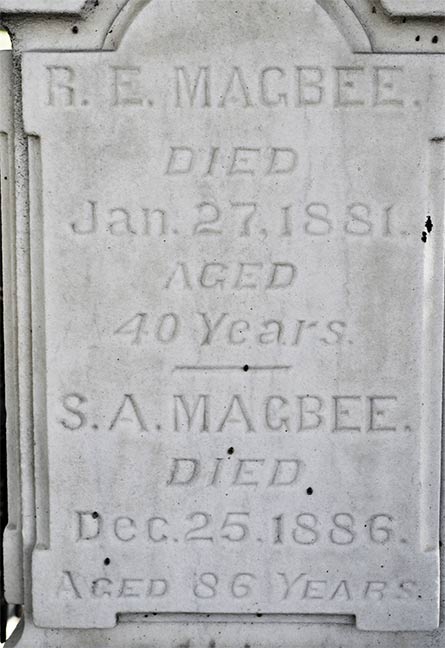 |
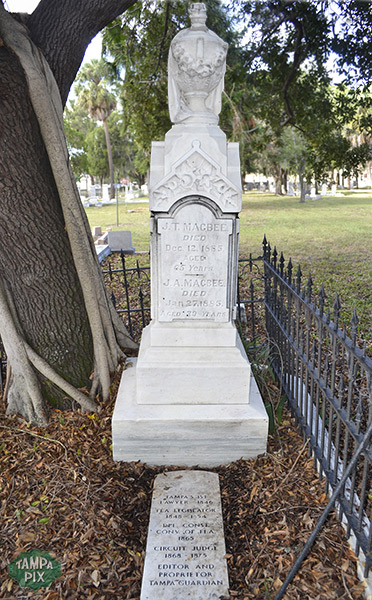 |
|
Sister,
Rachel Elizabeth Magbee and mother, Susanna A. (Wooten) Magbee
|
|
|
The small obelisks mark their
actual burial spot.
|
|
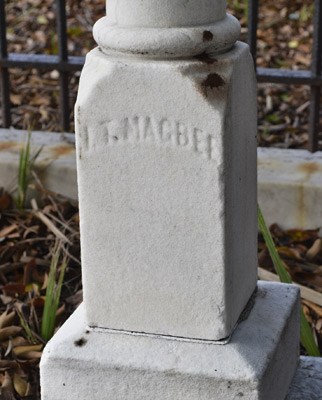 |
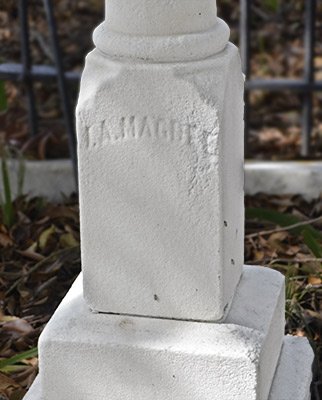 |
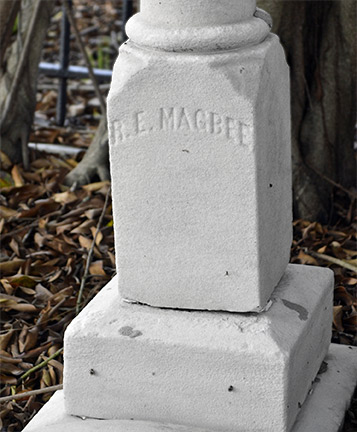 |
|
J. T. Magbee (James) |
J. A.
Magbee (Julia) - Wife |
R. E. Magbee (Rachel
Elizabeth) - Sister |
| |
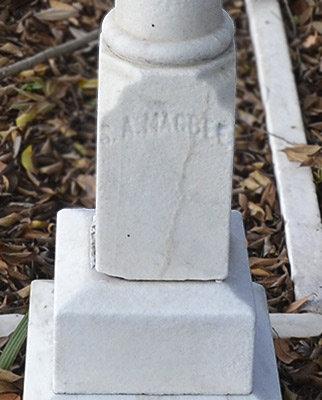 |
|
| |
S. A. Magbee (Susanna
Wooten)-Mother |
|
|
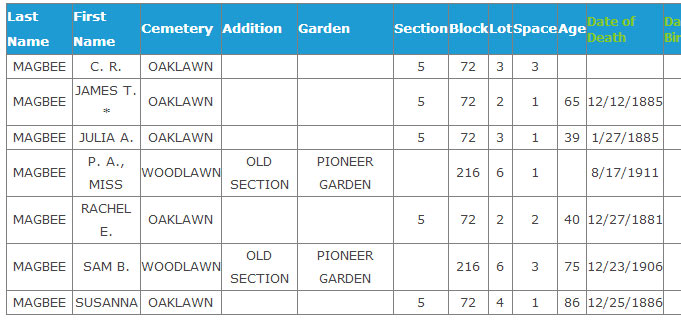 |
|
Magbees listed in City of Tampa Cemetery Records
-
It is not
known yet what relationship C.R. Magbee had to
James T. If the "R" is actually a "B" it
could James's third wife, Carrie Burr Magbee.
Carrie may have outlived all of the Magbee
family in Florida and it could be that at the
time of her death, nobody was left who knew her
age, or date of birth, so her marker may only
bear her initials.
-
P.A. was
James's sister, Penelope Adeline. She
never married and lived out her years in the
Bloomingdale area of the county with her widowed
mother.
-
Rachel E.
Magbee was James's sister Elizabeth, however,
Elizabeth was born circa 1837 on both of her
censuses in Georgia (1850 & 1860) and Rachel E.
has a circa 1841 calculated birth year in this
cemetery record. On James's 1870 census in
Tampa, Rachel is present as "Elizabeth" age 27,
only 4 years older than her 1860 census in
Georgia. Apparently, she never married or
had children.
-
Sam B. was
James's brother who came to Florida from Georgia
sometime between 1880 to 1900 and lived in
enumeration district 7 of Hillsb. Co.--Peru
(today's Riverview/Alafia River area.) No
indication he ever married, was listed as single
in all his censuses.
-
Susanna was
their mother, wife of Hiram Magbee.
-
On the 1850
Census of Heard Co., Ga., James's parents Hiram
(54) and Susanna (50) who married in Jasper Co.,
Ga. in 1816, are listed with their children
Adeline (20), Samuel (19), Elizabeth (14), and
Wm. (12).
-
On the 1860 Census of Heard Co., Ga., James's
parents Hiram (60) & Susanna (46) who
married in Jasper Co., Ga. in 1816, are found
only with their daughters at home, Elizabeth
(23) and Adeline (26)
|
Kyle VanLandingham sums up James T. Magbee:
In
his later years, D. B. McKay seemed to delight in printing
derogatory accounts of Magbee’s career in his weekly "Pioneer
Florida" page which ran in the Tampa Tribune from 1946 to
1960.
Magbee’s alcoholism and his role in Radical Reconstruction made
him an easy target. McKay once described Magbee as "probably the
most widely and intensely hated man who ever lived in Tampa."
See the 1880 Census of Donald Brenham McKay in Tampa, age 12.
Line 47.
Karl Grismer’s Tampa, published in 1950, negatively
portrays Magbee but even Grismer admitted that the Tampa Guardian
was “well edited and most readable."
Theodore Lesley's writings during the 1950s also followed the
same negative line. As late as 1983 in Tampa: The
Treasure City, Gary Mormino and Tony Pizzo once again accepted
the traditional view.
In
Florida’s Peace River Frontier, published in 1991, Canter
Brown, Jr. offered a revisionist version of Magbee, portraying him
in a far more favorable light.
Julius J. Gordon of Tampa has spent many hours researching
Magbee's life and is convinced that this lawyer, politician, and
editor played a positive role in the development of Hillsborough
County and west central Florida. Magbee was clearly an
opportunist, but a look at his enemies reveals the same trait.
Before the Civil War, his main detractors, Henry A. Crane, Madison
Post and James McKay were all ambitious men who did not hesitate
to vilify Magbee to further their own personal objectives.
In the post-Civil War period, James D. Green, Henry L. Mitchell and John
P. Wall were advancing their own agendas when they attacked him.
Circumstances seemed to govern Magbee's life. Greed and hysteria
prompted his removal from the customs position in 1858. An
unfortunate Attorney General's opinion led to his removal from the
Senate in 1862, probably embittering him toward the Confederacy.
The rise of the Radical Republicans in 1867 prompted his move to
the Republican Party and launched his judicial career. Later, the
resurgent Democrats made his downfall inevitable.
In spite of his
weaknesses, Magbee should be remembered for his accomplishments.
Although revenge and opportunism often motivated his actions, he
eventually came down on the side of equal rights for all citizens,
regardless of race.
Always the partisan, he fought for his causes,
and never surrendered.
--Kyle S. VanLandingham
  
Magbee Census Analysis
|
|
|
|
18401
Heard |
18501
Heard |
18602
Heard |
18701
Tampa |
18801 |
18851 |
19001 |
19101 |
1920 |
Born |
|
Hiram |
18-26 |
30-39 |
40-49 |
54 |
60 |
d |
|
|
|
|
|
1796 |
|
Susan |
16-26 |
20-29 |
30-39 |
50 |
46 |
70 |
nf |
85 |
d.12-25-1886 |
|
|
1800 |
|
James
T |
0-9 |
5-9 |
20-29 |
281 |
401 |
50 |
506 |
nf |
d. 12-12-1885 |
|
|
1820 |
|
unknown female1 |
- |
- |
20-29 |
gone |
|
|
|
|
|
|
|
1820-1829 |
|
Penelope
Adeline |
- |
0-4 |
10-14 |
20 |
26 |
37 |
nf |
48 |
708 |
778 |
d.8-13-1911 |
1829 |
|
Samuel
B. |
- |
0-4 |
10-14 |
19 |
nf |
384 |
485 |
nf |
b.Feb 18313,7 |
d. 12-23-1906 |
|
2-14-1830 |
|
unknown male1 |
- |
5-9 |
15-19 |
gone |
|
|
|
|
|
|
|
1831-1835 |
|
unknown male2 |
- |
- |
15-19 |
gone |
|
|
|
|
|
|
|
1831-1835 |
|
Rachel Elizabeth |
- |
- |
0-4 |
14 |
23 |
27 |
nf |
d.1-27-1881 |
|
|
|
1836 |
|
William |
- |
- |
0-4 |
12 |
nf, d? |
|
|
|
|
|
|
1838 |
| |
|
|
|
|
|
|
|
|
|
|
|
|
|
1 James is in Tampa, having turned 20 in 1840.
James should be 30 in 1850 and 40 in 1860. |
|
2 The Magbee family ages in Heard County are off by
quite a bit, info possibly given by a neighbor. |
|
3 Even though Samuel's birth year is given as Feb.
1831 on his 1900 census and is calculated as 1831 or
1832 from his burial and previous three censuses,
the 1830 and 1840 censuses show one male under 5 in
1830 and one male 10 to under 15 in 1840. If
Samuel was born in 1831, he would NOT be on the 1830
census and would have appeared for his first census
in 1840 as a "1" in the age 5 to under 10 age group.
There is not a male counted in that age group in
1840. |
|
4 Lee County, Georgia |
|
5 Terrell County, Georgia |
|
6 James was actually 60 |
|
7 Samuel was in Hillsborough County, Precinct 7,
Peru (this area is now Riverview.) |
|
8 Adeline is living in Hillsborough County,
Bloomingdale |
|
Last Will and Testament of
Rachel Magby (James Magbee's paternal grandmother; Hiram Magbee's
mother.) Source: Recorded Butts County
Wills - Administration Of Estates 1826 - 1841, P239 - 240.
Written: October 9 1833
Recorded: November 7 1833
Georgia
Butts County
In the name of God Amen. I Rachel Magby, being
weak in body, but sound in mind & Memory, do make ordain &
constitute this my last will & testament hereby revoking all
others, in manner and form following, that is to say. It is my wish and
desire that all my property, both real and personal after paying all my
just debts fairly and equitably, be equally divided between all my
lawful heirs, and grand children in manner and form hereafter described,
share and share alike, that is to say. To my son Laban Magbee one share
in fee simple for ever. To my son Hiram Magbee, one share in fee simple
for ever. To my daughter Tabitha Maxcy, one share during her natural
life time, and then descend unto all her children, share and share alike
forever. My daughter Elizabeth Apperson, one share during her natural
life time, and then to descend unto her lawful heirs share & share alike
forever. To my grand children William Pryor, Susan Pryor, and Mary
Pryor, one share being the lawful heirs of my daughter Mary Pryor
deceased, which said share I give and bequeath unto them forever, share
and share alike. I give and bequeath to my grand son in law John P Wyatt
one good feather bed furniture and stead.
Lastly, I constitute make and ordain my son
Laban Magbee and my friend E W Lane my executors to this my last will
and testament in witness whereof, I the said Rachel Magbee have hereunto
set my hand and affixed my seal, in the year of our Lord one thousand
eight hundred and thirty three, this 9th October.
 Signed sealed and delivered in the presence of
us her subscribing witnesses Signed sealed and delivered in the presence of
us her subscribing witnesses
Rachel X Magbee (Her Mark)
James Thompson
Josiah Crain
George L Thompson
Proved Nov 7th 1833. Recorded Butts County Wills
- Administration of Estates
1826 - 1841, p239 - 240. |
| |
|
TAMPA WATERWORKS
CO.
vs.
GEORGE W. CLINE
This Supreme Court case reveals general information about the
ownership of the Magbee Spring area, and the hydrology of the
spring itself.
According to "Cases
Adjudicated in the Florida Supreme Court, Jan. term, 1896,
in a previous State Court case,
Tampa Waterworks Co. v. George W. Cline, concerning
the land formerly belonging to James T. Magbee where the
waterworks spring was located, complainant Tampa Waterworks
Co. sought an injunction against George W. Cline Sr. and Jr. Apparently,
the Clines were
excavating on their property, and among other allegations of
malicious intent, planned to build a bathing
pool. Tampa Waterworks claimed this would interfere with
the flow of the spring and was polluting the water used in
supplying the city.
The State Court
case was originally filed against George W. Cline Sr. and Jr,
but then was amended later to include only Sr. upon the death of
Jr.
The Tampa
Waterworks Co. (hereinafter "TWC") was in contract for 30 years
with the City of Tampa to furnish an abundant supply clean
water for the purpose of drinking. To accomplish this,
the corporation acquired title in fee to Lots 6 and 7 in Block
28 [sic] (should
be Block 23, there is no Block 28)
in the first addition to Highland Park, in the South half
of Lot 1, Sec. 13, Towship 29 South, Range 18 East, according
to a Brown and Swingley plan and map used as an exhibit:
The lots were
originally a part of a much larger tract of land owned by
James T. Magbee, deceased, and that his heirs and distributees
laid off the tract into lots and blocks, with streets and
alleys, all within
the corporate limits of the City of Tampa. That Lot 6
has issuing from underneath the ground thereon natural
spring of water which is supplied by a well-marked and
defined subterranean
stream coming from the east, and flowing underneath the ground
at a depth of 12 or 15 feet below the surface of land
of both defendant Cline and complainant Tampa Waterworks
Co.,
until it issues out of and forms the spring in Lot 6, where it
again disappears beneath the surface, but comes out again a
few feet from the western boundary of complainant's land and
flows thence in a stream in a westerly course to the
Hillsborough River, some 200 feet away.
TWC and those who
have owned this land for at least 17 years prior, highly
prized the water for its purity, and if maintained in its
present state would continue to be useful in its obligation to
supply the city with water.
Complainant TWC
alleged that George Cline Sr, with the intention to harass and
injure TWC, had recently acquired title to lots 1, 8, 9 & 10,
in block 23, immediately above TWC's land, and was proceeding
to excavate, and had excavated, a large and deep hole on his
lot 8, near the TWC's lot 7, which was around 18 to 20 feet in
circumference, and some 12 to 14 feet deep, which penetrated
to the water of the subterranean stream.
In the diagram below, the 1888 First Addition to Highland
Park with the Magbee Spring has been overlaid onto a present
day plat of Block 23 and 24, Tampa Waterworks Co. Lots 6 & 7 are
marked in green, Cline's Lots 1, 8-10 marked in red.
Location of Cline's excavation is approximated with X in
blue dot. The wavy blue arrow marks the general flow
direction of the underground stream as Tampa Waterworks
contends.
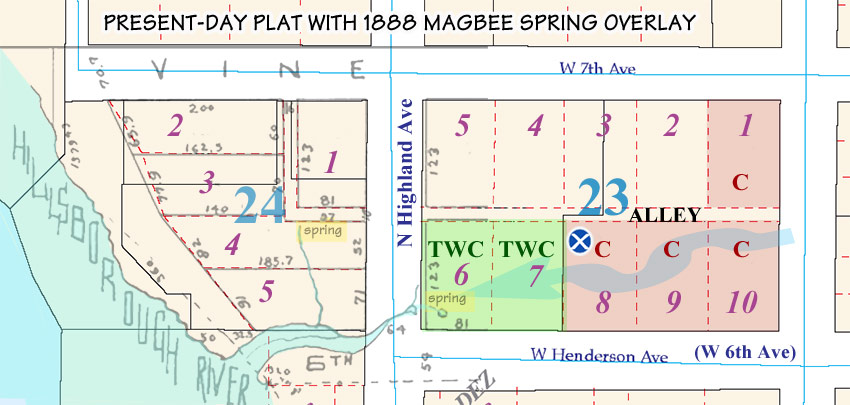
TWC charged that
in making the hole, Cline acted wantonly and maliciously, for
the purpose of injuring TWC by polluting the water flowing
into the spring, and diminishing the flow, which would happen
if the continued to be dug or was permitted to remain.
TWC further
charged that Cline intended to put up a bathing pool or pools
where the hole was, and would if not restrained, use it to
pollute and diminish the flow of water, with the view to
damage the TWC, or compel it to purchase that land at an
exorbitant price.
Mention is made
that TWC expended large sums of money previously drilling a
well somewhere else, but failed to secure a large enough water
flow sufficient to supply the city. (This well would
have been #1 at 6th Ave. & Jefferson St.)
TWC further
contended that the Magbee spring was the only one with enough
water to supply the city economically, and if Cline was
allowed to continue, the water would become polluted and
totally worthless. That the water runs under and between
a rock formation, the top of which is some 6 feet below the
surface, and extends down until the subterranean stream is
reached, and without the excavation being made, it is not
possible to pollute the water until it comes out on TWC's
land, at which time they could thoroughly protect it when its
waterworks was built.
TWC asked for an
injunction, if even only a temporary one, stopping Cline from
further digging and making him fill up the hole.
Cline's answer
was that the south half of Section 13, of TS20S, R18E,
belonged for many years to Magbee who conveyed 7 acres of it
in 1885 to Cline's wife. That Magbee died still owning
the remainder of the lot, which had recently been laid off
into lots, blocks and streets, and that W.A. Jeter and G.A.
Boardman purchased by mesne conveyances* from a distributee of
the Magbee estate (which would have been Magbee's sister, or
brother, or maybe even widow) Lots 6 & 7 of block 23, and
afterwards sold them to TWC. Then in July, 1889,
defendant Cline purchased from the distributees of Magbee's
estate, lots 1, 8, 9 and 10 in block 23, for the purpose of
improving and beautifying the lots and developing their own
water supply. That soon afterwards, began to excavate a sink
on lot 8, at a point about 20 feet from the alley, and a few
feet east of TWC's lot 7, and after removing a large amount of
marl** and decayed vegetable matter, came upon a large spring
of pure cold water of great use and value to Cline and the
estate which he had purchased. He also developed a large
bed of marl of great value as a fertilizer and for paving
roadways and sidewalks, and hoped would yield him great profit
in helping to defray the expense of cleaning out and
beautifying the spring.
*
Mesne conveyance - An intermediate conveyance; one
occupying an intermediate position in a chain of title
between the first grantee and the present holder.
**Marl -
An unconsolidated sedimentary
rock or soil consisting of clay and lime, formerly used
typically as fertilizer.
Furthermore,
Cline stated that the land to the west of the excavation he
was making to improve the spring falls rapidly to the street
over 2 lots of the TWC's land, so that when the sand and marl
are removed and the excavation enlarged to open up the sink to
its natural edge, no rain falling around the excavation can
run into TWC's property. That the level of the water in
Cline's spring is 13 feet below the surface of the surrounding
land, and about 4 feet above the water level in the ground, so
that the surface water can not come into the spring fully
saturated with water, which can only occur in case of unusual
flood, and then the water would come by percolation through
the sand and marl into the spring, but at no greater extent
than if the excavation had not been made. That the sand
of the countryside was coarse, the topsoil spongy, and the
underground drainage so complete that no water ever seen on
the surface.
Cline's answer
denied that the spring comes out of the ground on TWC's land,
and denies that he has polluted, or intends to pollute, the
water in the stream. He denied that he intended to
divert the spring from its natural channel, or that the rays
of the sun, and the surface drainage by reason of the
excavation, will pollute the spring. He also denied that
he purchased the lots with intent to harass and injure TWC, or
that the excavation was made maliciously for the purpose of
compelling TWC to purchase the lots, and the allegations of
the intent of Cline to put bathing houses in the water and
thereby pollute it, were denied.
Cline said that
the excavation was made in good faith for the purpose of
enhancing the value of his own lots, and to lawfully use the
water, and that his spring is not supplied by a subterranean
stream with a well-defined channel, but by water coming from
unknown and undefined sources, and that the water comes from a
great depth and from unknown percolations.
Cline then filed
a motion to dissolve the injunction, a upon the preliminary
hearing there was a modification of the injunction granted, to
the extent of allowing Cline to dig to the stream and take a
reasonable quantity of water as might be necessary for his
use, but not to take or divert the water wantonly, or to
transport it to another place. The modification also
permitted Cline to quarry any stone he might desire, provided
that he did not pollute or injure the water flowing into TWC's
spring.
Testimony was
then taken, and upon final hearing the bill was dismissed and
TWC appealed.
What follows in
the Supreme Court case are the opinions of that court and the
precedents on which it ruled. In those opinions, the
Court considers much information pertaining to geology of
springs and rights to them, and makes these comments:
The tract of land
through which the water in question runs belonged for many
years to James T. Magbee, and after his death, some time
during the year 1888, his heirs and distributees had it
platted into lots, blocks and streets, which are now within
the corporate limits of the city of Tampa. Appellant (TWC),
through mesne conveyances, acquired title to Lots 6 & 7 of the
plat in the early part of 1889, and a few months later
appellee (Cline) purchased Lots 1, 8, 9 and 10, which were
immediately east or northeast of TWC's lots. The
formation of the land 12 to 15 feet below the surface, and in
which water is found, is of a limestone character.
There is some
diversity of opinion among the witnesses as to the character
of the rock in contact with the water. One of TWC's
witnesses, an expert, states that the rock in contact with the
water was stratified (layered), and away from it was in
boulders lying in detached lumps. Considering all the
evidence there is no doubt that the land is underlaid with
rock of a limestone formation. Issuing from the Magbee
tract of land not far from the Hillsborough River was a bold
spring of constantly flowing water, known as "Magbee Spring,"
and the plat located this spring in a street or avenue.
The lots purchased by TWC were east and northeast and nearest
to the spring. From the spring east and northeast across
the lots of both parties there were surface depressions or
sinks, such as mark the course of subterranean streams in
limestone regions. On one of TWC's lots a sink went down
so that the water below could be seen, and at or near this
point the company's waterworks for supplying the city with
water were established. A deep shaft was dug (by Cline)
and a reservoir made to receive the water running in an
underground stream, and it is an alleged diversion and
disturbance of this water supply that caused the company to
complain. Appellant (TWC) commenced to excavate first
(referring to TWC's first attempt for #1 at 6th Ave &
Jefferson St.) but then changed locations. Before (TWC's)
2nd excavation for the reservoir (at Magbee) was commenced,
Cline began an excavation in a sink on one of his lots a short
distance away, and had reached a stream of running water when
the injunction was served on him. From the evidence in
the record we are satisfied that the stream reached by Cline
in his excavation extends to the reservoir of TWC. The
source of this steam is left in speculation, without definite
proof, but from all that is shown we are of the opinion that
this is a well-defined subterranean stream flowing through the
lands of both parties.
There is some
diversity of opinion among the expert witnesses examined by
TWC as to the course and limits of the stream. From
Magbee Spring, where the stream issues from the ground, to the
river, the banks are 20 or more feet wide, and one expert
states that the stream above covers an equal space in circuit;
while another was of the opinion that it covered a much larger
space, and was probably supplied by several lateral streams
converging at the point where the reservoir of TWC was
located. The depressions and surface indications in a
direct line over the lands of the parties, and for some
distance further east, indicate a sub-surface stream as found
in limestone formations. The capacity of this stream at
the reservoir, not more than 175 feet from Cline's excavation,
is between 2 and 2 1/2 millions of gallons of water per
day, and fresh water fish from 6 to 10 inches long were
discovered in both excavations. The water when muddied
or colored with analine dyes in Cline's shaft showed in a
very short time in the one below, and from such evidence of
a well-defined stream taken in connection with that of the
experts we do not doubt that it does exist. The rule
as to well-defined surface streams must therefore be applied
to the stream in question. Cline has the right to the
use of this water as much as if it ran upon the surface of
the ground. He cannot divert or pollute it, but he may
open up a water supply on his own land so as not to
interfere with the legal rights of adjoining owners, and
also make a reasonable application of the water, certainly
for domestic purposes. We discover no reasonable
objection to the improvement of his own property by the
removal of the soil in the depression between the rocks,
over the stream and beautifying the place by opening an
accessible way to the water. The mere opening of a
space so that the rays of the sun can reach the water below
will not of itself be a contamination or an unreasonable use
of it. It is true that impurities from surface
drainage might get into the stream if unprotected and
thereby pollute it, but this cn be guarded against; and it
is the duty of Cline to prevent the surface water from
overflowing into the opening made by him. There is no
sufficient showing that any serious injury has been done, or
will be done with proper precaution, to the stream by reason
of the opening. The maxim, sic utere tuo ut non
alienum laedas* will apply.
*The maxim sic utere tuo ut alienum non laedas does not mean that one must
never use his own property in such a way as to do any injury
to his neighbor. It means only that one must use his
property so as not to injure the lawful rights of another.
Under this maxim, it is well settled that a property owner
may put his own property to any reasonable and lawful use,
so long as he does not thereby deprive the adjoining
landowner of any right of enjoyment of his property which is
recognized and protected by law, and so long as his use is
not such a one as the law will pronounce a nuisance.”[
Fontainebleau Hotel Corp. v. Forty-Five Twenty-Five,
Inc.,114 So. 2d 357 (Fla. Dist. Ct. App. 3d Dist. 1959)]
We do not see
that we can hold, on the showing made, that Cline has
diverted the water in the stream. According to the
testimony of witness Campbell...(two opposing witness
opinions presented.)
We do not think
the testimony shows that Cline acted wantonly and
maliciously...
We are further
satisfied that it is not sufficiently shown that Cline
intended to devote his excavation to bathing purposes...
If it is not
affirmatively shown that the subsurface water is supplied by
a definite flowing stream, the presumption is that it comes
from ordinary percolations. The testimony is also
indefinite as to the character of the blasting done or
contemplated by Cline, and our conclusion is that the decree
(of the lower court) should be affirmed on the evidence.
While Cline has
the right to use the stream in the manner indicated, and may
also make such legitimate use of his own property as he
pleases, he must do so in a manner not to divert or pollute
the stream of water flowing through it.
On the
allegations of the bill and the evidence submitted, the
decree will be affirmed, and it is so ordered.
George W Cline Jr
gravesite
|
|
About Archie Donnelly
Magbee, James & Julia's adopted son
From an archived genealogy post of Feb. 27, 2004 at RootsWeb, by
Clare [Some of her notes are not
accurate.]
I first heard his
name from Mace Magbee of Whittier Ca. in 1994, wanting to know if
I had James T. Magbee in my data base. I did not but did a little
research for him. Mace has a brother Byron "Jr." whom I also
corresponded with and he gave me information on their family, but
nothing on James T.
Here is what I found
then: James T. Magbee b. c. 1820 in
[CLARKE CO.] Ga d. Tampa FL, was
married to a woman named Julia. He and Julia adopted a boy named
Archie Donnelly who immigrated from Edinburg, Scotland.
Archibald Donnelly (he changed his name to Magbee) married Fanny
Pinkard in Atlanta c. 1890 and had 4 children, Ruth, Francis,
Byron "Sr." and Kathryn.
Mace and Byron are
the sons of Archibald and Fanny's son Byron "Sr." who died in
Columbus, OH. According to Byron "Jr." Magbee, the grandson,
Archibald and his brother Lucius**
were brought to this country by
their parents about 1860, the parents died during the voyage and
the two young boys were orphans landing in Key West. They were
adopted by Judge Magbee.
**TampaPix note: There is no record of a brother to
Archie Donnelly in the home of James T. Magbee, nor does any
historian mention Lucius. Lucius was Archie's brother-in-law, born
in Alabama, brother of Archie's wife Frances Pinkard. See
link for 1910 Census of Archie Magbee above. Archie
immigrated to the U.S. in 1867 according to his 1910 census in
Clinton, Franklin Co., Ohio.
Apparently Lucius
went to Tulsa, OK (I know there are Magbee's in OK but don't know
if they are the descendants of Lucius Donnelly (or Magbee?)
[or] Archibald, also was in the newspaper employ in Atlanta and worked
last being at The Miami Herald where he died in 1951 in Miami.
James T. Magbee had
no children of his own. I was able to find nothing more on James
T. Magbee at that time so just filed it away in my "great file" of
unknowns. Now to the present!
In January I was
working in the University of South Florida Library, in Tampa, ask
to have some copies made of material I had found on my husband's
Simmons line, and had to give them my name. The very nice
Librarian ask me if I was related to Judge James T. Magbee, a very
well known person in Tampa in the 1880s. I said no but I knew of
him. He printed me out pages and pages about this man and this is
what the print out said...
...He was married 3
times, Susan Adaline (Almeria?) Tatum, 2. Julia and 3. Carrie Burr Fisher.
James T. was born c. 1820 in Butts Co., GA and died in Tampa 12
Dec 1885, the son of Hiram Magbee and Susanna Wooten. Hiram was
the son of James Magbee and Rachel Buckley. His older brother was Laban Magbee who married Rebecca Whatley in Greene Co., GA in
1806. Laban is my husbands ancestor. If you would like more on
this James T. Magbee I would be happy to copy the information and
send it to you but this is basically all the genealogical
information on him.
The rest is about his
antics and career, his burial, (if I remember correctly he gave
the land for the city cem. in Tampa). Hope this sparks some
interest in this line. I believe that James Magbee who was married
to Rachel Buckley was the son of James Magbee and wife Sara (they
died in Franklin Co., GA , both James Magbees died about the same
time. I have not been able to prove that James and Sarah were the
parents of James married to Rachel. Surely would like help there.
I also know of any other children of Hiram and Susanna Wooten.
Hiram was not of age when his father died and Laban, his brother
was named his guardian. --Clare
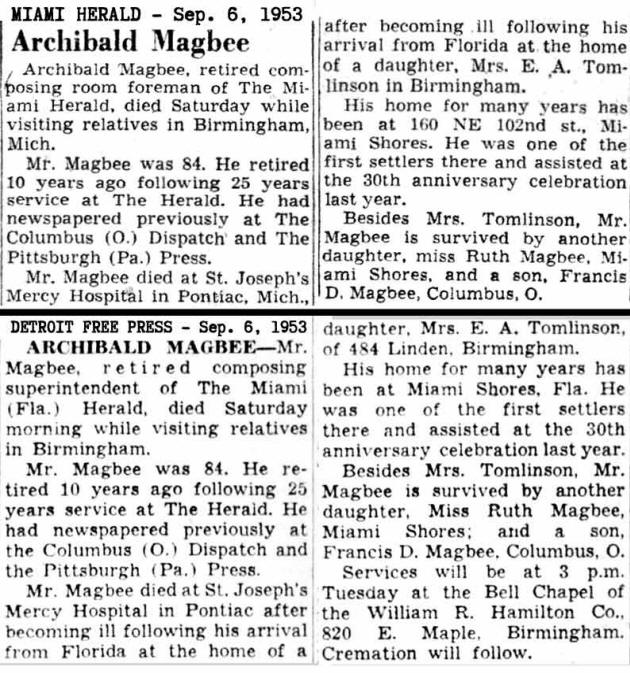
PORTRAIT OF ARCHIE D. MAGBEE COURTESY OF BILL PRICE
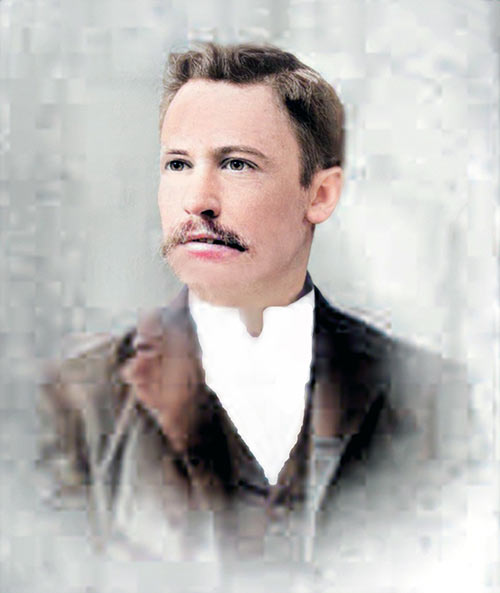
This feature
relies heavily on
this excellent biography of James T. Magbee by the late
Kyle S. VanLandingham, a direct descendant of William B.
Hooker. It appeared in the Nov. 1994 Sunland
Tribune, Journal of the Tampa Historical Society.
JAMES T. MAGBEE: “Union Man, Undoubted Secessionist, and
High Priest in the Radical Synagogue” By Kyle S.
VanLandingham, at the USF Digital Collections.
 VANLANDINGHAM,
Kyle Samuel, 57, who was a historian and genealogist, died
November 17, 2009, in a Denver hospital from the H1N1
virus, also known as swine flu. He is survived by his
mother, Jane Ernestine Alderman VanLandingham; and
brother, Larue Pierre VanLandingham and wife, Denise, of
DeFuniak Springs, Fla. He was preceded in death by his
father, Samuel Pierre VanLandingham. VANLANDINGHAM,
Kyle Samuel, 57, who was a historian and genealogist, died
November 17, 2009, in a Denver hospital from the H1N1
virus, also known as swine flu. He is survived by his
mother, Jane Ernestine Alderman VanLandingham; and
brother, Larue Pierre VanLandingham and wife, Denise, of
DeFuniak Springs, Fla. He was preceded in death by his
father, Samuel Pierre VanLandingham.
Mr. VanLandingham was born
December 10, 1951, in Fort Pierce, Fla., where he
graduated from Dan McCarty High School. He subsequently
received a Bachelor of Arts degree from Maryville College
in Maryville, Tenn., and a Juris Doctor degree from the
Cumberland School of Law at Samford University in
Birmingham. After receiving his law degree, Mr.
VanLandingham opened a law office in Okeechobee, Fla., and
shortly thereafter was appointed county attorney for
Okeechobee County in 1978. He held that office for just
short of 10 years, at which time he came into a family
inheritance. Resigning his position as county attorney, he
embarked on what would be his true vocation, researching
and writing about genealogy and Florida history. He also
indulged his love of travel, visiting 26 countries. When
traveling in the United States, he was always on the
lookout for the best local barbecue. His favorite was
Eastern North Carolina BBQ. After leaving Okeechobee, Mr.
VanLandingham lived in Savannah, Riverview, Fla.,
Kerrville, Texas, and Denver, Colo. While in Riverview, he
was active in the Tampa Historical Society, serving as
president for one year, as editor of their publication,
Sunland Tribune, for seven years, and contributing
numerous articles. During this time, he authored the book,
In Pursuit of Justice: Law & Lawyers in Hillsborough
County 1846- 1996. His other books include Florida
Cousins: The Descendants of William H. Willingham, Parker
and Blount in Florida, A History of Okeechobee County,
Pioneer Families of the Kissimmee River Valley and
Pictorial History of Saint Lucie County 1565-1910. Mr.
VanLandingham also served as the president of the St.
Lucie County Historical Society for one year and as a
director of the Florida Historical Society for three
years. Mr VanLandingham was a Mason and served as the
Worshipful Master of Okeechobee Lodge No. 237 Free &
Accepted Masons in 1985. Kyle, who took great pride in
being a sixth-generation Floridian, will be missed by his
family and all his historical and genealogical
collaborators, for whom he was an endless source of
valuable and accurate information.
Published in the Tampa Bay
Times on Dec. 10, 2009
|
|
SOURCES
(For this feature and the Magbee/Ulele Springs history feature.)
-
Beck Group, Architects, Constructors, website
-
Bureau of
Land Management, Government Land Office records
-
Biographical Directory of the United States Congress, 1774 -
Present
-
Biographical Sketches of Circuit Judges, Florida's 10th Judicial
Circuit - James T. Magbee
-
Blockaders, Refugees, & Contrabands - Civil War on Florida's
Gulf Coast, 1861-1865 by George E. Buker, "Henry Crane -
Unionist"
-
City of Tampa Local Historic Landmarks
-
City of Tampa Parks & Recreation Dept., Oaklawn Cemetery
-
City of Tampa website, Previous Tampa Mayors
-
Civilwaralbum.com, Courthouse Civil War Monument
-
Ecosphere Restoration Institute
-
Exploring Florida, Maps ETC.
-
Exploring Florida, Capt. James McKay, I, historic marker
-
Familysearch.org, census records, marriage records
-
Florida Civil War Blockades: Battling for the Coast By Nick Wynne,
Joe Crankshaw
-
FLORIDA HISTORICAL QUARTERLY, Vol. 70, No. 4, April 1992 -
TAMPA’S JAMES MCKAY AND THE FRUSTRATION OF CONFEDERATE
CATTLE-SUPPLY OPERATIONS IN SOUTH FLORIDA by CANTER BROWN, JR.
-
Florida Memory, State Library & Archives of Florida, Photographs
-
FLORIDA STATE UNIVERSITY LAW REVIEW, Vol. 6, Issue 1, Winter
1978, Frederick B. Karl Marguerite Davis - Impeachment in
Florida
-
Genealogy Trails, Old Guardianships
-
Hillsborough Lodge No. 25, F. & A.M.
-
Historium.com American History blog
-
Internet Archive, THE LIFE OF FERDINAND DE SOTO, DISCOVERER OF
THE MISSISSIPPI (Images)
-
Jean Street Shipyard
-
Journal of Civil War Era, Paradise Lost - Egmont Key
-
KEY WEST: THE OLD AND THE NEW,
by Jefferson Beale Browne, pub. 1912.
-
LaMartin.com, William B. Hooker, Orange Grove Hotel
-
Maps, Etc. Johnson's Florida, 1860 Johnson, A.J., Johnson's
New Illustrated Family Atlas (New York, NY: Johnson and
Browning, 1860)
-
Maps Etc., Asher & Adams, Florida,
1871
-
MEMOIRS OF GEORGIA, VOL 1. By the Southern Historical
Assoc., 1895.
-
National Fish Habitat Partnership
-
None Can Have Richer Memories: Polk County, Florida, 1940-2000.
Brown, Canter, Jr. Published by Tampa, FL: University of Tampa
Press, Polk County Historical Association, (2005). First
Edition. (2005)
-
Naval History and Heritage Command
-
Old Florida Ephemera and Musings - Tampa's Urban Springs
March 2, 2013
-
Old Florida blog - Ulele Spring 2.0 - April 2014 photos of the
spring construction and restoration
-
Ossian Bingley Hart: Florida's Loyalist Reconstruction Governor
By Special Assistant and Counsel to the President Canter Brown,
Jr, 1997
-
Pioneer Florida, Volume 2, Chapter 10, "A Self-Made
Scalawag" by Donald Brenham McKay Southern Publishing
Company, 1959
-
Scholar Commons, University of South Florida, SUNLAND
TRIBUNE, Nov. 1, 1994 - Politics, Greed, Regulator Violence, and
Race in Tampa, 1858-1859 By Canter Brown, Jr.)
-
States in the Senate: Florida
-
Tampa, A History of the City and the Tampa Bay Region of
Florida, by Karl H. Grismer, edited by D. B. McKay, 1950.
-
Tampa Bay History
Magazine, Vol. 19, No. 2- Fall/Winter 1997 Bringing Justice
to the Frontier: Crime and Punishment
in Antebellum Hillsborough County by James M. Denham.
-
Tampa-Hillsborough County Public Library, Burgert Brothers
digital collection
-
Tampa Riverwalk Monument Trail
-
Tampa Seeks Developers to Turn Historic Water works building
into Cafe Sept. 2011, Tampa Bay Times, Richard
Danielson
-
Tampa Tribune TBO.COM
Princess Ulele is local history
mystery, May 31, 2014, by Paul Guzzo, Times Staff Writer.
-
TAMPA'S HISTORIC CEMETERIES, by Shelby Jean Roberson Bender
& Elizabeth Laramie Dunham- Grave site of the Magbee family.
-
The American Battlefield Protection Program
-
The Florida Historical Society, Governor William Dunn Moseley
-
The Hillsborough River Raid and Battle of Ballast Point
by Lewis Zerfas, America's Civil War magazine.
-
The Mayors of Tampa 1856 - 2015
-
The New York Times, 1862 News
-
The Robles Family During the Civil War in Tampa, by Karen
Lucibello
-
The Scalawags: Southern Dissenters in the Civil War and
Reconstruction, by James Alex Baggett
-
The South Florida Rifles, Officers Biographies
-
THE SUNLAND TRIBUNE, Journal of the TAMPA HISTORICAL
SOCIETY, Volume XX November, 1994,
JAMES T. MAGBEE:
“Union Man, Undoubted Secessionist, and High Priest in the
Radical Synagogue” By Kyle S. VanLandingham, Editor in Chief
-
THE SUNLAND TRIBUNE, Journal of the TAMPA HISTORICAL SOCIETY,
Volume VIII Number 1 November, 1982 - JAMES McKAY, I, THE
SCOTTISH CHIEF OF TAMPA BAY By Tony Pizzo, and WHAT HAPPENED IN
TAMPA ON JULY 15, 1887 OR THEREABOUTS by Joseph Hipp
-
THE SUNLAND TRIBUNE, Journal of the TAMPA HISTORICAL SOCIETY,
Volume XVII November, 1991 Journal
of the Tampa Historical Society
-
TAMPA AND THE
COMING OF THE RAILROAD, 1853-1884, by Canter Brown, Jr.
-
THE SUNLAND TRIBUNE, Journal of the TAMPA HISTORICAL SOCIETY ,
Vol. 10 December, 1984- TURN TO GREATNESS - Dr. John P. Wall, By
Hampton Dunn
-
THE SUNLAND TRIBUNE, Journal of the TAMPA HISTORICAL SOCIETY,
Volume XIV November, 1988 - FORT BROOKE: THE FIRST TEN YEARS By
Tony Pizzo
-
THE SUNLAND TRIBUNE, Journal of the TAMPA HISTORICAL SOCIETY,
Volume XVIII November, 1992 - THE TAMPA FLORIDA BREWERY, INC.
FLORIDA’S FIRST BREWERY By CLIFFORD C. (KIP) SHARPE
-
THE SUNLAND TRIBUNE, Journal of the TAMPA HISTORICAL SOCIETY,
Volume VI Number 1 November, 1980 - THOSE HELL-RAISIN’ TAMPA
NEWSPAPERS By Hampton Dunn - James T. Magbee
-
THE SUNLAND
TRIBUNE, Journal of the TAMPA HISTORICAL SOCIETY, Volume XXIII
November, 1997 - TO FAITHFULLY DISCHARGE MY DUTY: THE LIFE AND
CAREER OF PERRY GREEN WALL By Kyle S. VanLandingham, and JAMES
GETTIS: TAMPA PIONEER LAWYER By KYLE S. VanLANDINGHAM
-
THE SUNLAND TRIBUNE, Journal of the TAMPA HISTORICAL
SOCIETY, Volume XIX, Nov. 1993, THE KNOW-NOTHINGS OF
HILLSBOROUGH COUNTY, by Spessard Stone
-
THE SUNLAND TRIBUNE,
Journal of the TAMPA HISTORICAL SOCIETY, Volume XXII, Nov. 1996,
CAPTAIN WILLIAM B. HOOKER: FLORIDA CATTLE KING, By Kyle
VanLandingham
-
The War of the Rebellion:
v. 1-53 Formal reports, both Union and Confederate, of
the first seizures of United States property in the southern
states, and of all military operations in the field, with the
correspondence, orders and returns relating specially thereto.
1880-98.
-
ST. PETE TIMES, Feb. 21, 2014 -
Ulele Spring will soon will be a feature in Water Works Park, a
stop along the Tampa Riverwalk. A defender of freshwater
springs restores one in Tampa - by Elisabeth Parker, photo by
Skip O'Rourke
-
Ulele Restaurant
website
-
Ulele, a restaurant for the next century, by Tribune Staff
writer/photographer Jeff Houck, Aug. 10, 2014
-
University of
Florida, George A. Smathers Libraries, Digital Map Collections,
Sanborn Fire Insurance Maps of Tampa
-
University of Minnesota Library, Clarence Darrow digital collection
-
U.S. Naval History, Heritage Command, Photograph Collection
Saving Fairyland
Page 1
Page 2
Page 3
Page 4
Page 5
Page 6
Page 7 (Fairyland at Ulele - A History of
Magbee/Ulele Spring & Tampa's Waterworks)
Lowry Park/Fairyland History
Herman - King of the Zoo
Safety Village
Fantasia Golf
00,2B,00 Dark
green
TampaPix Home |


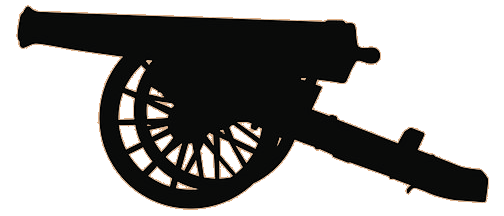


 By James
McKay, Jr. in "
By James
McKay, Jr. in "


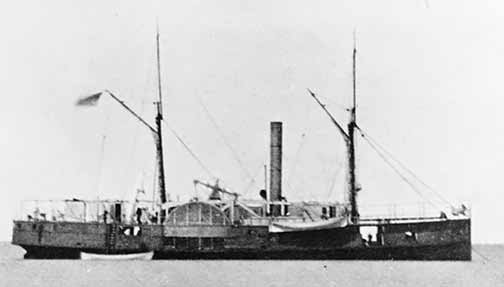
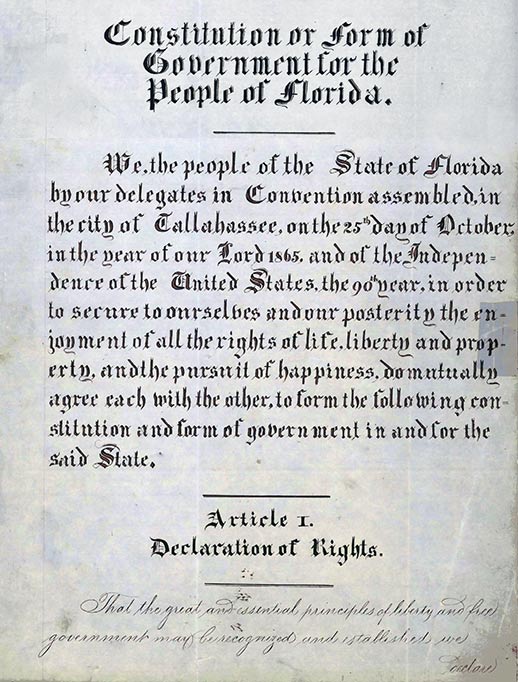




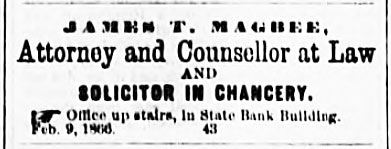


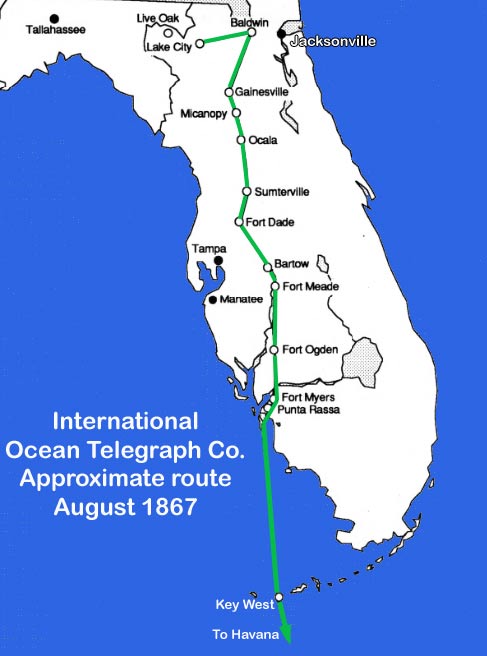
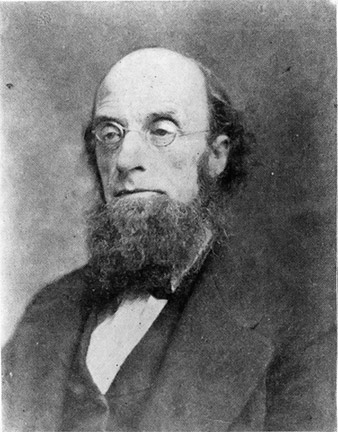
 Claiborne R. Mobley of Tampa, an ally of
James D. Green, also wanted the judgeship, but was forced to
settle for the position of State Attorney for the 6th Circuit.
After Senate confirmation, Magbee’s appointment was announced in
the August 15, 1868 edition of the Florida Peninsular.
Editor Henry L. Mitchell stated:
Claiborne R. Mobley of Tampa, an ally of
James D. Green, also wanted the judgeship, but was forced to
settle for the position of State Attorney for the 6th Circuit.
After Senate confirmation, Magbee’s appointment was announced in
the August 15, 1868 edition of the Florida Peninsular.
Editor Henry L. Mitchell stated: 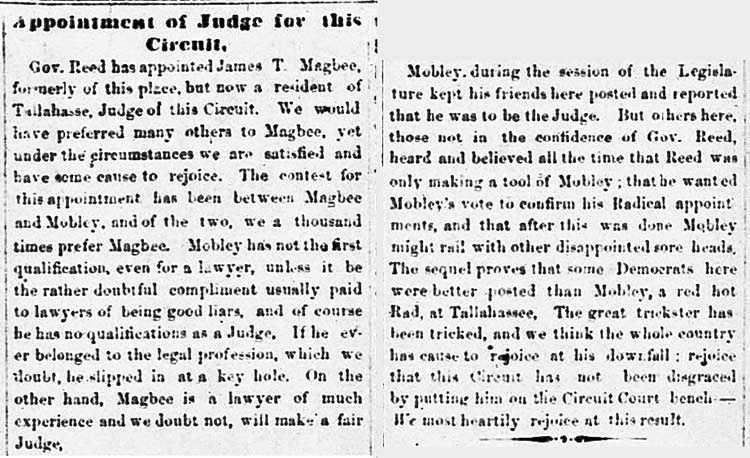









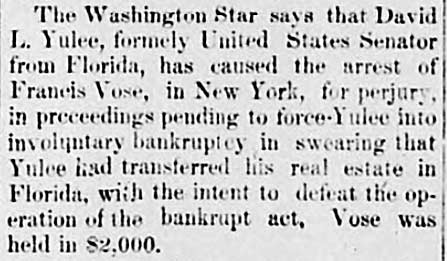
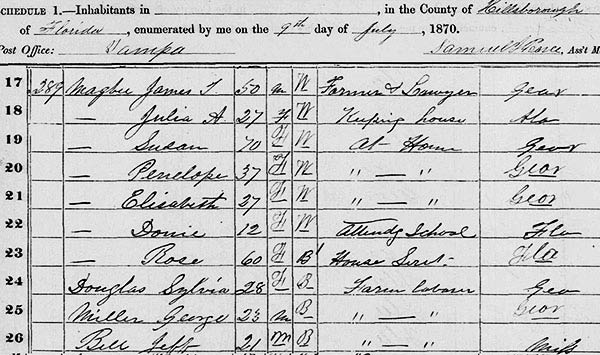



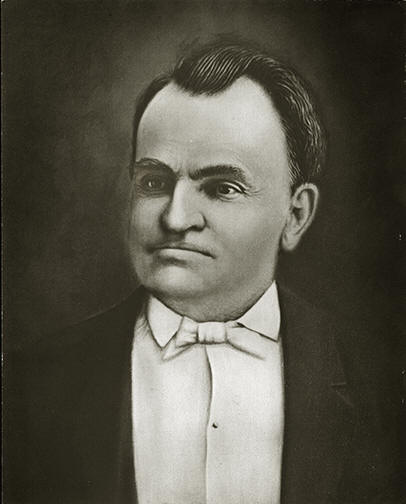





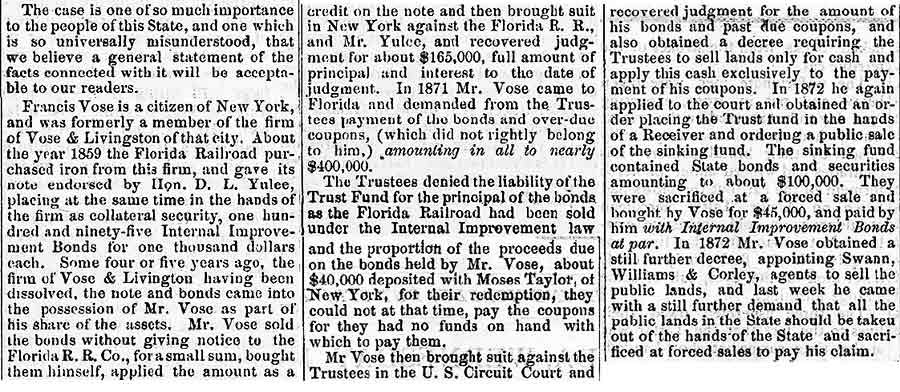
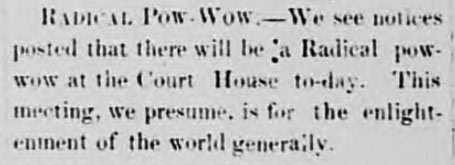





 1871
- Oct. 23 Town of Tampa votes to not incorporate
1871
- Oct. 23 Town of Tampa votes to not incorporate

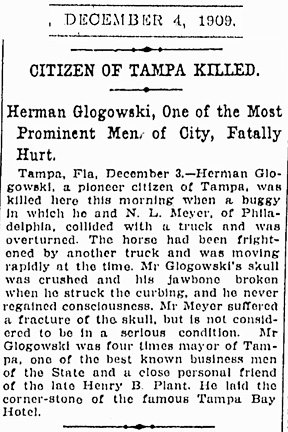 1873
- Aug. 11 to Jul. 15 - Mayors during the Town of Tampa
years
1873
- Aug. 11 to Jul. 15 - Mayors during the Town of Tampa
years




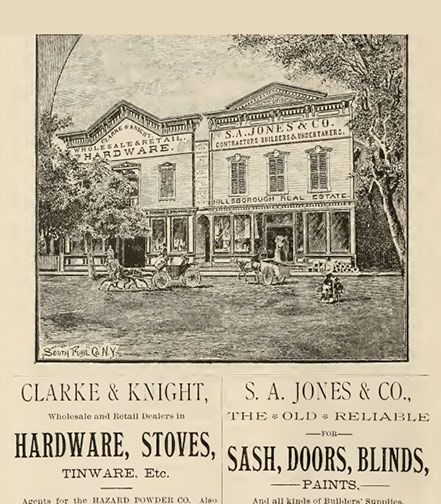



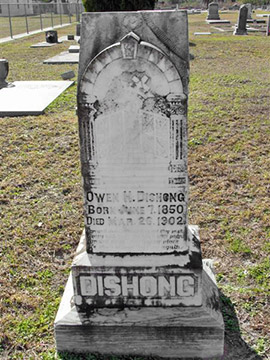

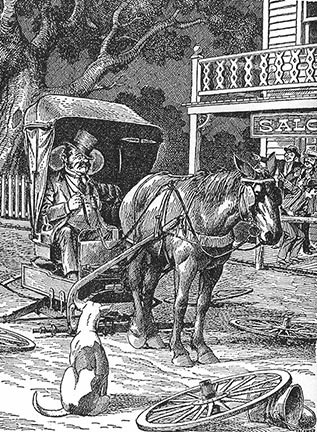

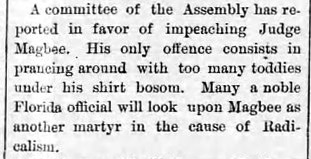

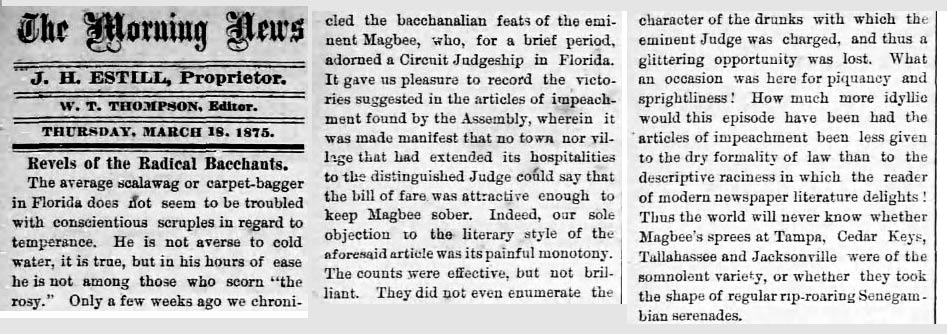
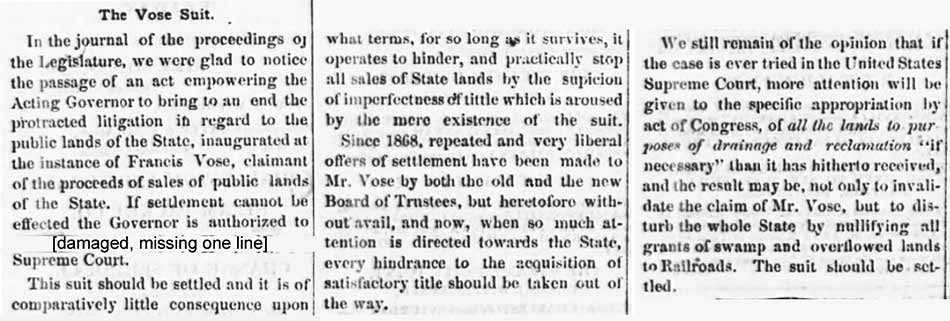

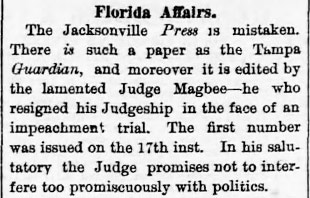
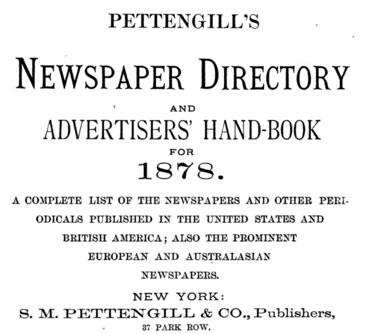
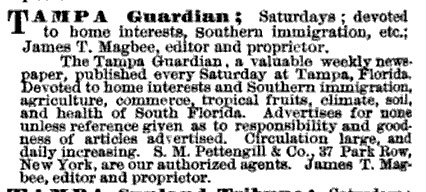













 William
"Billy" Washington Wall, a son of Judge Perry
Green Wall, was a well-respected Tampa
businessman. His death in 1878 was considered a serious
calamity by all of Tampa. In 1884, Billy's mercantile
business was resurrected. Henry Laurens Knight, a son-in-law
of Billy Wall, formed the Knight & Wall Company with Billy's
young son, Perry G. Wall, II, who was only 17 at the time.
(Photo below.)
William
"Billy" Washington Wall, a son of Judge Perry
Green Wall, was a well-respected Tampa
businessman. His death in 1878 was considered a serious
calamity by all of Tampa. In 1884, Billy's mercantile
business was resurrected. Henry Laurens Knight, a son-in-law
of Billy Wall, formed the Knight & Wall Company with Billy's
young son, Perry G. Wall, II, who was only 17 at the time.
(Photo below.)




 Occasionally during the 1870s rumors circulated that
the Vose Injunction would be lifted. In 1877 the
possibility seemed so likely that area men met again
in Tampa to organize a line. Called the Tampa, Peace
Creek and St. Johns Railroad, it was intended to
connect Tampa and Jacksonville. The road was
chartered, and surveys were conducted. Soon its name
was changed to the Jacksonville, Tampa & Key West
Railway, and William Van Fleet was named as its
president. For the moment, though, no construction was
undertaken. Meanwhile, 1879 two rival lines were
chartered. One eventually was known as the Florida
Southern Railroad, and it also enjoyed the support of
south Florida's increasingly wealthy cattle interests.
The second was the South Florida Railroad Company,
which proposed a line from the St. Johns River to
Tampa or Charlotte Harbor.
Occasionally during the 1870s rumors circulated that
the Vose Injunction would be lifted. In 1877 the
possibility seemed so likely that area men met again
in Tampa to organize a line. Called the Tampa, Peace
Creek and St. Johns Railroad, it was intended to
connect Tampa and Jacksonville. The road was
chartered, and surveys were conducted. Soon its name
was changed to the Jacksonville, Tampa & Key West
Railway, and William Van Fleet was named as its
president. For the moment, though, no construction was
undertaken. Meanwhile, 1879 two rival lines were
chartered. One eventually was known as the Florida
Southern Railroad, and it also enjoyed the support of
south Florida's increasingly wealthy cattle interests.
The second was the South Florida Railroad Company,
which proposed a line from the St. Johns River to
Tampa or Charlotte Harbor. 
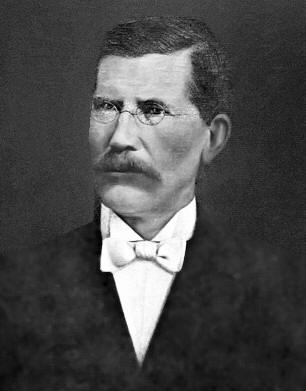
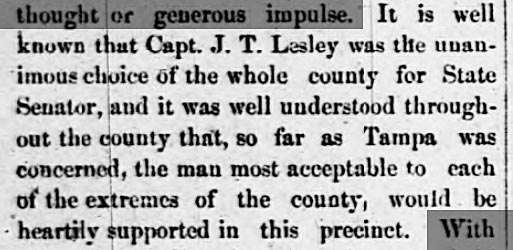
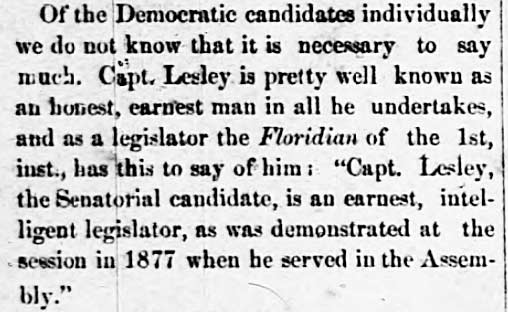
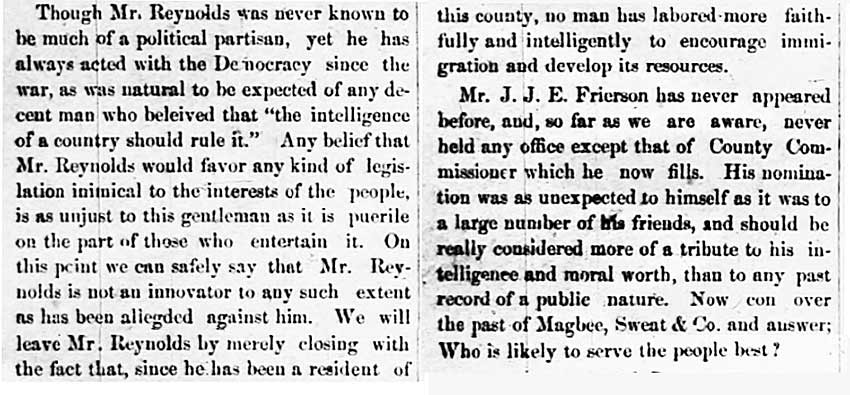
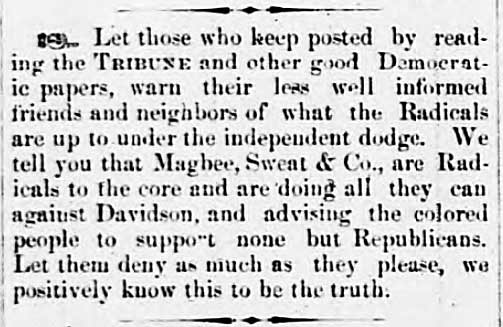
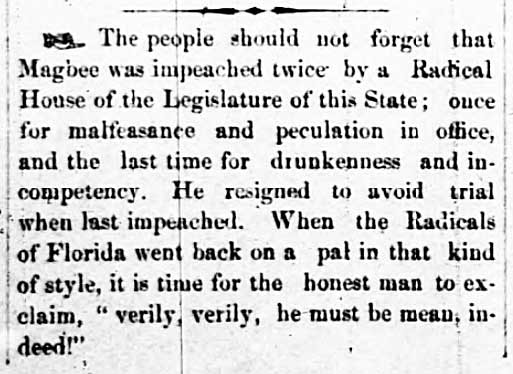
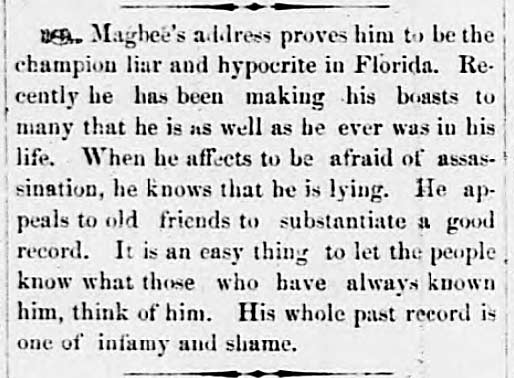
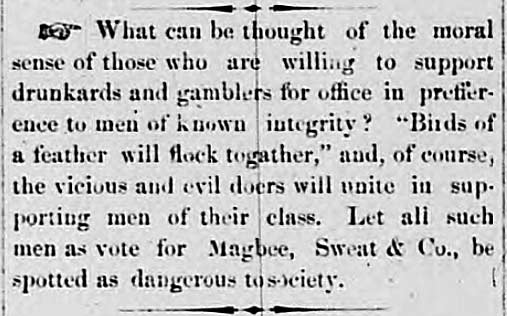








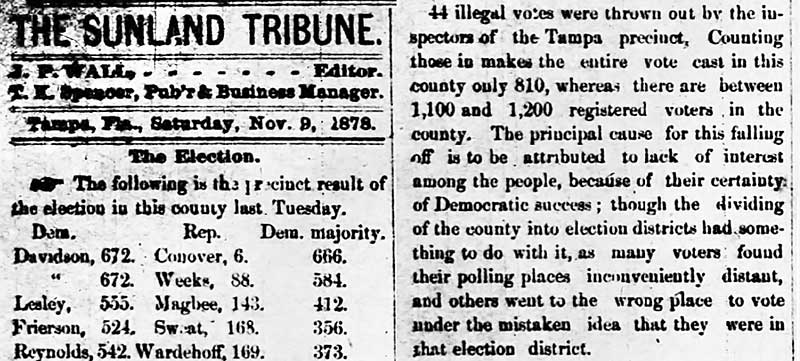
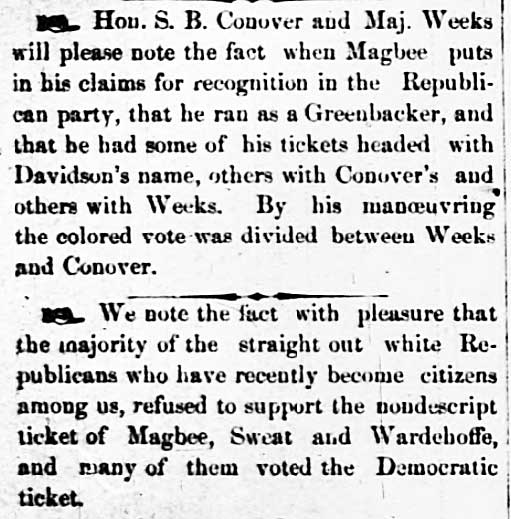
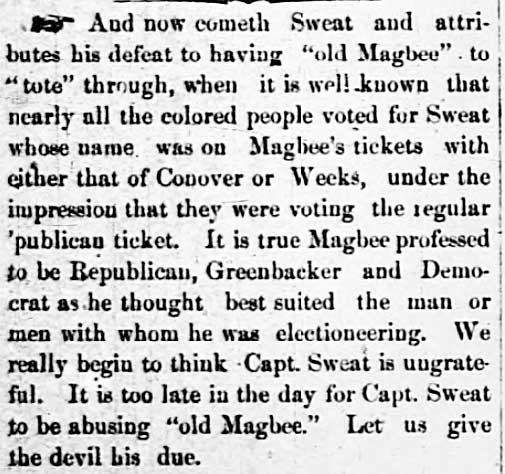












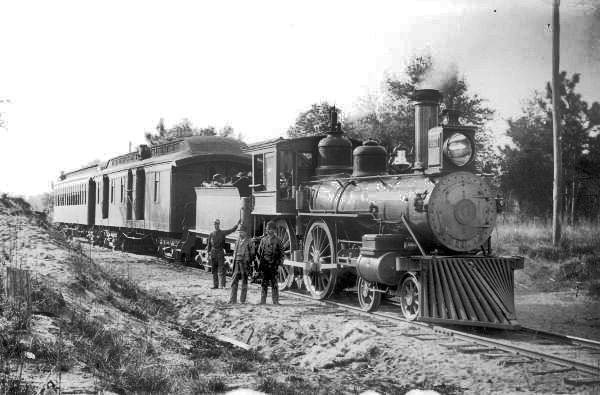
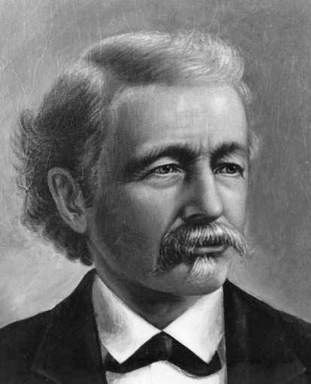
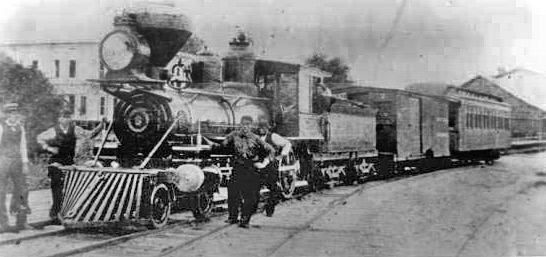









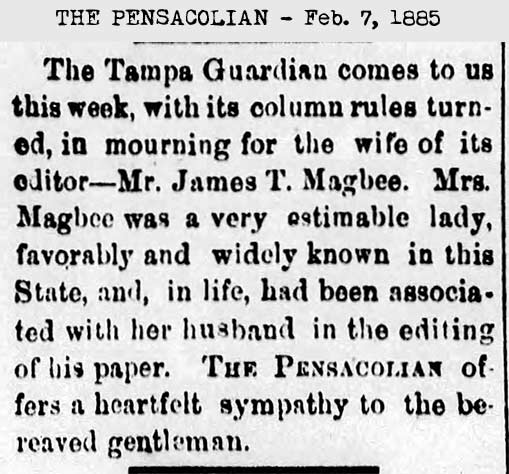
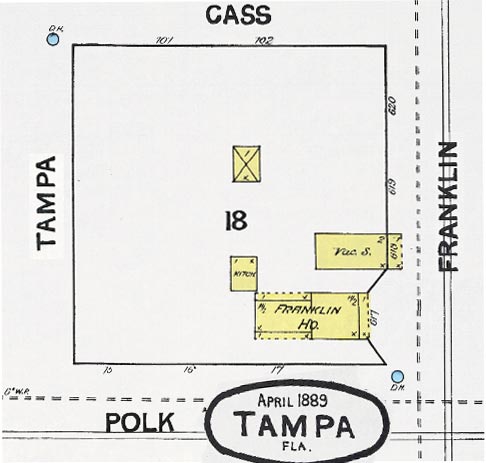










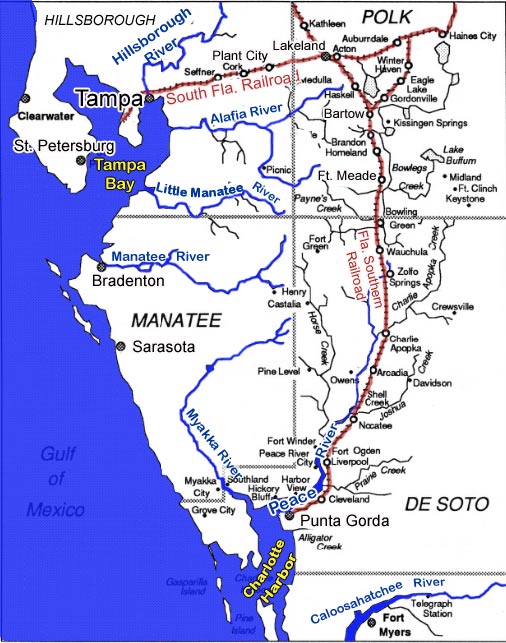
















 Signed sealed and delivered in the presence of
us her subscribing witnesses
Signed sealed and delivered in the presence of
us her subscribing witnesses 


 VANLANDINGHAM,
Kyle Samuel, 57, who was a historian and genealogist, died
November 17, 2009, in a Denver hospital from the H1N1
virus, also known as swine flu. He is survived by his
mother, Jane Ernestine Alderman VanLandingham; and
brother, Larue Pierre VanLandingham and wife, Denise, of
DeFuniak Springs, Fla. He was preceded in death by his
father, Samuel Pierre VanLandingham.
VANLANDINGHAM,
Kyle Samuel, 57, who was a historian and genealogist, died
November 17, 2009, in a Denver hospital from the H1N1
virus, also known as swine flu. He is survived by his
mother, Jane Ernestine Alderman VanLandingham; and
brother, Larue Pierre VanLandingham and wife, Denise, of
DeFuniak Springs, Fla. He was preceded in death by his
father, Samuel Pierre VanLandingham.